60+ Moments in the History of Stanford Law School
Slides: 60+ Moments
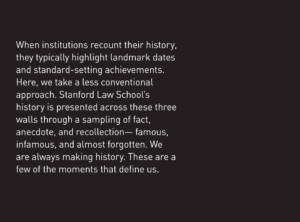
When institutions recount their history, they typically highlight landmark dates and standard-setting achievements. Here, we take a less conventional approach. Stanford Law School’s history is presented across these three walls through a sampling of fact, anecdote, and recollection— famous, infamous, and almost forgotten. We are always making history. These are a few of the moments that define us.
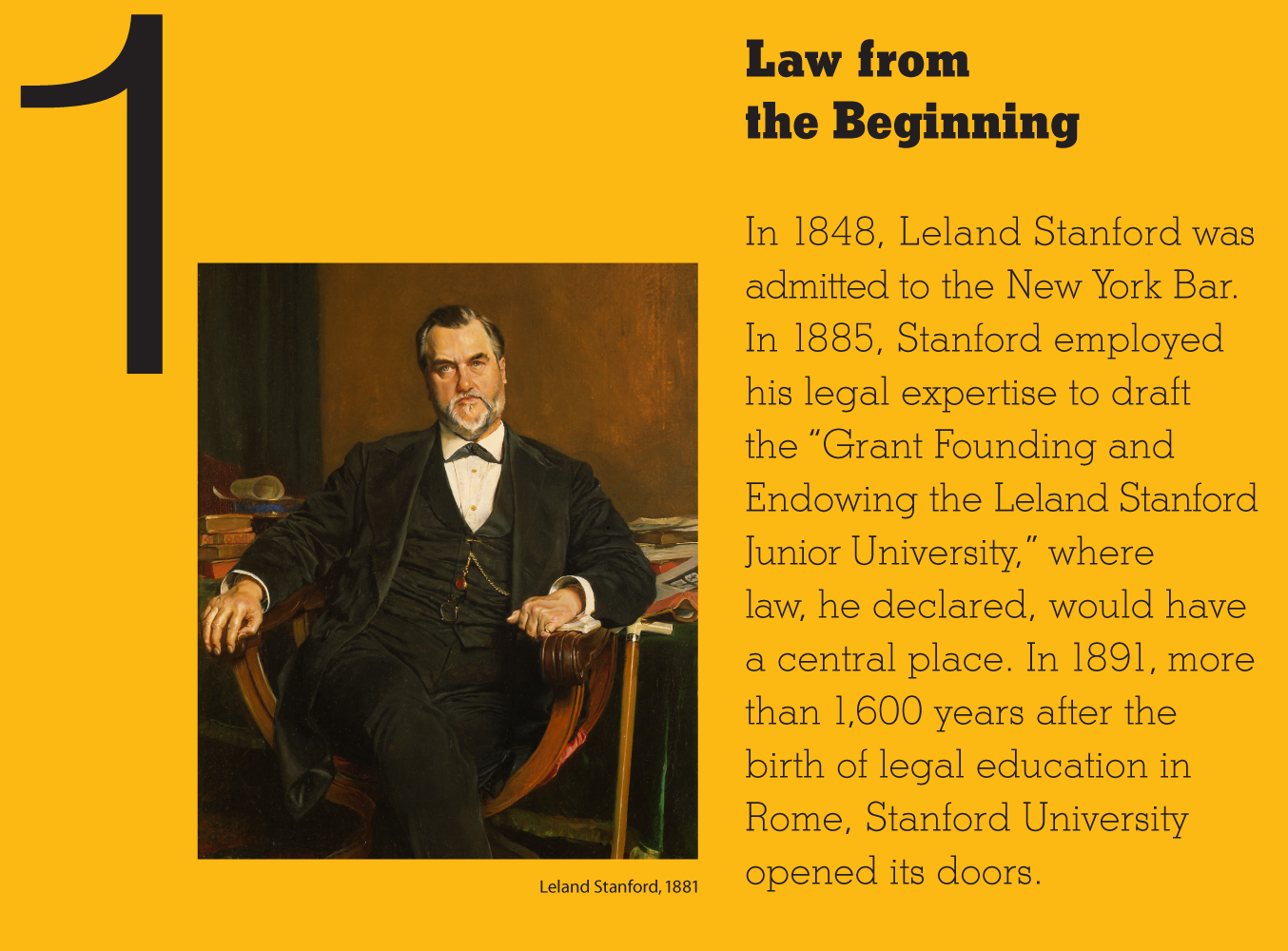
Law from the Beginning
In 1848, Leland Stanford was admitted to the New York Bar. In 1885, Stanford employed his legal expertise to draft the “Grant Founding and Endowing the Leland Stanford Junior University,” where law, he declared, would have a central place. In 1891, more than 1,600 years after the birth of legal education in Rome, Stanford University opened its doors.
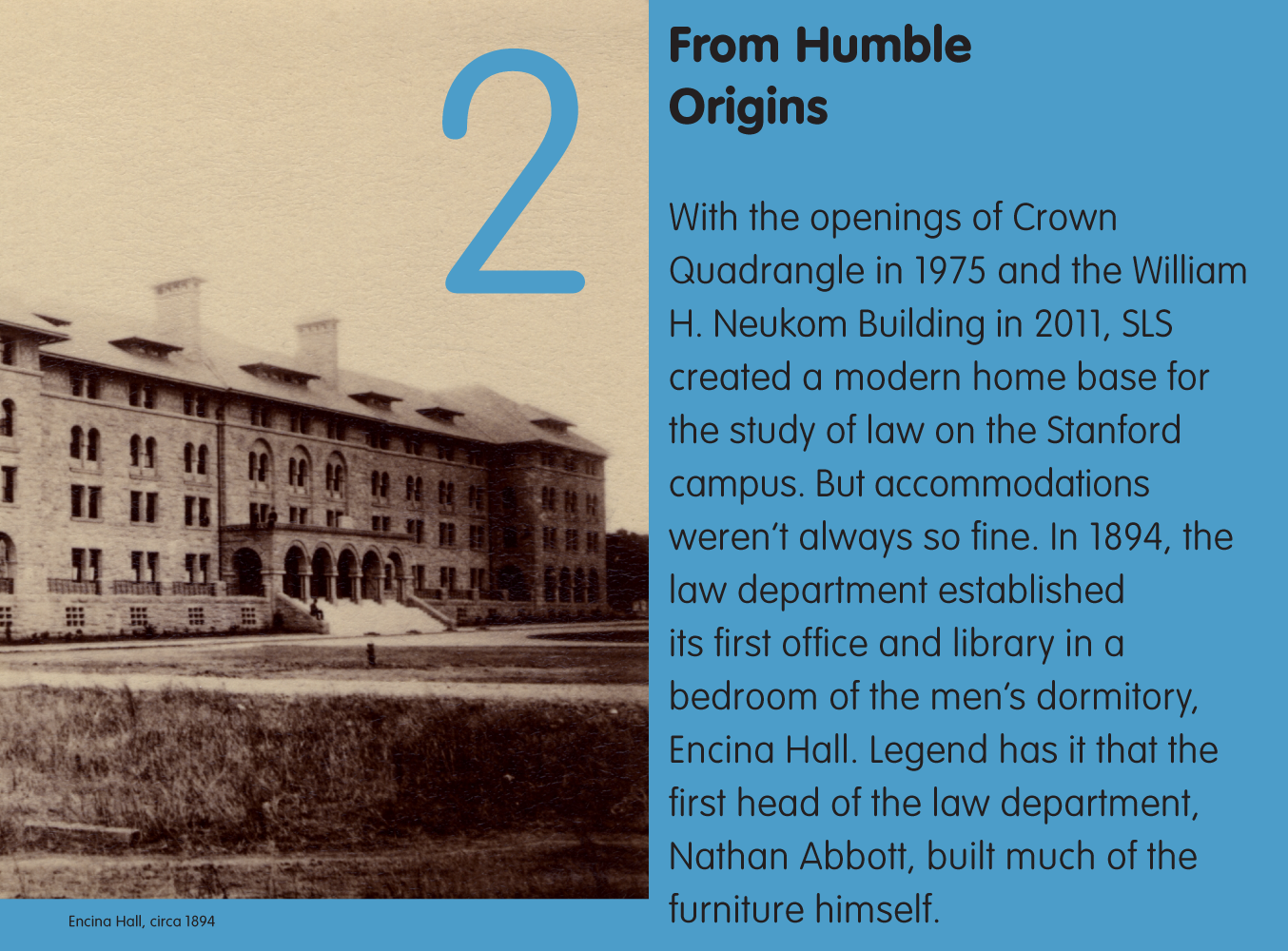
From Humble Origins
With the openings of Crown Quadrangle in 1975 and the William H. Neukom Building in 2011, SLS created a modern home base for the study of law on the Stanford campus. But accommodations weren't always so fine. In 1894, the law department established its first office and library in a bedroom of the men’s dormitory, Encina Hall. Legend has it that the first head of the law department, Nathan Abbott, built much of the furniture himself.
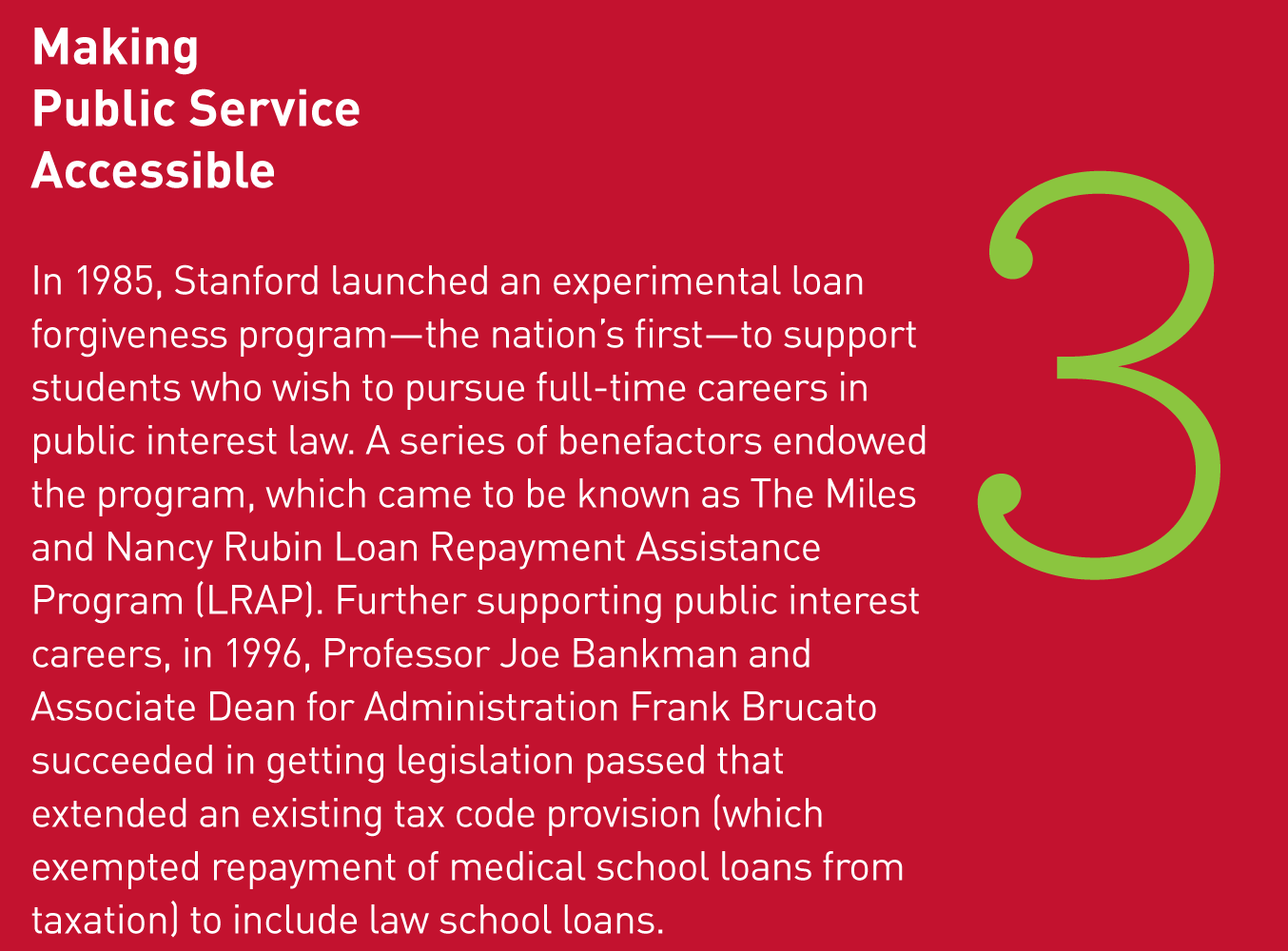
Making Public Service Accessible
In 1985, Stanford launched an experimental loan forgiveness program—the nation’s first—to support students who wish to pursue full-time careers in public interest law. A series of benefactors endowed the program, which came to be known as The Miles and Nancy Rubin Loan Repayment Assistance Program (LRAP). Further supporting public interest careers, in 1996, Professor Joe Bankman and Associate Dean for Administration Frank Brucato succeeded in getting legislation passed that extended an existing tax code provision (which exempted repayment of medical school loans from taxation) to include law school loans.
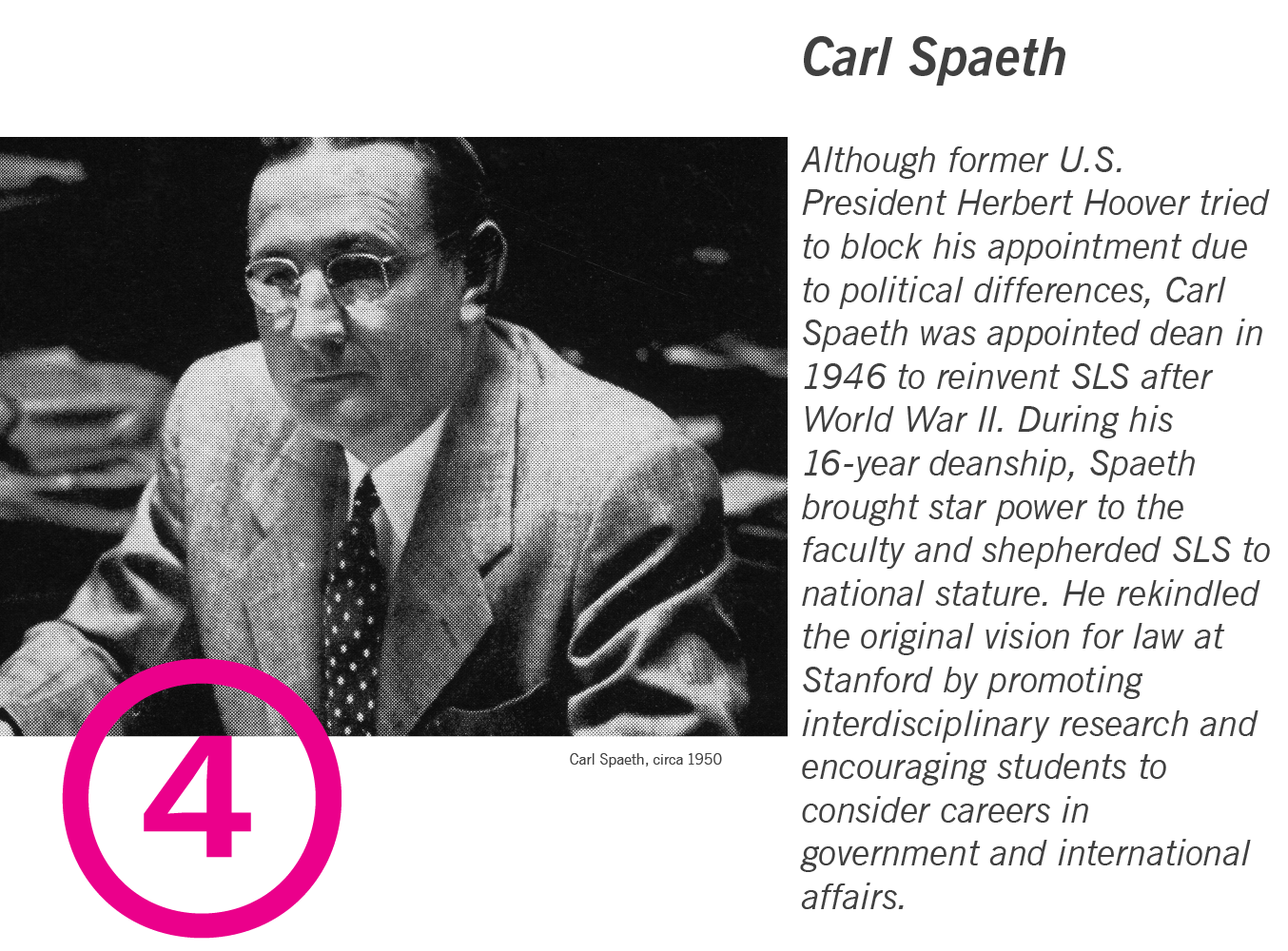
Carl Spaeth
Although former U.S. President Herbert Hoover tried to block his appointment due to political differences, Carl Spaeth was appointed dean in 1946 to reinvent SLS after World War II. During his 16-year deanship, Spaeth brought star power to the faculty and shepherded SLS to national stature. He rekindled the original vision for law at Stanford by promoting interdisciplinary research and encouraging students to consider careers in government and international affairs.
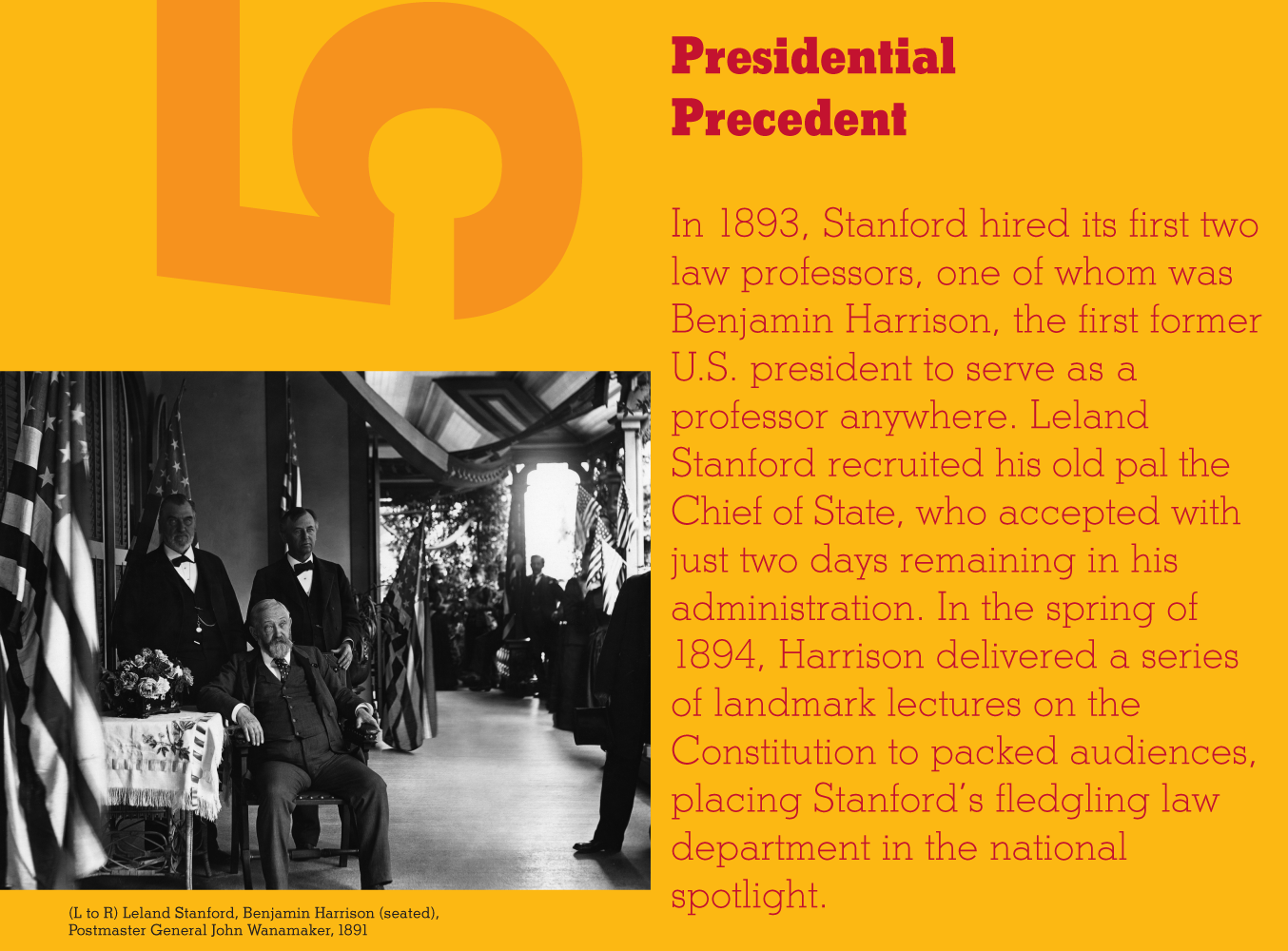
Presidential Precedent
In 1893, Stanford hired its first two law professors, one of whom was Benjamin Harrison, the first former U.S. president to serve as a professor anywhere. Leland Stanford recruited his old pal the Chief of State, who accepted with just two days remaining in his administration. In the spring of 1894, Harrison delivered a series of landmark lectures on the Constitution to packed audiences, placing Stanford’s fledgling law department in the national spotlight.
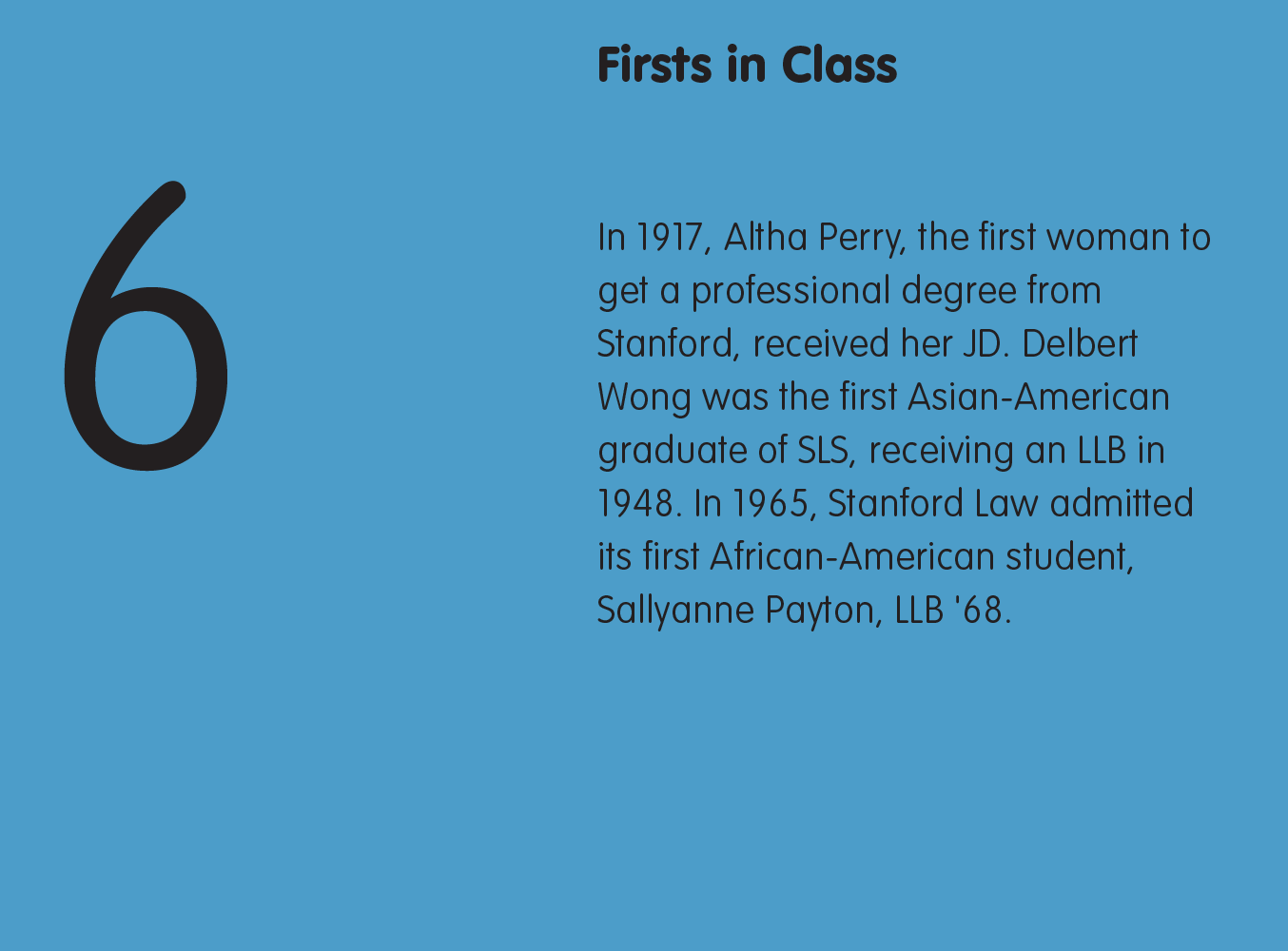
Firsts in Class
In 1917, Altha Perry, the first woman to get a professional degree from Stanford, received her JD. Delbert Wong was the first Asian-American graduate of SLS, receiving an LLB in 1948. In 1965, Stanford Law admitted its first African-American student, Sallyanne Payton, LLB '68.
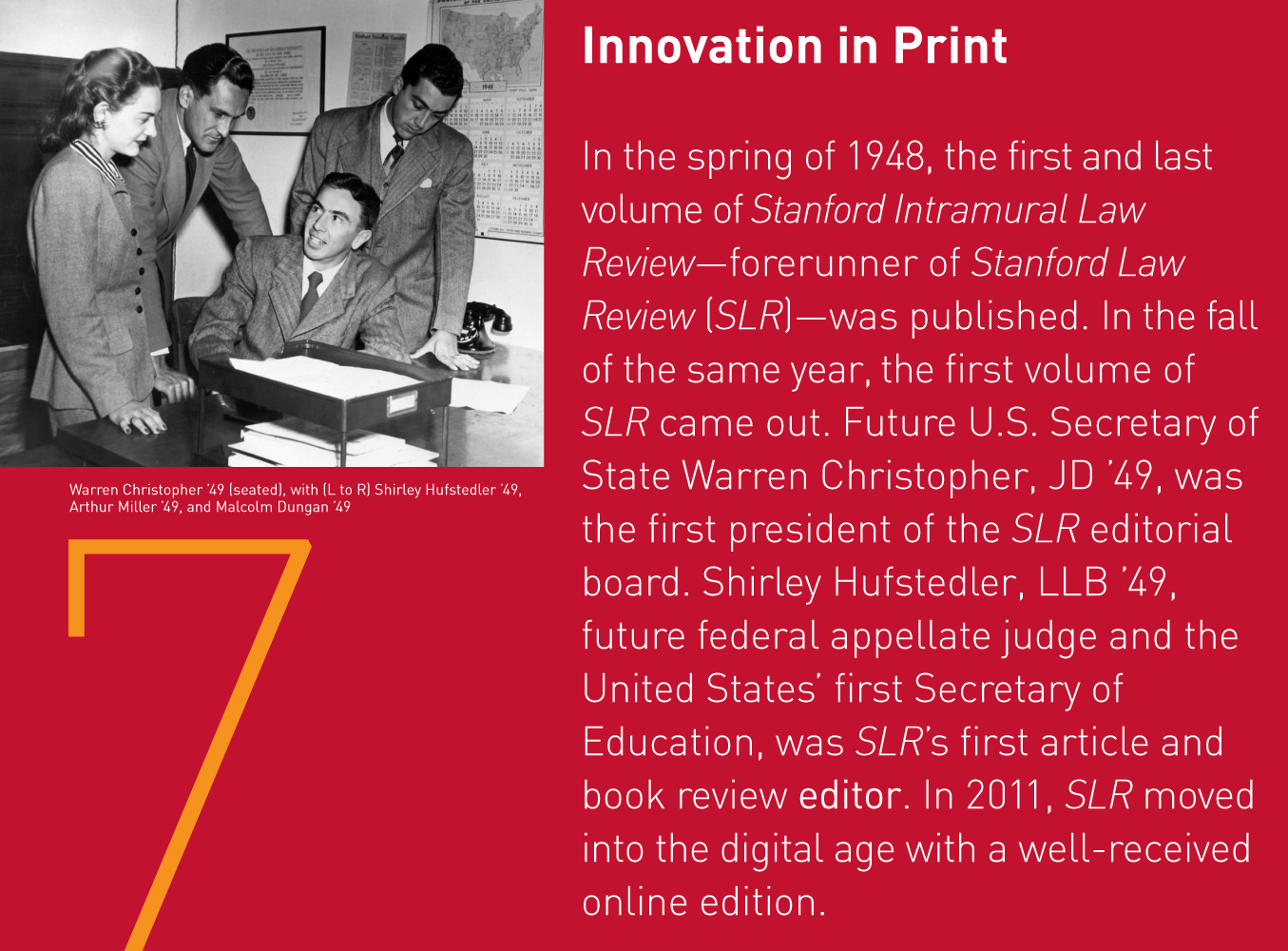
Innovation in Print
In the spring of 1948, the first and last volume of Stanford Intramural Law Review—forerunner of Stanford Law Review (SLR)—was published. In the fall of the same year, the first volume of SLR came out. FutureU.S. Secretary of State Warren Christopher, JD ’49, was the first president of the SLR editorial board. Shirley Hufstedler, LLB ‘49, future federal appellate judge and the United States’ first Secretary of Education, was SLR’s first article and book review editor. In 2011,SLR moved into the digital age with a well-received online edition.
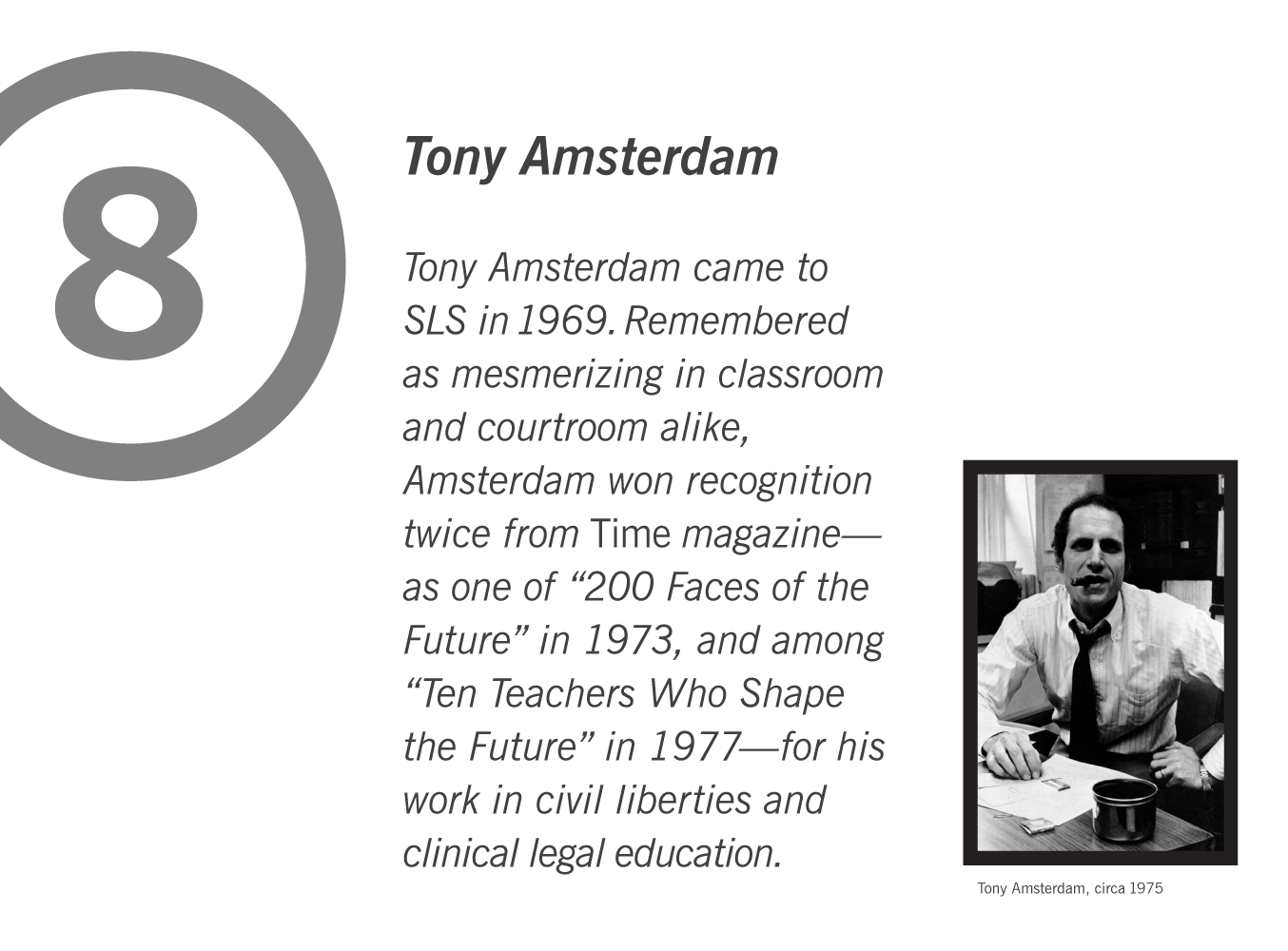
Tony Amsterdam
Tony Amsterdam came to SLS in 1969. Remembered as mesmerizing in classroom and courtroom alike, Amsterdam won recognition twice from Time magazine—as one of “200 Faces of the Future” in 1973, and among “Ten Teachers Who Shape the Future” in 1977—for his work in civil liberties and clinical legal education.
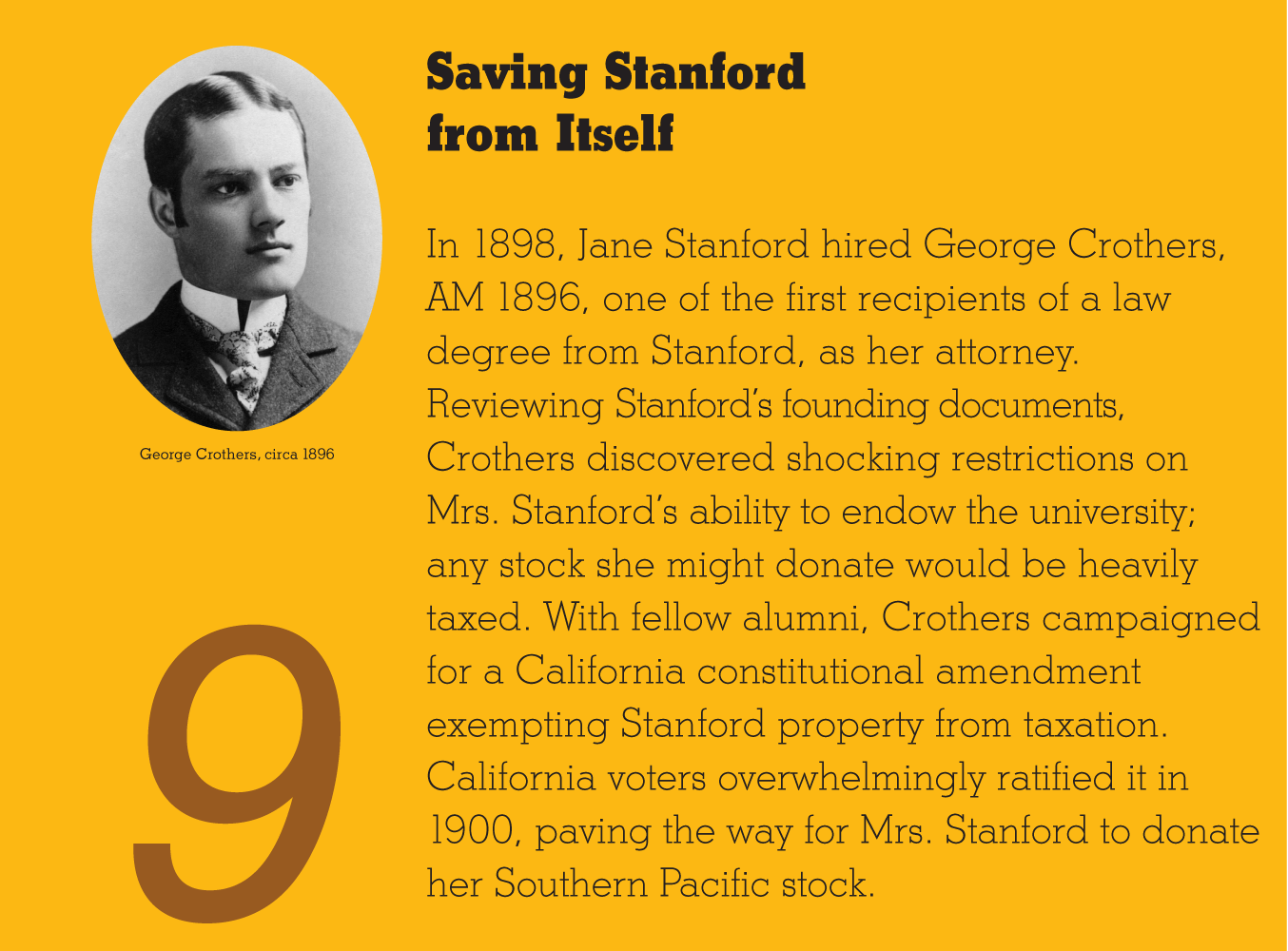
Saving Stanford from Itself
In 1898, Jane Stanford hired George Crothers, AM 1896, one of the first recipients of a law degree from Stanford, as her attorney. Reviewing Stanford’s founding documents, Crothers discovered shocking restrictions on Mrs. Stanford’s ability to endow the university; any stock she might donate would be heavily taxed. With fellow alumni, Crothers campaigned for a California constitutional amendment exempting Stanford property from taxation. California voters overwhelmingly ratified it in 1900, paving the way for Mrs. Stanford to donate her Southern Pacific stock.
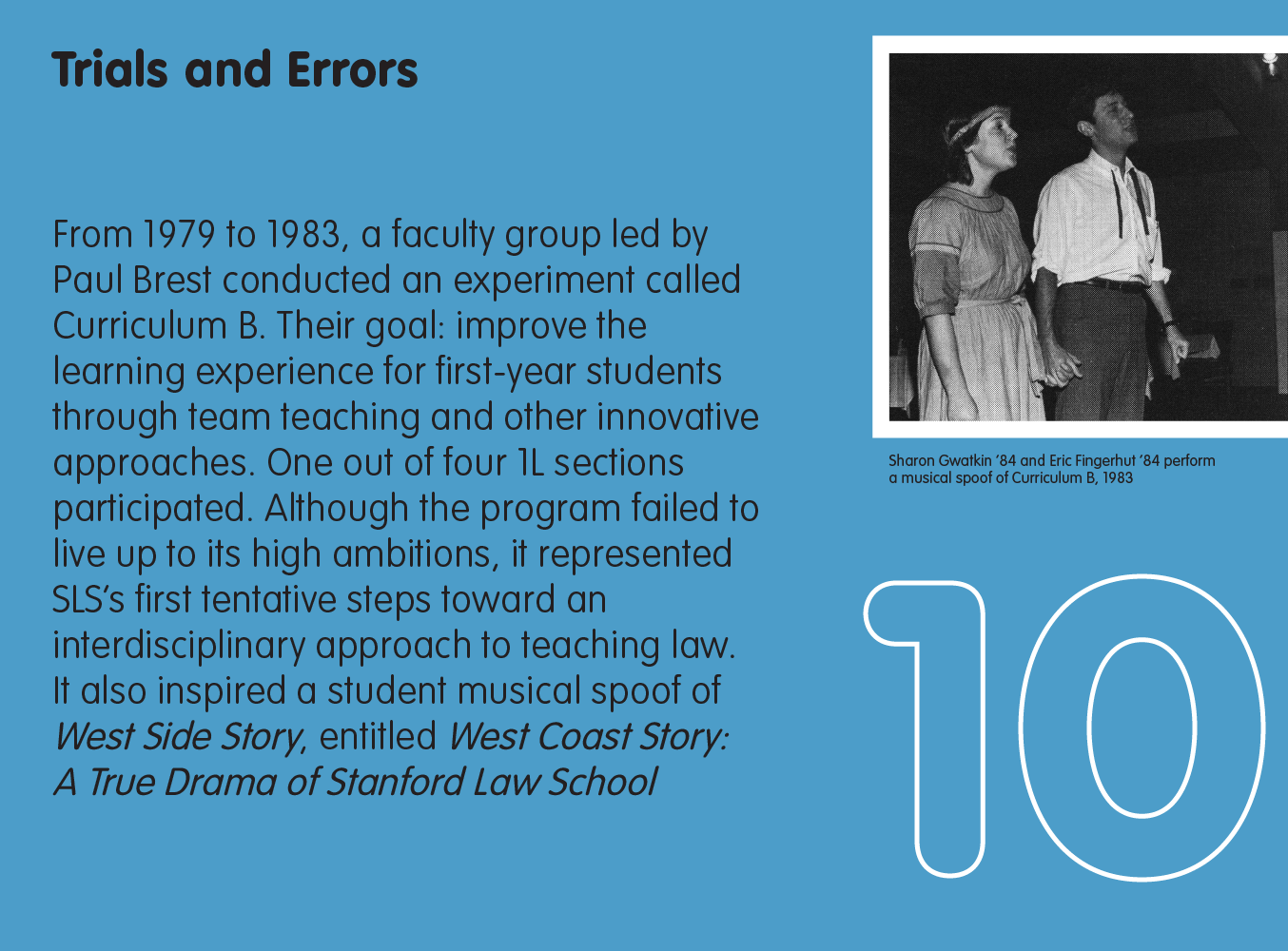
Trials and Errors
From 1979 to 1983, a faculty group led by Paul Brest conducted an experiment called Curriculum B. Their goal: improve the learning experience for first-year students through team teaching and other innovative approaches. One out of four 1L sections participated. Although the program failed to live up to its high ambitions, it represented SLS’s first tentative steps toward an interdisciplinary approach to teaching law. It also inspired a student musical spoof of West Side Story, entitled West Coast Story: A True Drama of Stanford Law School.
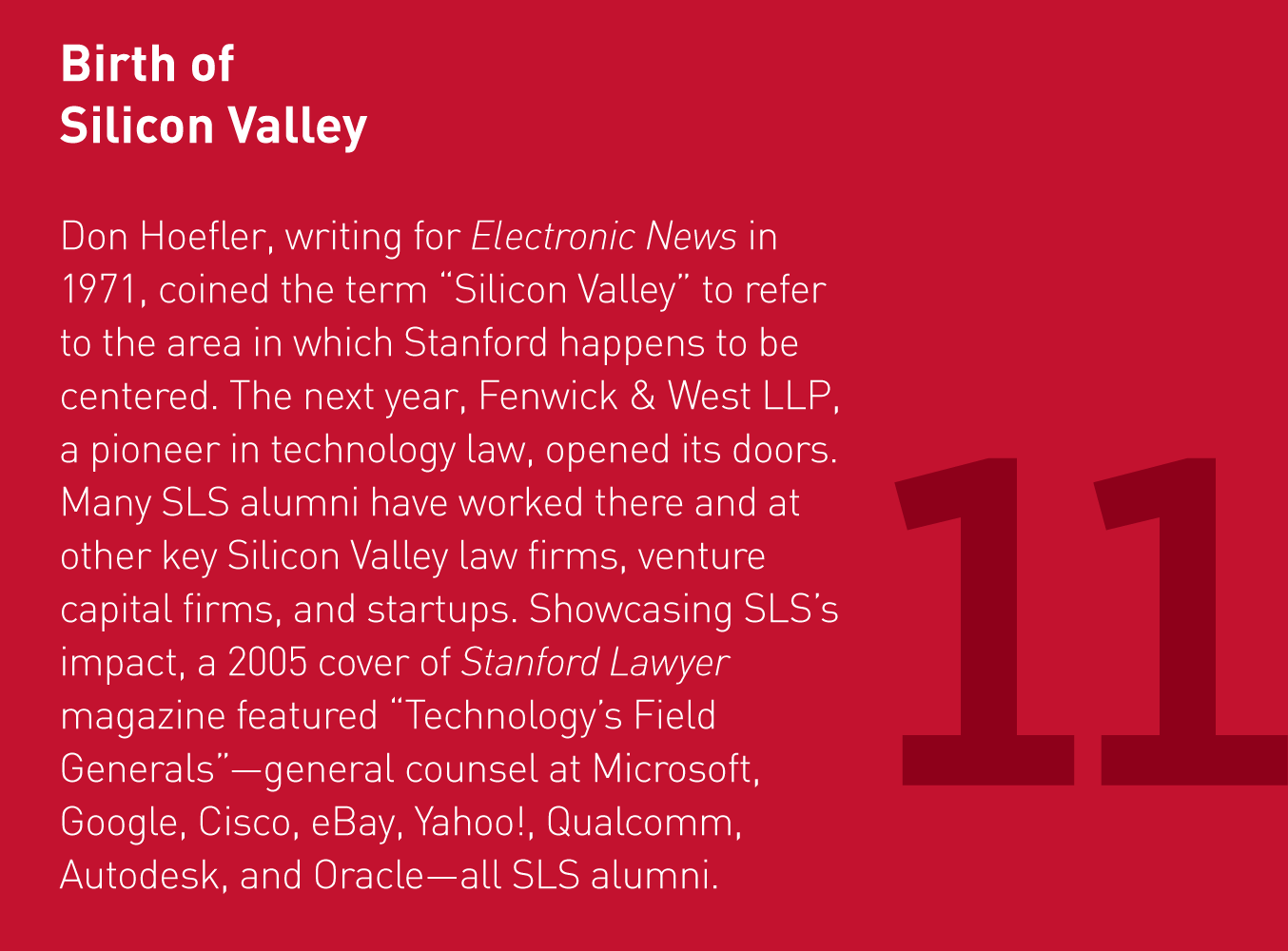
Birth of Silicon Valley
Don Hoefler, writing for Electronic News In 1971, coined the term “Silicon Valley” to refer to the area in which Stanford happens to be centered. The next year, Fenwick & West LLP, a pioneer in technology law, opened its doors. Many SLS alumni have worked there and at other key Silicon Valley law firms, venture capital firms, and startups. Showcasing SLS’s impact, a 2005 cover of Stanford Lawyer Magazine featured “Technology’s Field Generals”—general counsel at Microsoft, Google, Cisco, eBay, Yahoo!, Qualcomm, Autodesk, and Oracle—all SLS alumni.
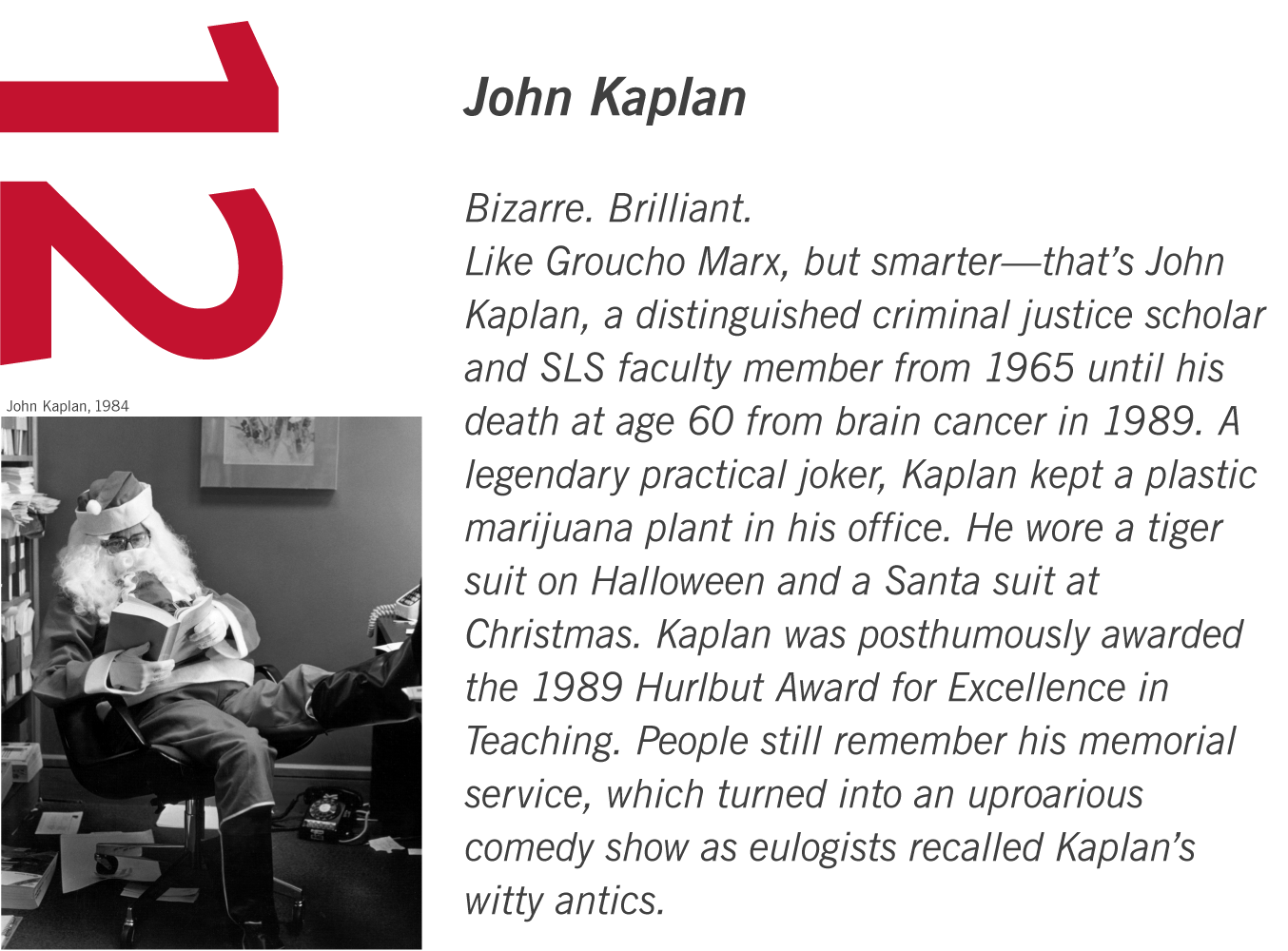
John Kaplan
Bizarre. Brilliant. Like Groucho Marx, but smarter—that’s John Kaplan, a distinguished criminal justice scholar and SLS faculty member from 1965 until his death at age 60 from brain cancer in 1989. A legendary practical joker, Kaplan kept a plastic marijuana plant in his office. He wore a tiger suit on Halloween and a Santa suit at Christmas. Kaplan was posthumously awarded the 1989 Hurlbut Award for Excellence in Teaching. People still remember his memorial service, which turned into an uproarious comedy show as eulogists recalled Kaplan’s witty antics.
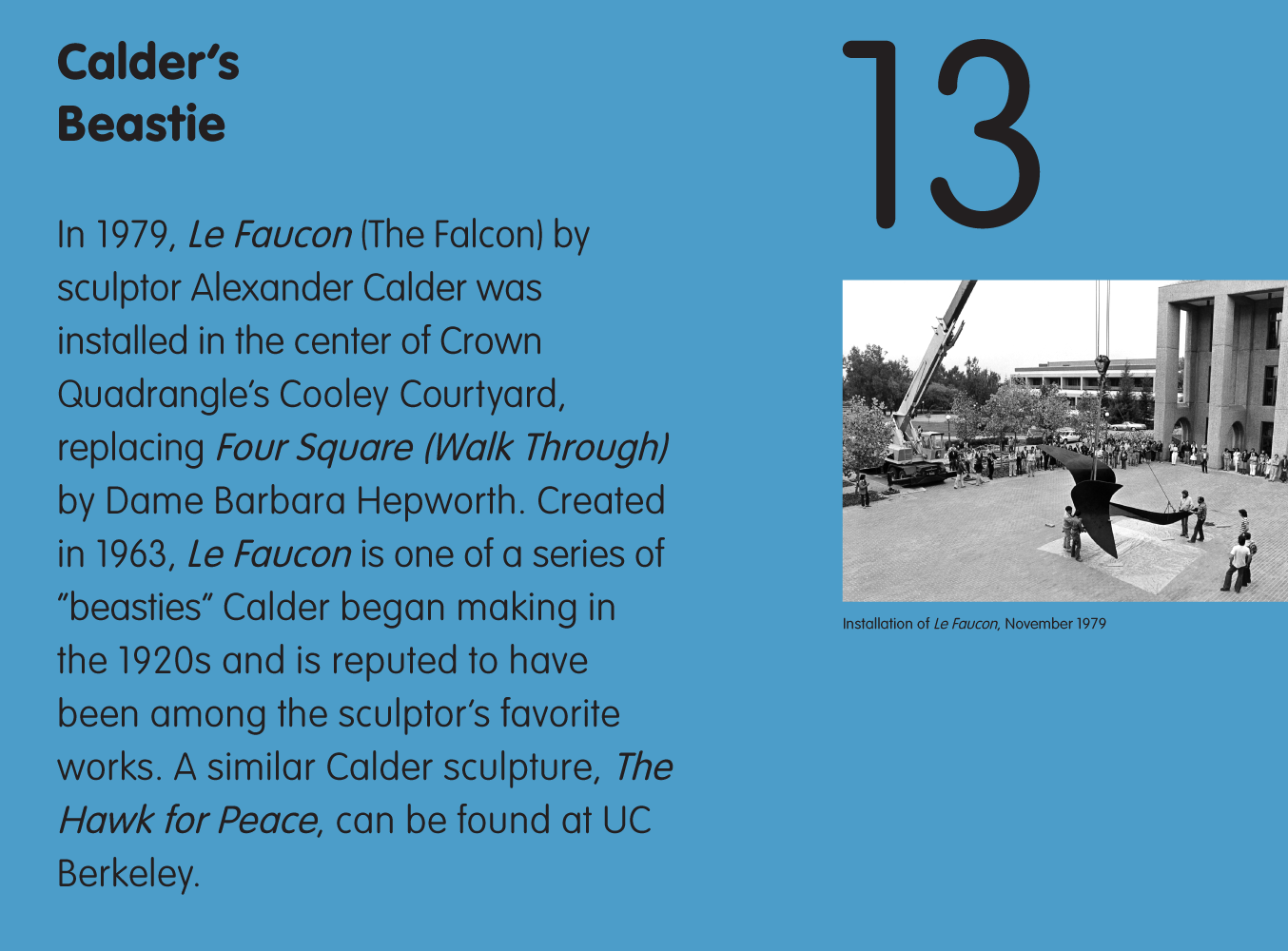
Calder’s Beastie
In 1979, Le Faucon(The Falcon) by sculptor Alexander Calder was installed in the center of Crown Quadrangle’s Cooley Courtyard, replacing Four Square (Walk Through)by Dame Barbara Hepworth. Created in 1963,Le Fauconis one of a series of “beasties” Calder began making in the 1920s and is reputed to have been among the sculptor’s favorite works. A similar Calder sculpture,The Hawk for Peace, can be found at UC Berkeley.
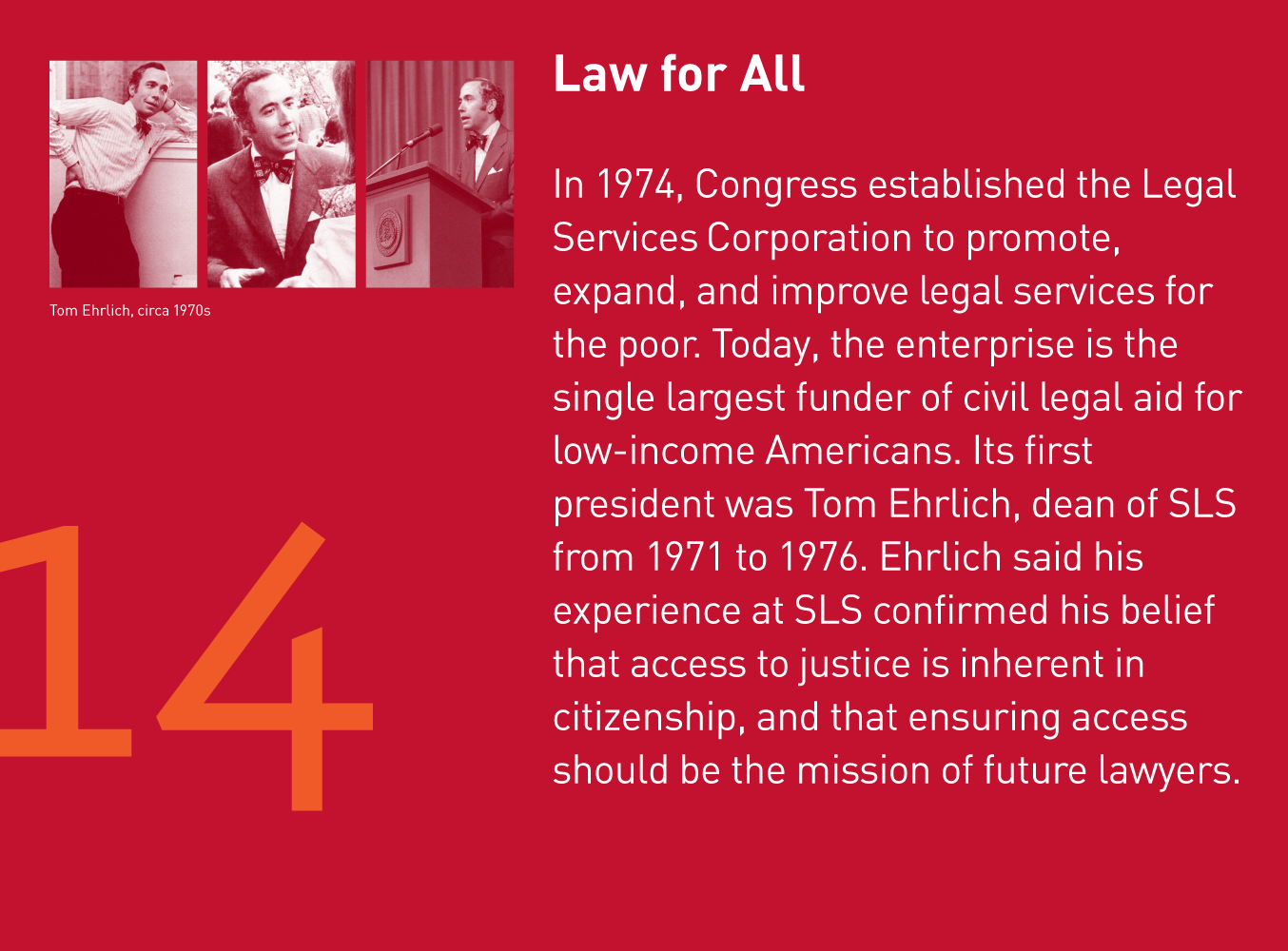
Law for All
In 1974, Congress established the Legal Services Corporation to promote, expand, and improve legal services for the poor. Today, the enterprise is the single largest funder of civil legal aid for low-income Americans. Its first president was Tom Ehrlich, dean of SLS from 1971 to 1976. Ehrlich said his experience at SLS confirmed his belief that access to justice is inherent in citizenship, and that ensuring access should be the mission of future lawyers.
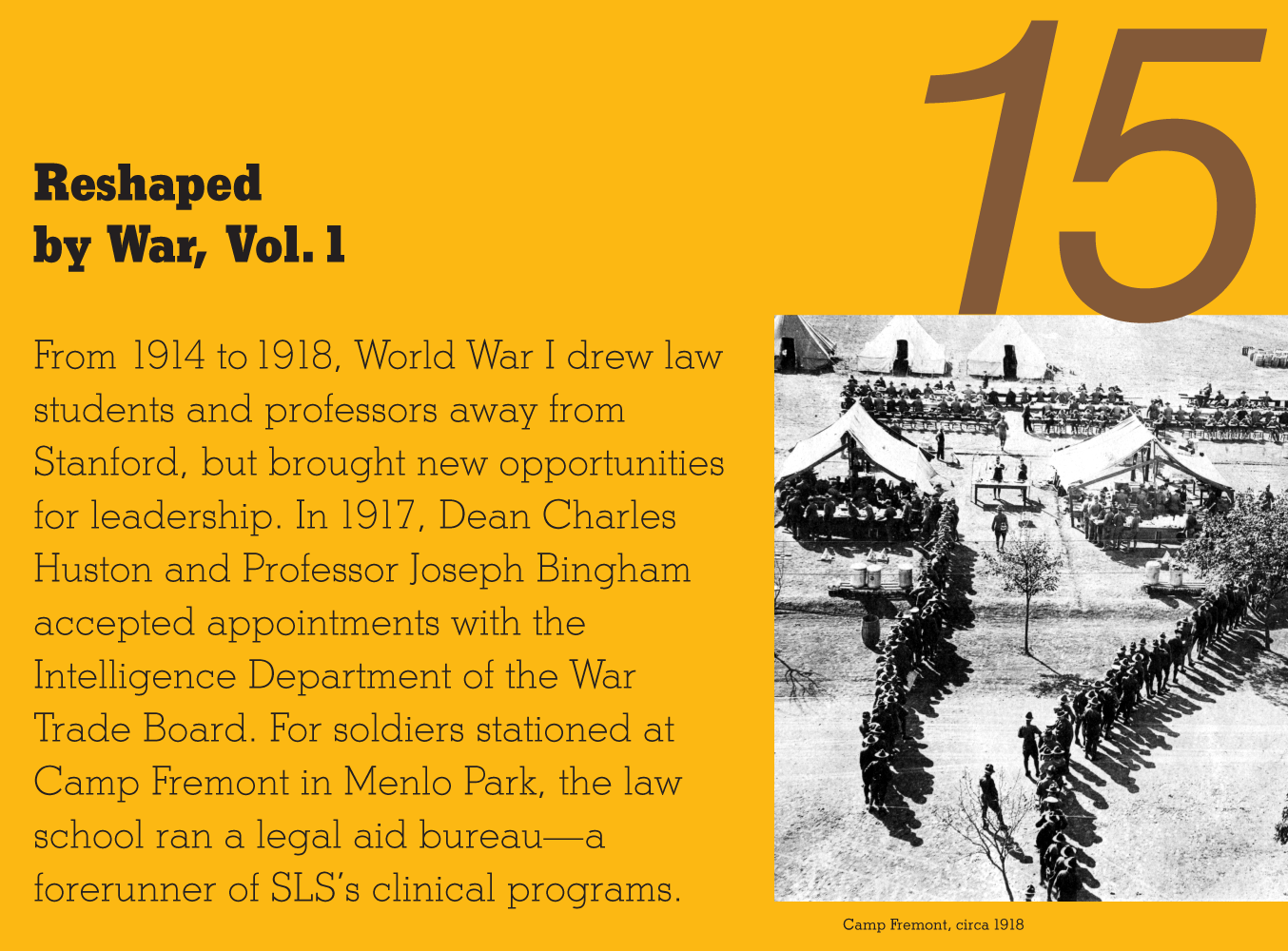
Reshaped by War, Vol. 1
From 1914 to 1918, World War I drew law students and professors away from Stanford, but brought new opportunities for leadership. In 1917, Dean Charles Huston and Professor Joseph Bingham accepted appointments with the Intelligence Department of the War Trade Board. For soldiers stationed at Camp Fremont in Menlo Park, the law school ran a legal aid bureau—a forerunner of SLS’s clinical programs.
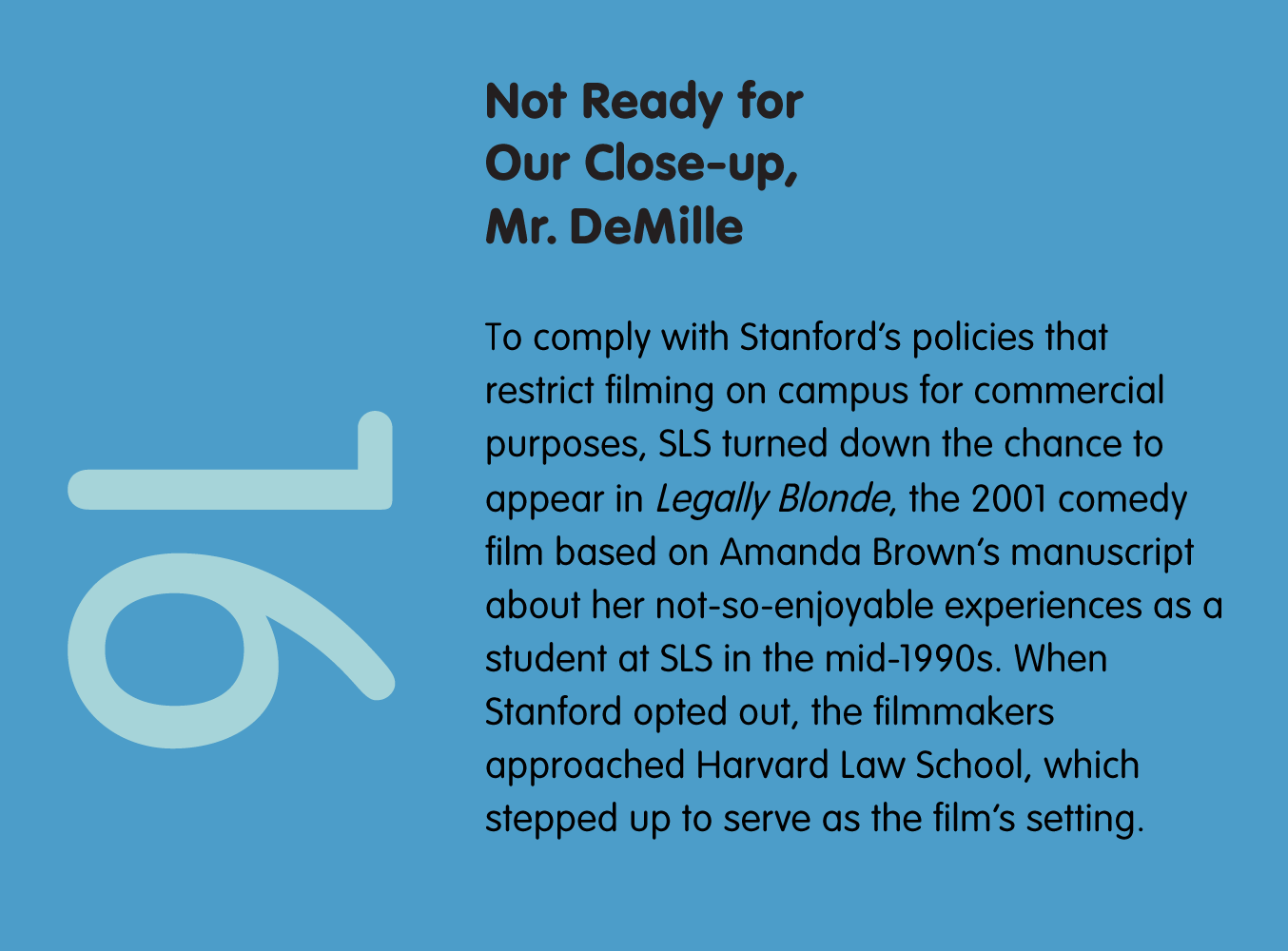
Not Ready for Our Close-up, Mr. DeMille
To comply with Stanford’s policies that restrict filming on campus for commercial purposes, SLS turned down the chance to appear in Legally Blonde, the 2001 comedy film based on Amanda Brown’s manuscript about her not-so-enjoyable experiences as a student at SLS in the mid-1990s. When Stanford opted out, the filmmakers approached Harvard Law School, which stepped up to serve as the film’s setting.
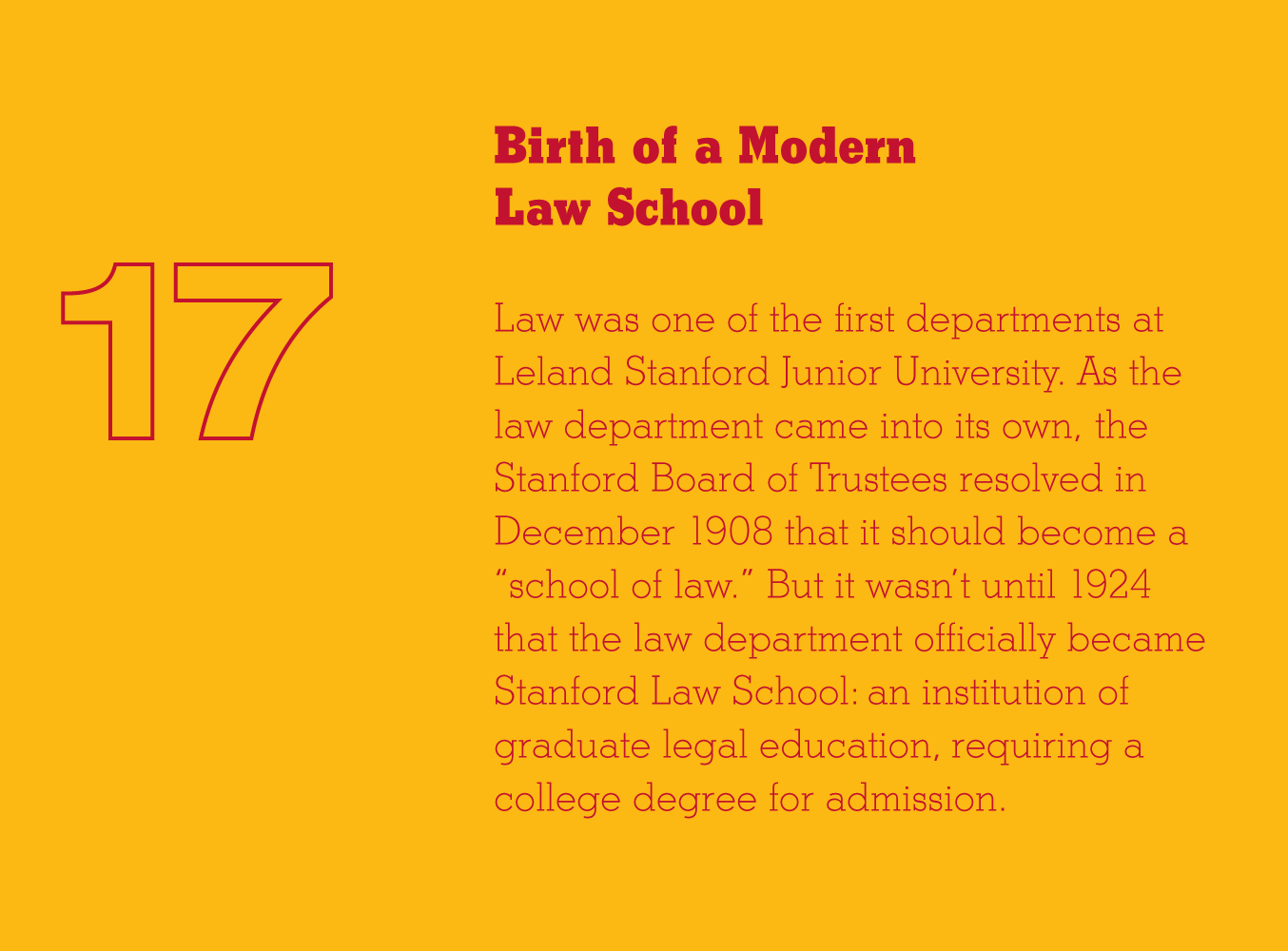
Birth of a Modern Law School
Law was one of the first departments at Leland Stanford Junior University. As the law department came into its own, the Stanford Board of Trustees resolved in December 1908 that it should become a “school of law.” But it wasn't until 1924 that the law department officially became Stanford Law School: an institution of graduate legal education, requiring a college degree for admission.
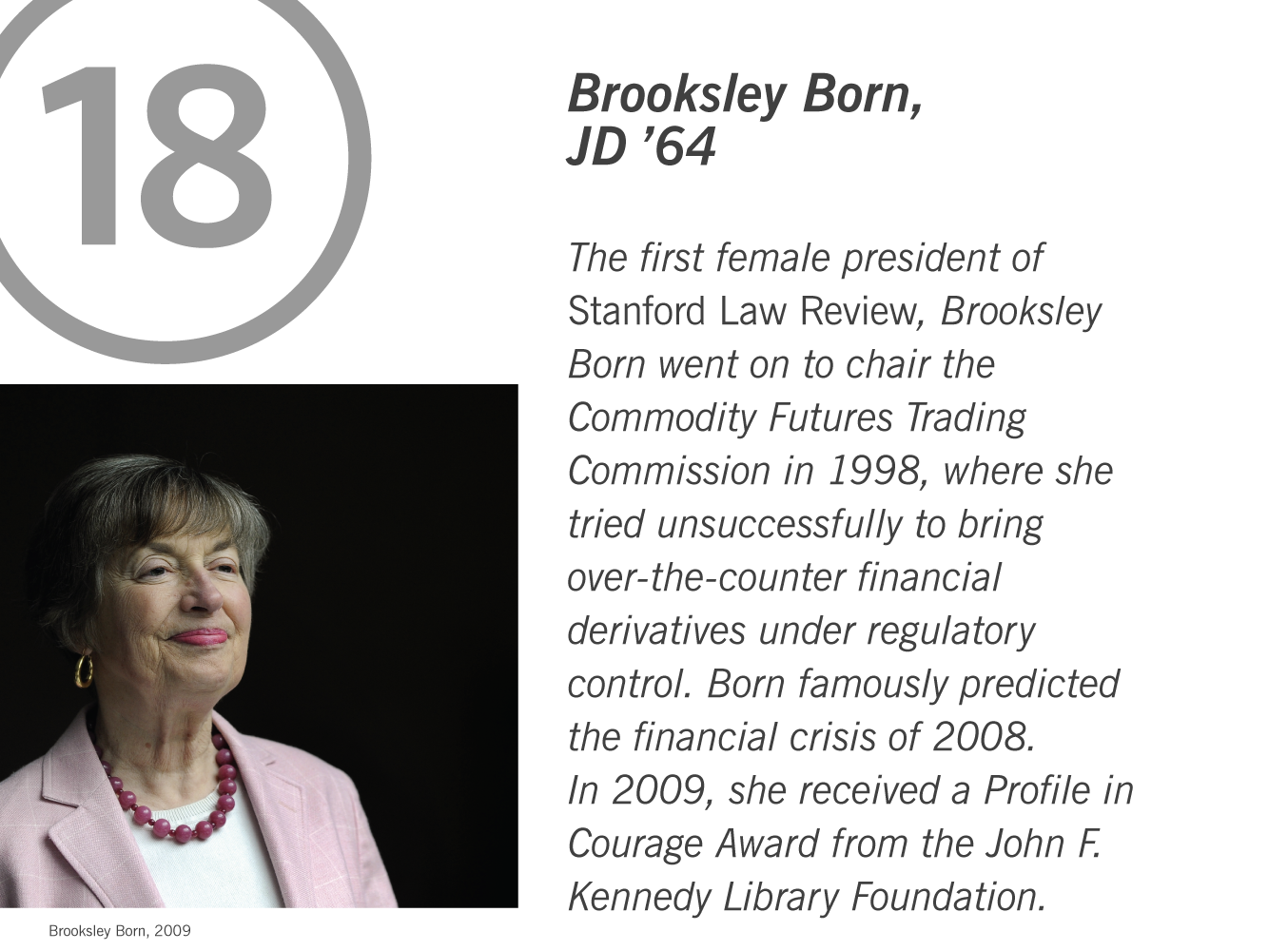
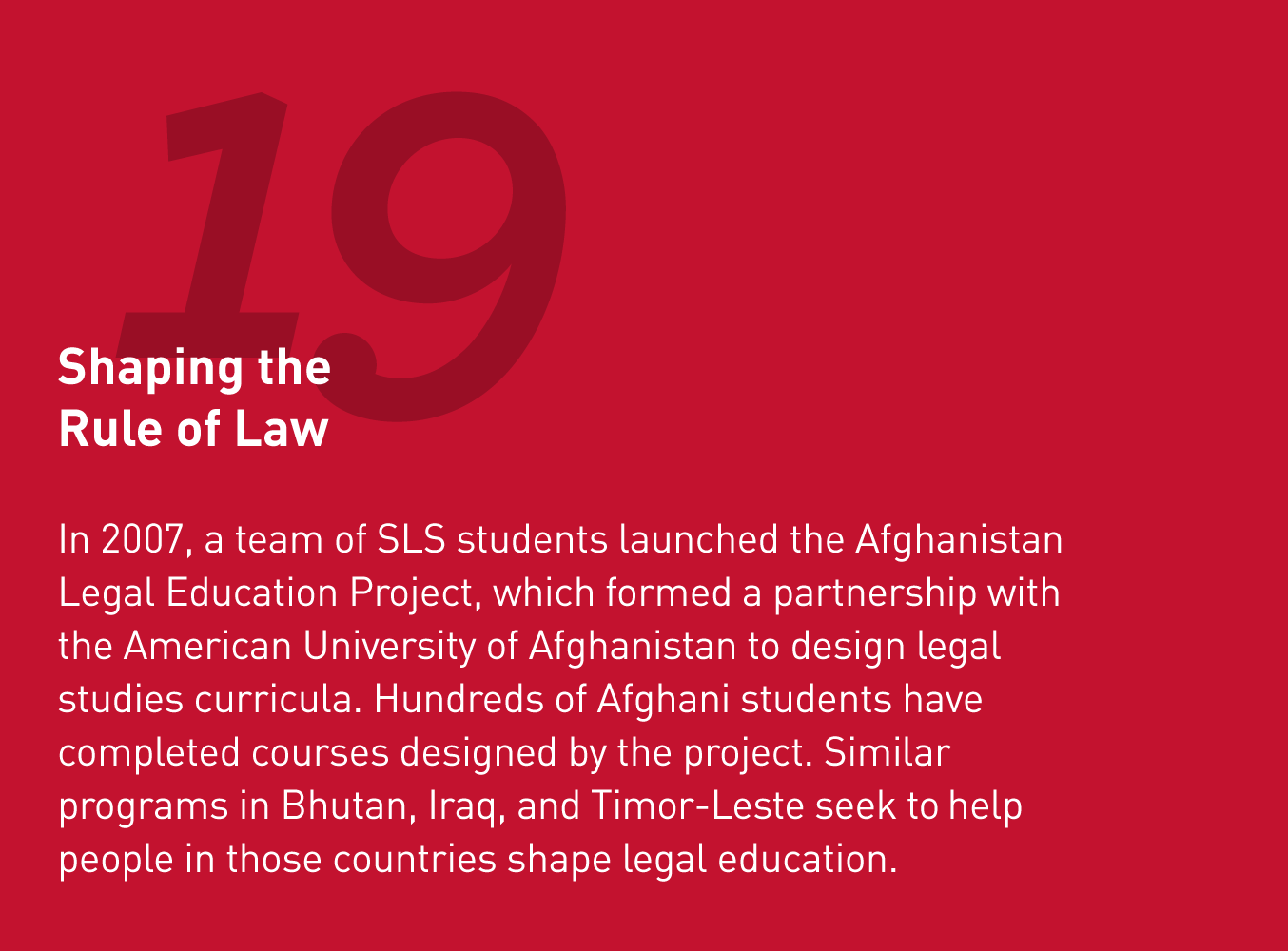
Shaping the Rule of Law
In 2007, a team of SLS students launched the Afghanistan Legal Education Project, which formed a partnership with the American University of Afghanistan to design legal studies curricula. Hundreds of Afghani students have completed courses designed by the project. Similar programs in Bhutan, Iraq, and Timor-Leste seek to help people in those countries shape legal education.
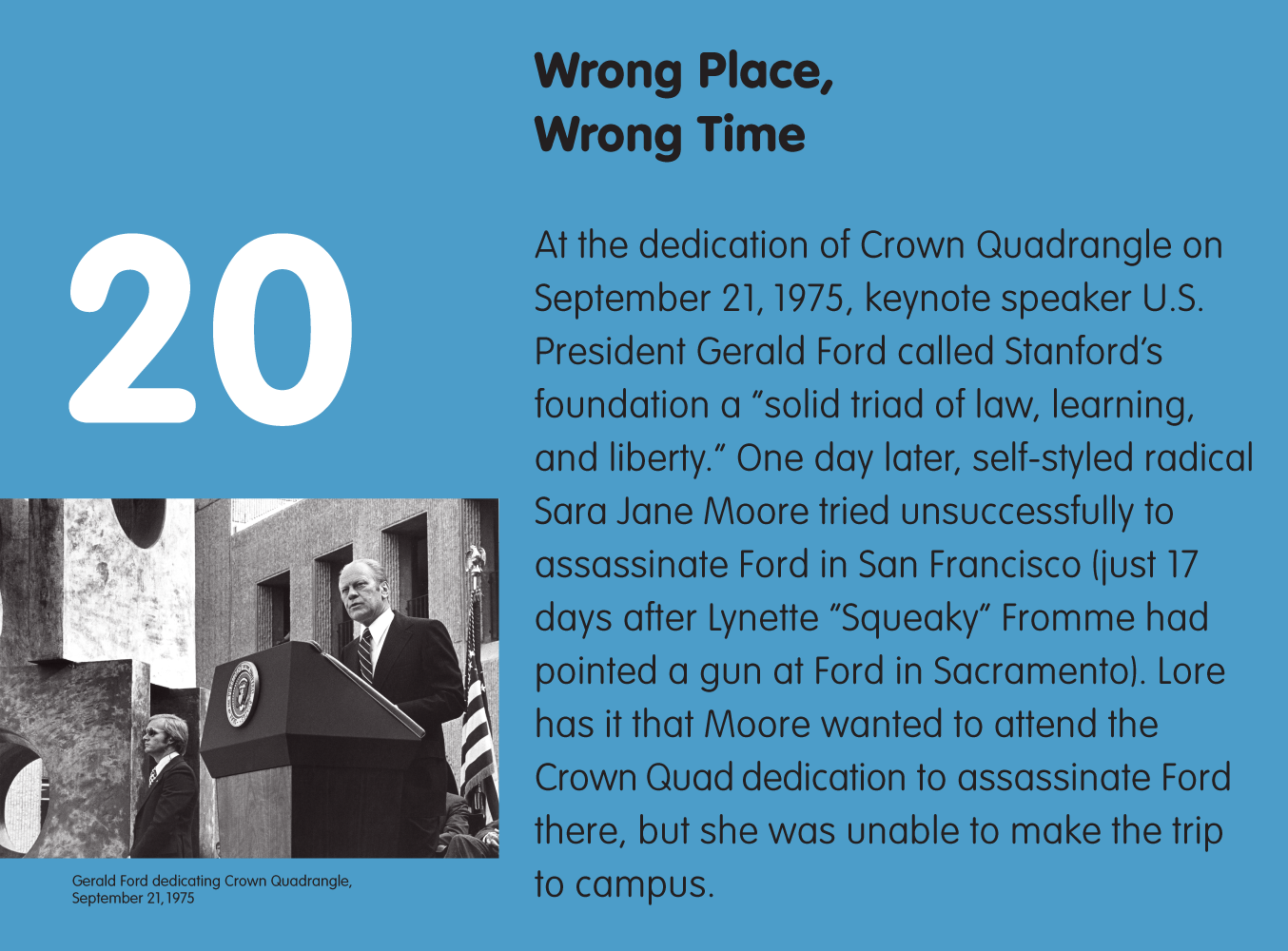
Wrong Place, Wrong Time
At the dedication of Crown Quadrangle on September 21, 1975, keynote speaker U.S. President Gerald Ford called Stanford’s foundation a ”solid triad of law, learning, and liberty.” One day later, self-styled radical Sara Jane Moore tried unsuccessfully to assassinate Ford in San Francisco (just 17 days after Lynette “Squeaky” Fromme had pointed a gun at Ford in Sacramento). Lore has it that Moore wanted to attend the Crown Quad dedication to assassinate Ford there, but she was unable to make the trip to campus.
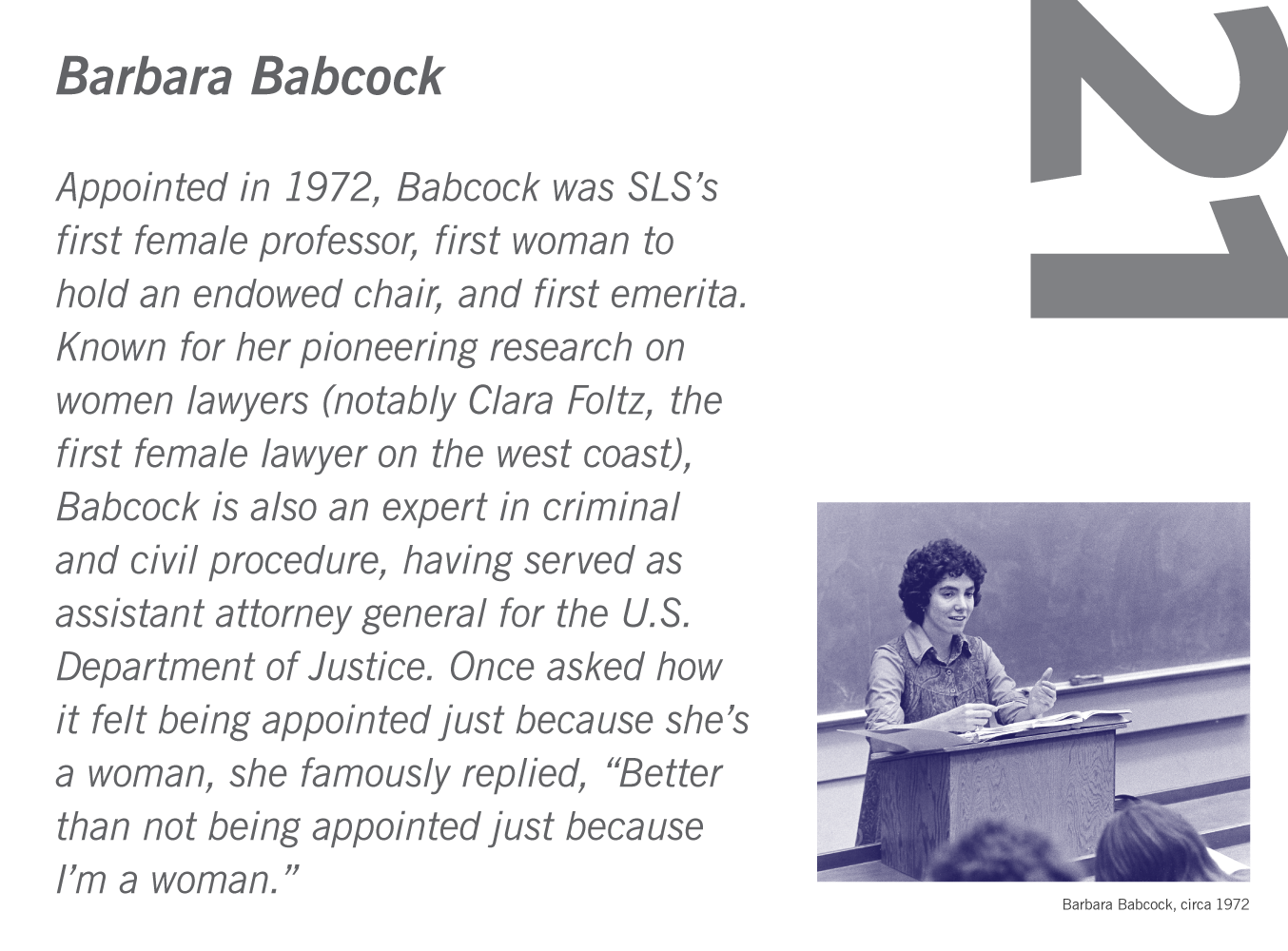
Barbara Babcock
Appointed in 1972, Babcock was SLS’s first female professor, first woman to hold an endowed chair, and first emerita. Known for her pioneering research on women lawyers (notably Clara Foltz, the first female lawyer on the west coast), Babcock is also an expert in criminal and civil procedure, having served as assistant attorney general for the U.S. Department of Justice. Once asked how it felt being appointed just because she’s a woman, she famously replied, “Better than not being appointed just because I'm a woman.”
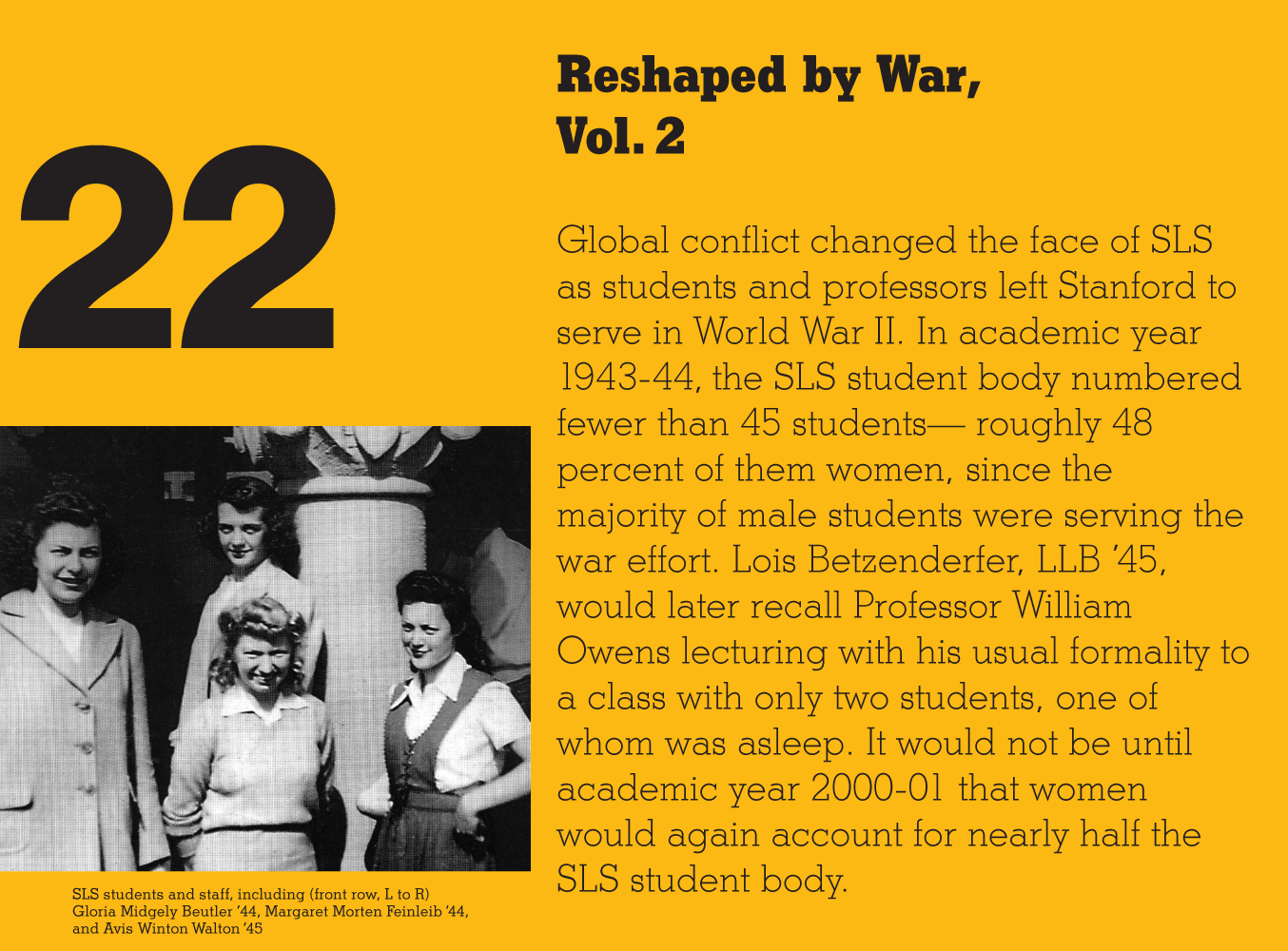
Reshaped by War, Vol. 2
Global conflict changed the face of SLS as students and professors left Stanford to serve in World War II. In academic year 1943-44, the SLS student body numbered less than 45 students—roughly 48 percent of them women, since the majority of male students were serving the war effort. Lois Betzenderfer, LLB ’45, would later recall Professor William Owens lecturing with his usual formality to a class with only two students, one of whom was asleep. It would not be until academic year 2000-01 that women would again account for nearly half the SLS student body.

“I Am Crothers”
George Crothers, AM 1896, Jane Stanford’s personal lawyer, lent his name to SLS’s first dormitory, Crothers Hall, built in 1948. Crothers was so dedicated to ensuring quality in every last detail that he had metal nametag holders affixed to the doors, so the doors’ varnish wouldn’t be damaged when nametags were hung. Shortly after the hall opened, residents noticed an elderly man roaming the corridors. He asked how they liked living there, and, satisfied with their positive response, he continued down the corridor, saying over his shoulder, ”I am Crothers.”
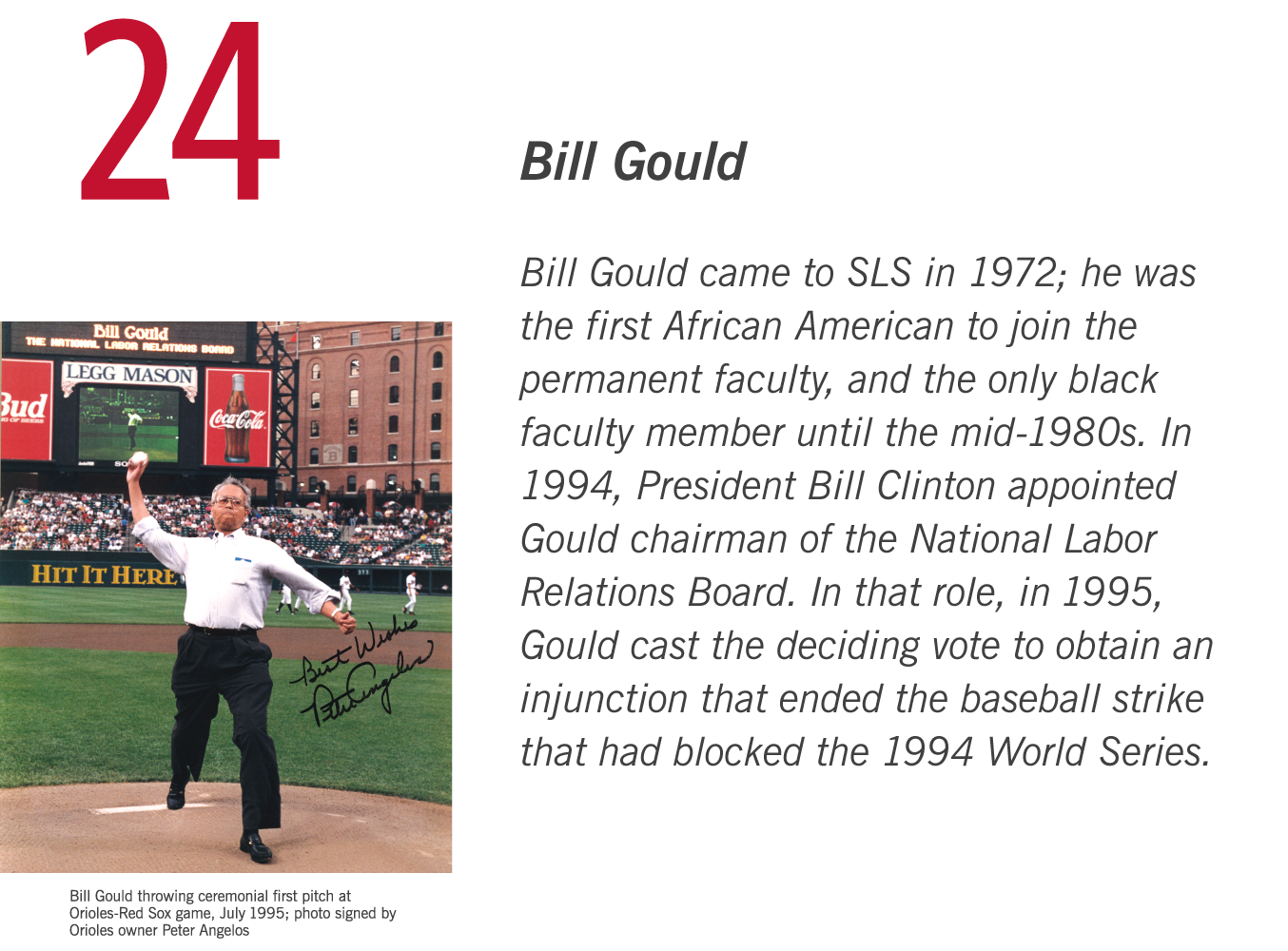
Bill Gould
Bill Gould came to SLS in 1972; he was the first African American to join the permanent faculty, and the only black faculty member until the mid-1980s. In 1994, President Bill Clinton appointed Gould chairman of the National Labor Relations Board. In that role, in 1995, Gould cast the deciding vote to obtain an injunction that ended the baseball strike that had blocked the 1994 World Series.
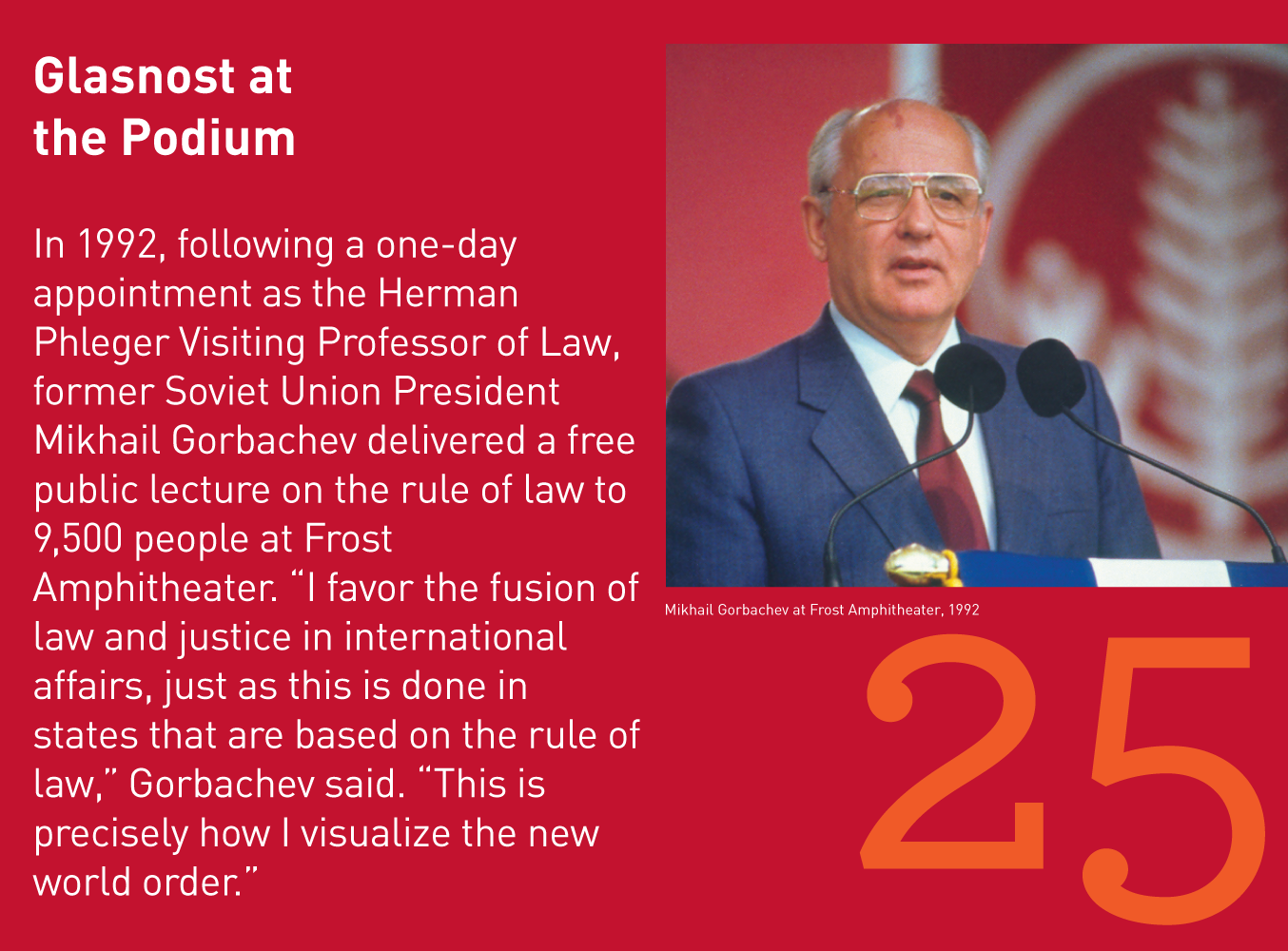
Glasnost at the Podium
In 1992, following a one-day appointment as the Herman Phleger Visiting Professor of Law, former Soviet Union President Mikhail Gorbachev delivered a free public lecture on the rule of law to 9,500 people at Stanford’s Frost Amphitheater. “I favor the fusion of law and justice in international affairs, just as this is done in states that are based on the rule of law,” Gorbachev said. “This is precisely how I visualize the new world order.”
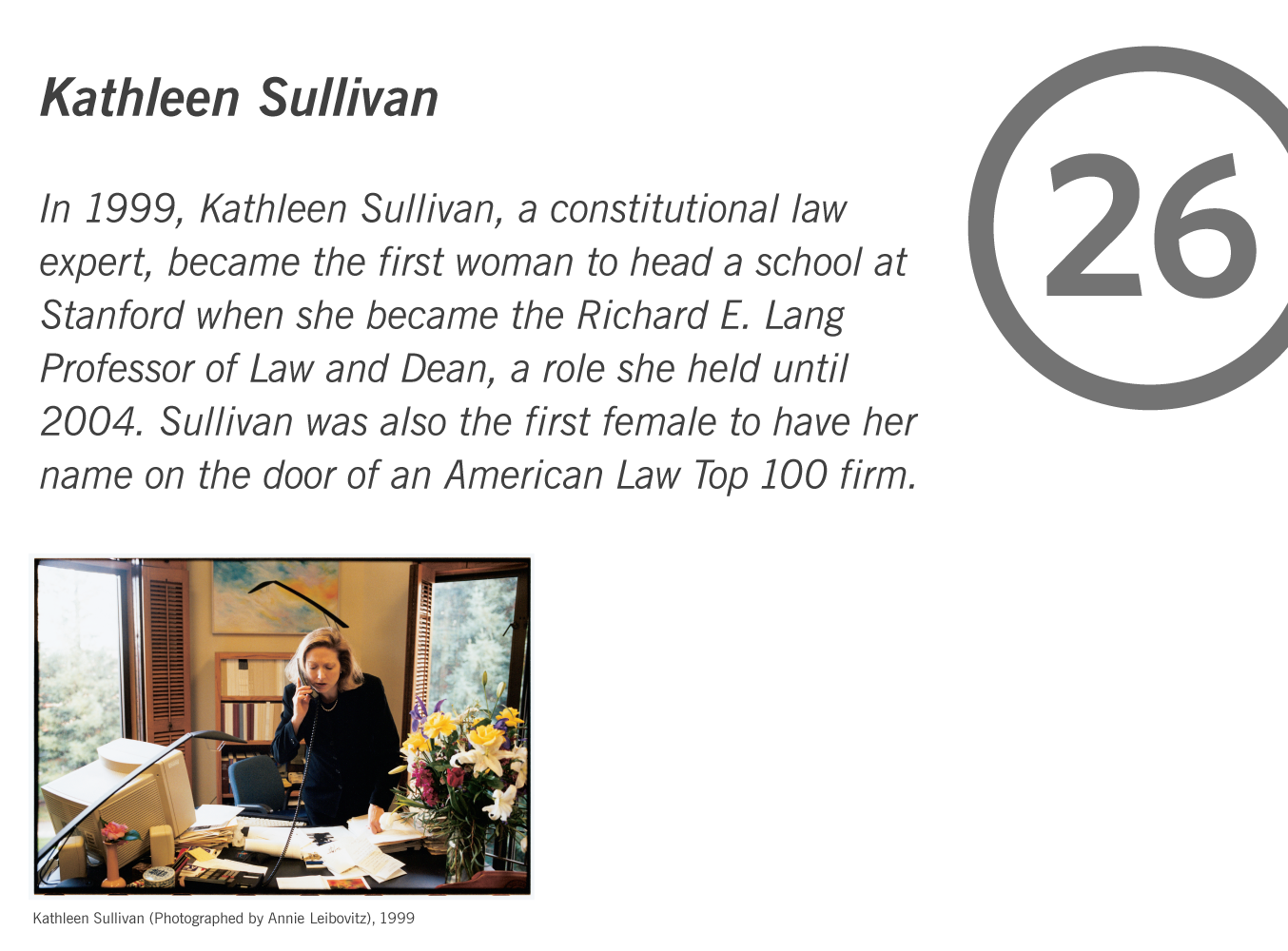
Kathleen Sullivan
In 1999, Kathleen Sullivan, a constitutional law expert, became the first woman to head a school at Stanford when she became the Richard E. Lang Professor of Law and Dean, a role she held until 2004. Sullivan was also the first female to have her name on the door of an American Law Top 100 firm.
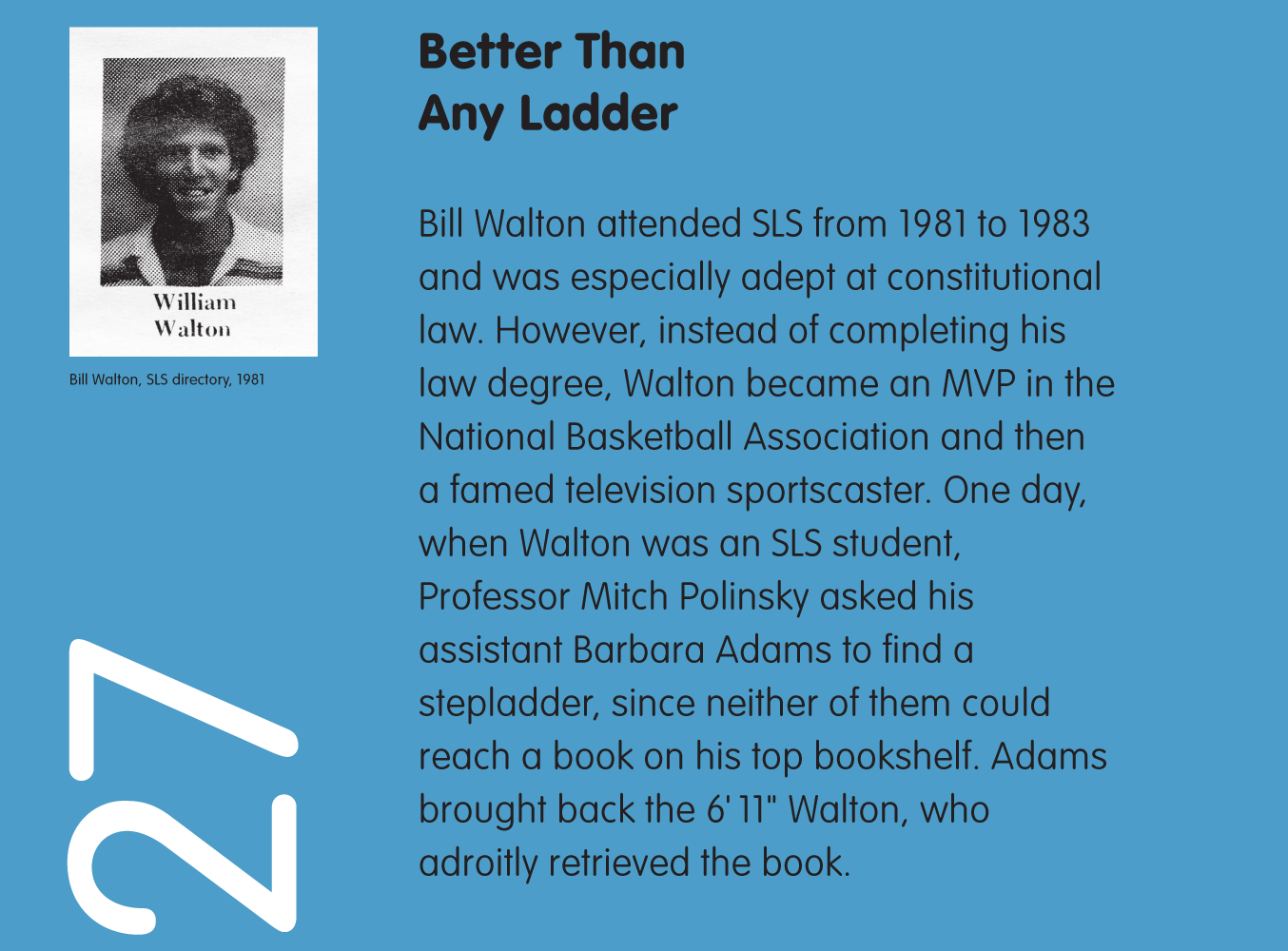
Better Than Any Ladder
Bill Walton attended SLS from 1981 to 1983 and was especially adept at constitutional law. However, instead of completing his law degree, Walton became an MVP in the National Basketball Association and then a famed television sportscaster. One day, when Walton was an SLS student, Professor Mitch Polinsky asked his assistant Barbara Adams to find a stepladder, since neither of them could reach a book on his top bookshelf. Adams brought back the 6' 11" Walton, who adroitly retrieved the book.

You Say Quarter, I Say Semester
When Stanford University opened on October 1, 1891, it operated on the semester system; its law department, which opened in 1893, followed suit. In 1917, a campus-wide switch was made to the quarter system. But in 1966, SLS switched to semesters to be in sync with other law schools, while the rest of the university stayed on quarters. In 2009, SLS re-joined the university's quarter system.
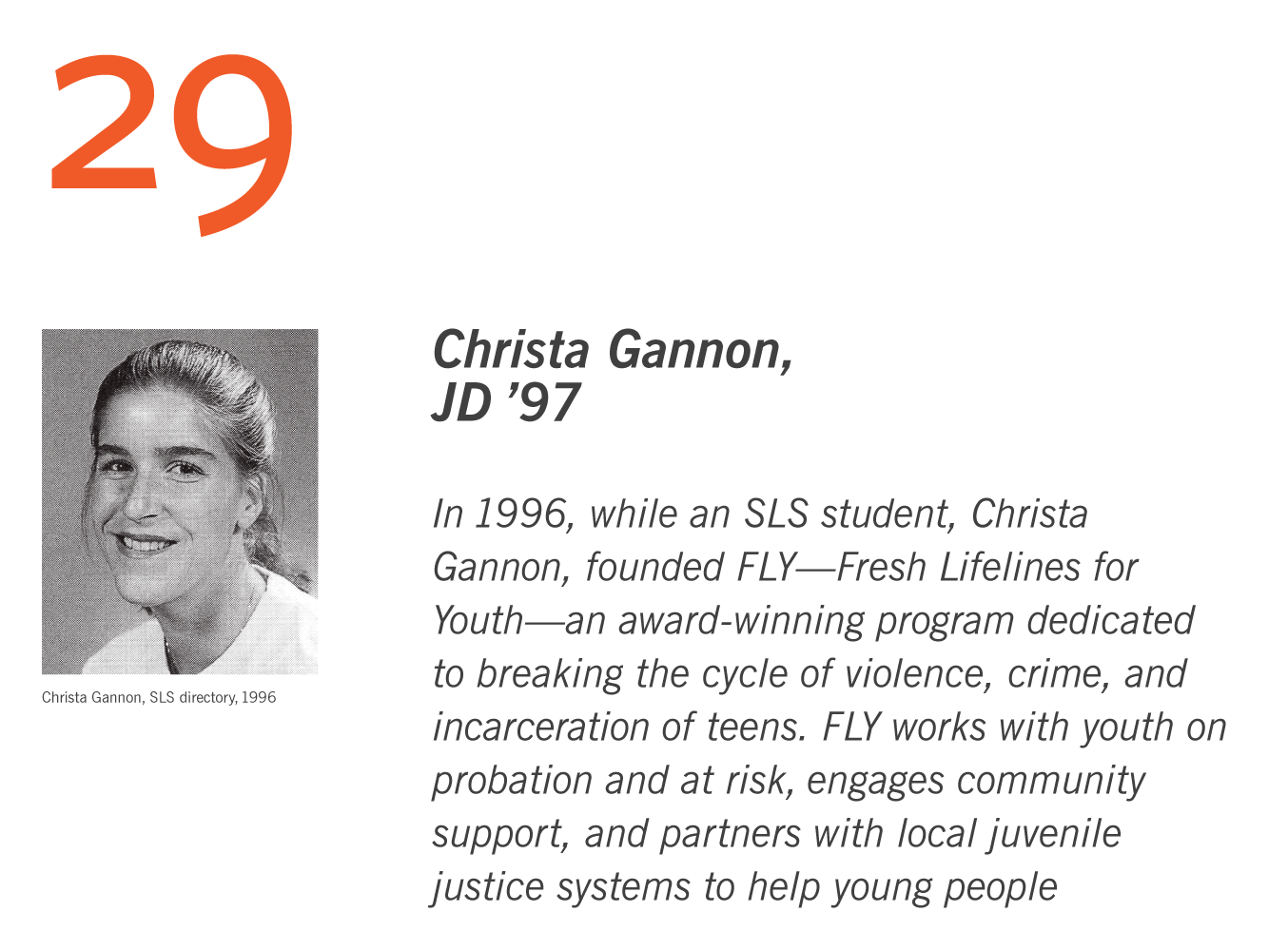
Christa Gannon, JD ‘97
In 1996, while an SLS student, Christa Gannon, founded FLY—Fresh Lifelines for Youth—an award-winning program dedicated to breaking the cycle of violence, crime, and incarceration of teens. FLY works with youth on probation and at risk, engages community support, and partners with local juvenile justice systems to help young people transform their lives.
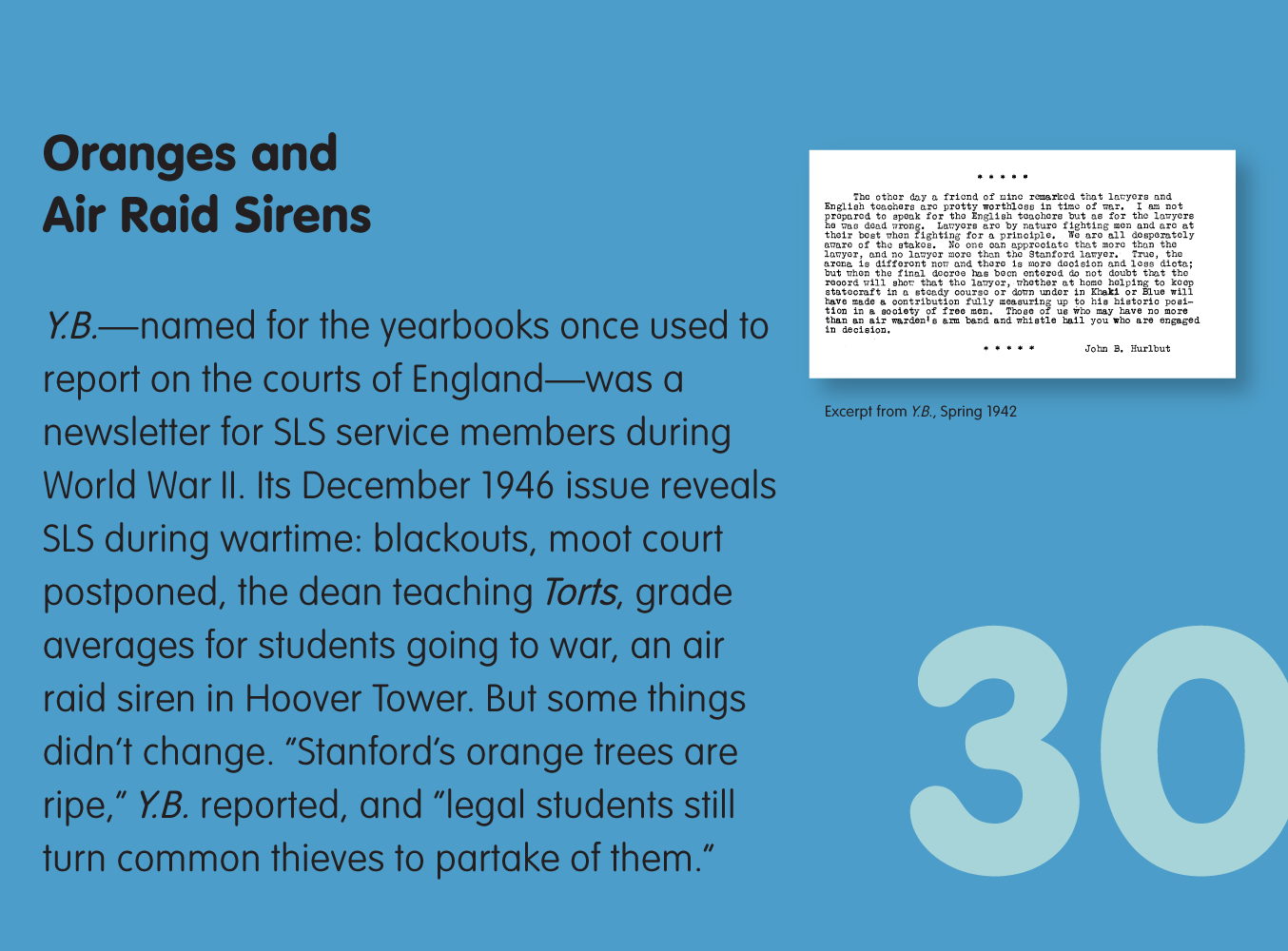
Oranges and Air Raid Sirens
Y.B.—named for the yearbooks once used to report on the courts of England—was a newsletter for SLS service members during World War II. Its December 1946 issue reveals SLS during wartime: blackouts, moot court postponed, the dean teaching Torts, grade averages for students going to war, an air raid siren in Hoover Tower. But some things didn't change. “Stanford’s orange trees are ripe,”Y.B.reported, and “legal students still turn common thieves to partake of them.”
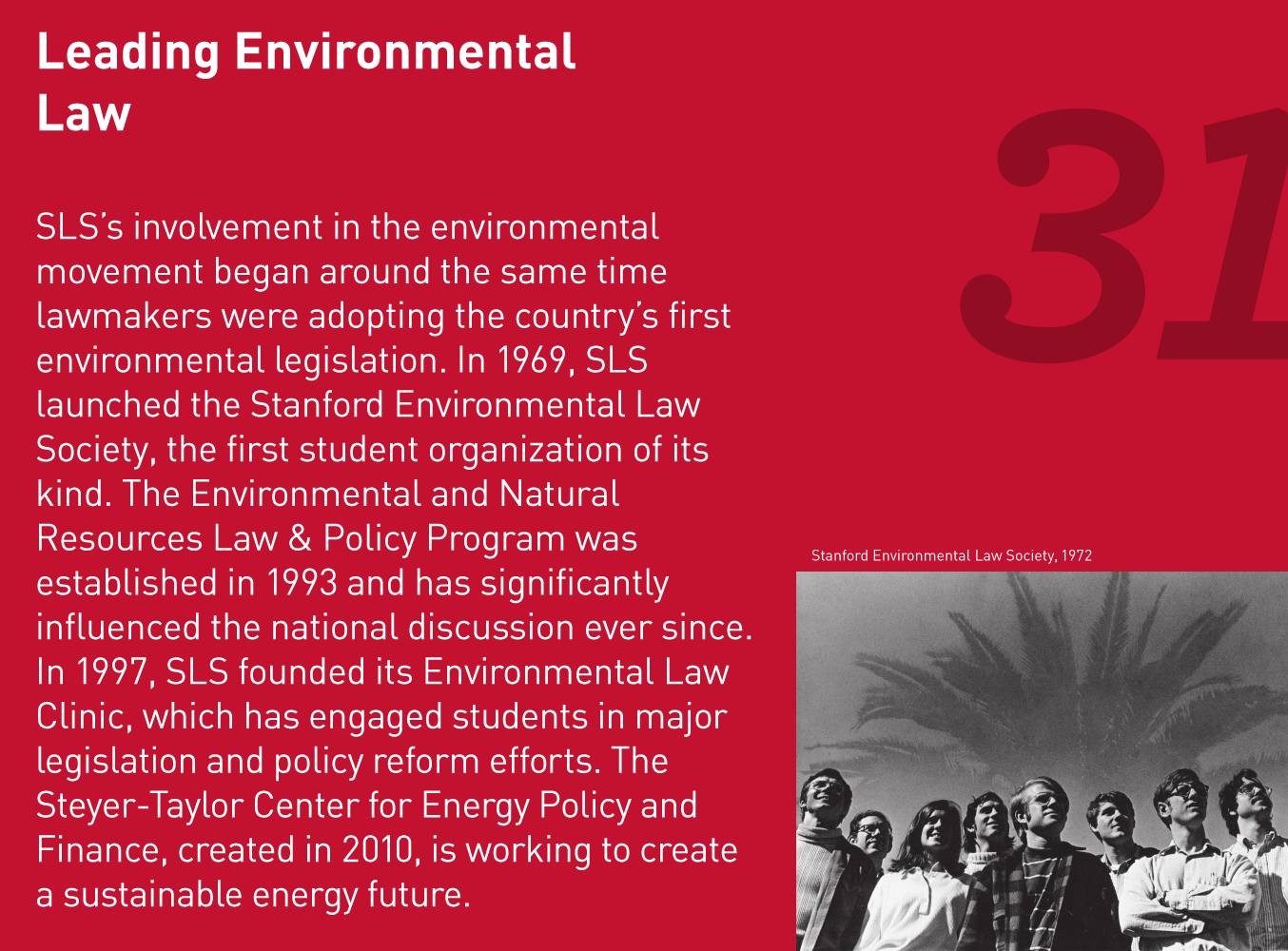
Leading Environmental Law
SLS’s involvement in the environmental movement began around the same time lawmakers were adopting the country’s first environmental legislation. In 1969, SLS launched the Stanford Environmental Law Society, the first student organization of its kind. The Environmental and Natural Resources Law & Policy Program was established in 1993, and has significantly influenced the national discussion ever since. In 1997, SLS founded its Environmental Law Clinic, which has engaged students in major legislation and policy reform efforts. The Steyer-Taylor Center for Energy Policy and Finance, created in 2010, is working to create a sustainable energy future.

Keith Mann
An esteemed labor arbitrator, Keith Mann was appointed by three U.S. presidents—Kennedy, Johnson, and Nixon—to negotiate difficult national labor disputes. He also played a transformative role in the history of SLS, joining the faculty in 1952 and serving twice as acting dean. Mann is remembered as a goodwill ambassador with a cool head, an even temper, and acute sensitivity to the needs and hopes of others.
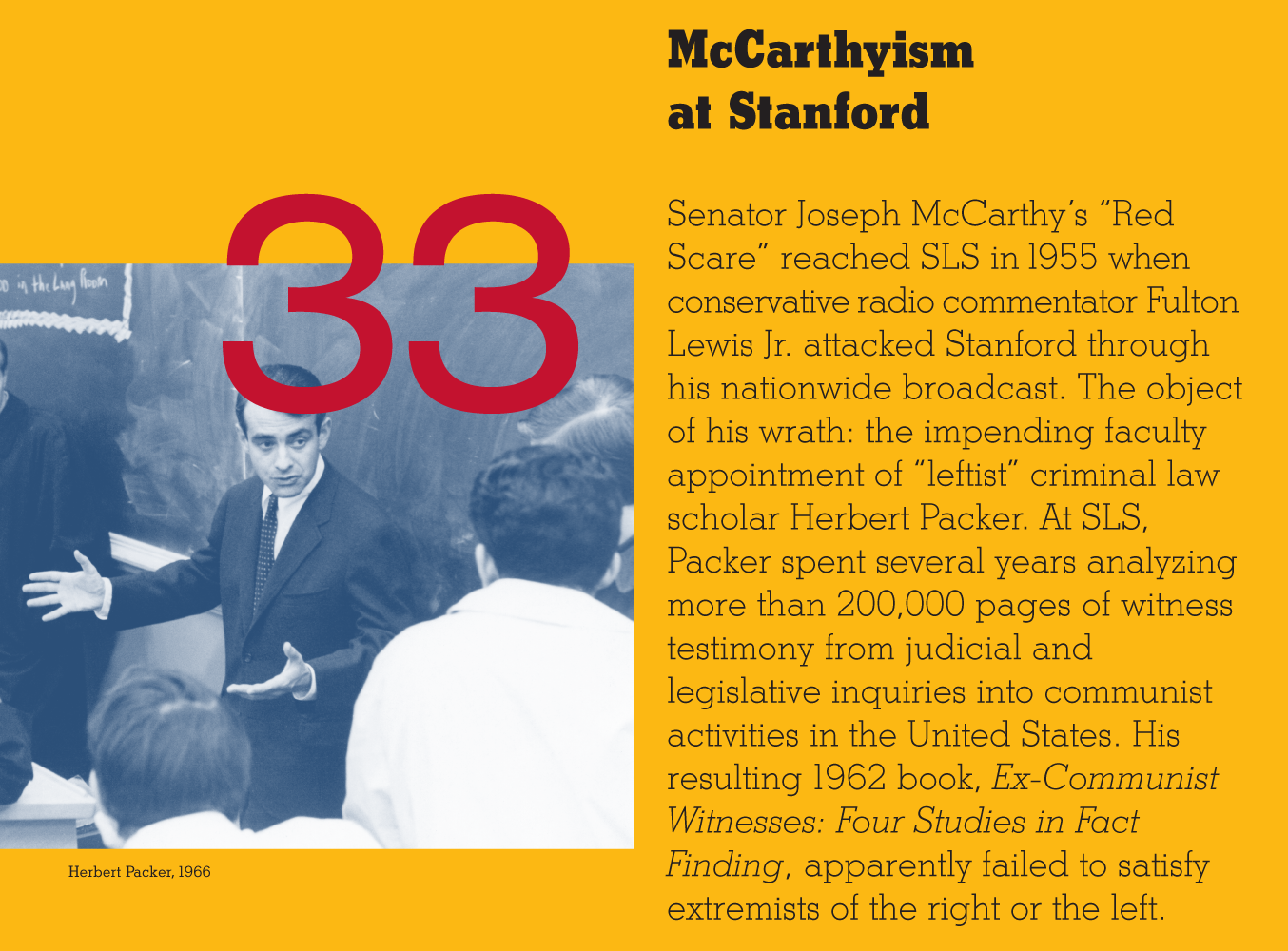
McCarthyism at Stanford
Senator Joseph McCarthy’s “Red Scare” reached SLS in 1955 when conservative radio commentator Fulton Lewis Jr. attacked Stanford through his nationwide broadcast. The object of his wrath: the impending faculty appointment of “leftist” criminal law scholar Herbert Packer. At SLS, Packer spent several years analyzing more than 200,000 pages of witness testimony from judicial and legislative inquiries into communist activities in the United States. His resulting 1962 book,Ex-Communist Witnesses: Four Studies in Fact Finding, apparently failed to satisfy extremists of the right or the left.

Big in Business
In 1997, SLS beefed up its business bona fides through key faculty hires. Drawing on faculty strengths in corporate and securities law, taxation, and economics, in 2003, the school united two respected programs to create the Program in Law, Economics & Business. The Arthur and Toni Rembe Rock Center for Corporate Governance, established in 2006 in partnership with the Stanford Graduate School of Business, solidified Stanford’s position as a leader in business law.
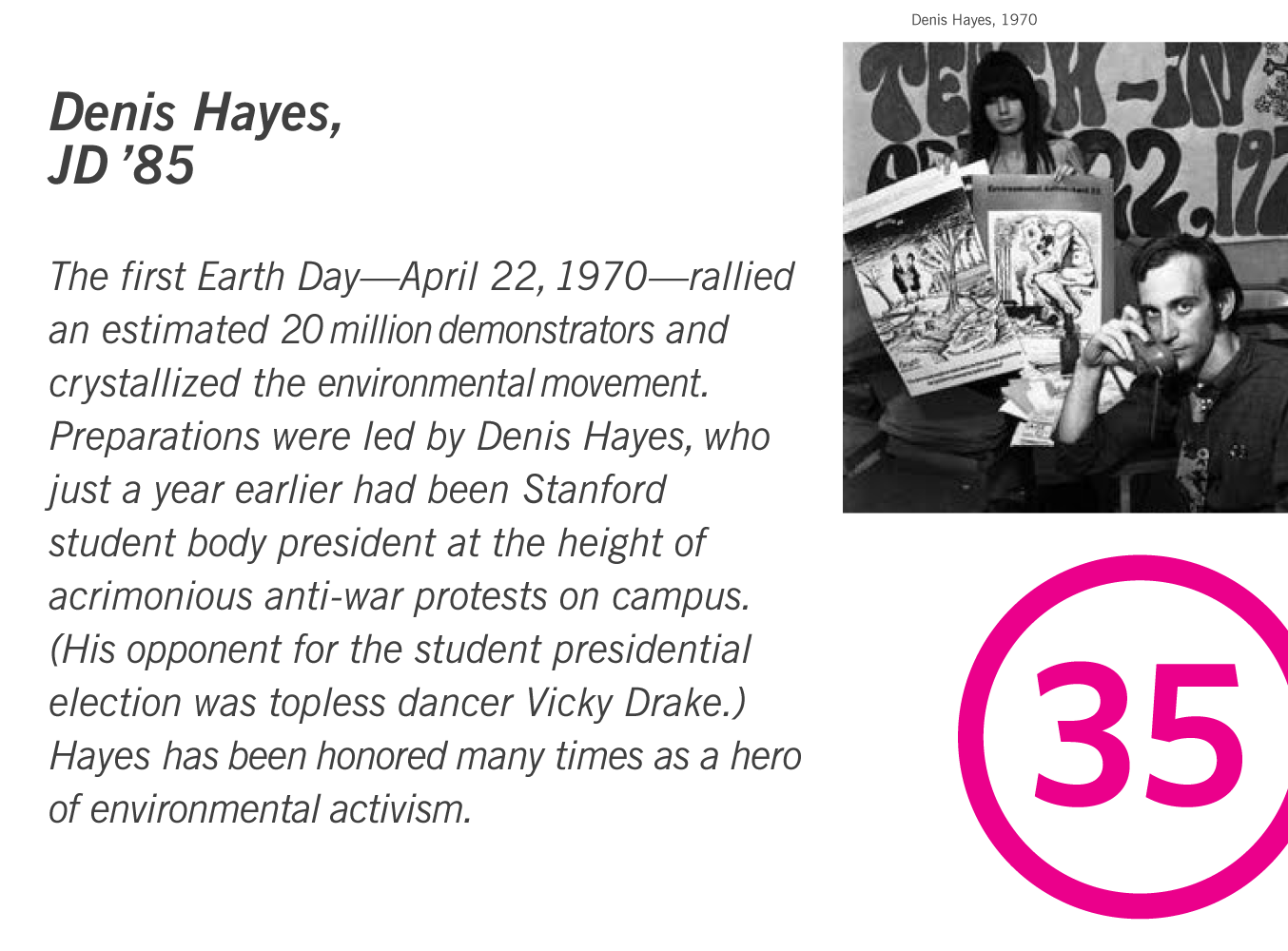
Denis Hayes, JD ’85
The first Earth Day—April 22, 1970—rallied an estimated 20 million demonstrators and crystallized the environmental movement. Preparations were led by Denis Hayes, who just a year earlier had been Stanford student body president at the height of acrimonious anti-war protests on campus. (His opponent for the student presidential election was topless dancer Vicky Drake.) Hayes has been honored many times as a hero of environmental activism.

The Columbia Raid
SLS was considered a regional law school until the early 1960s, when Dean Carl Spaeth recruited four key faculty members—Marc Franklin, Gerald Gunther, Charles Meyers, and Howard Williams—away from Columbia Law School. These new faculty members, along with the growing prominence of Stanford University, helped SLS emerge as a player on a national scale.
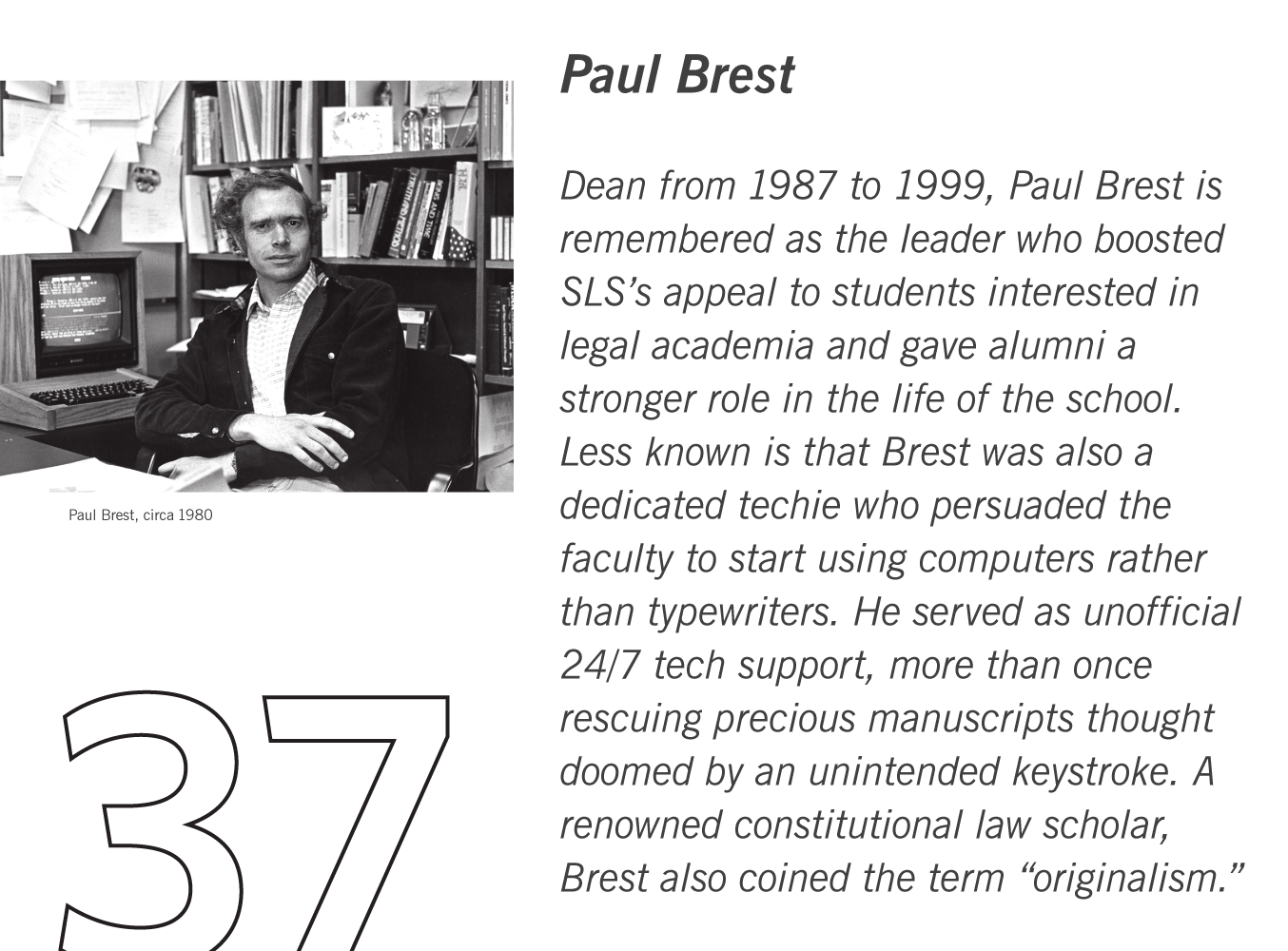

Who Stole the President’s Wine?
When Benjamin Harrison was a Stanford law professor in 1894, he lived in newly built Encina Hall, then a dormitory. Jane Stanford gifted him with wine, whiskey, and cigars, but Harrison did not partake of any of it, and immediately after his departure, thieves absconded with the 23rd U.S. president’s gifts. News of the caper made the national papers, and because Stanford was officially a dry campus, the story placed Harrison at the center of a scandal. It wasn't until many years later that a student admitted to stealing the goods and enjoying them with a few classmates.
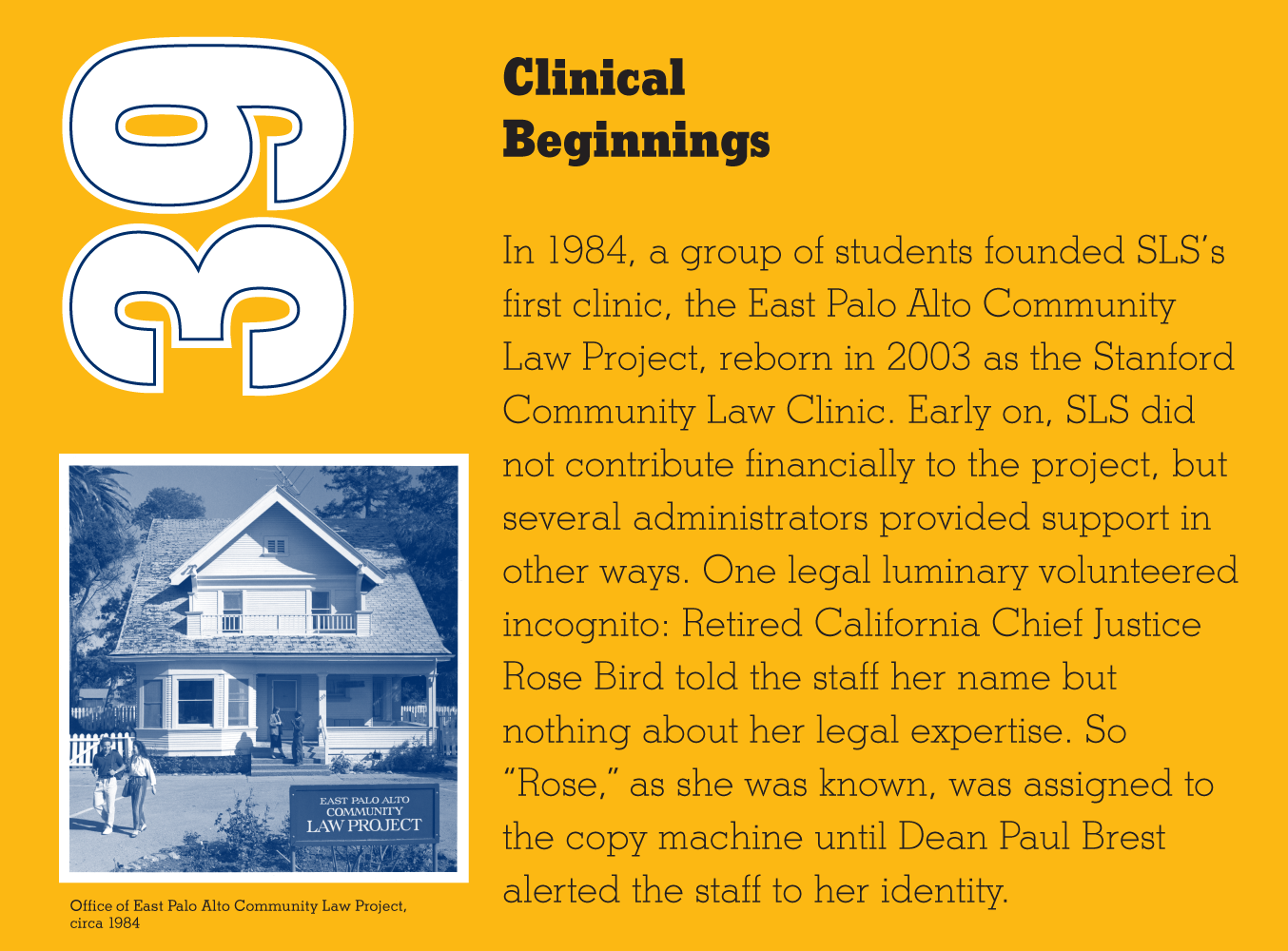
Clinical Beginnings
In 1984, a group of students founded SLS’s first clinic, the East Palo Alto Community Law Project, reborn in 2003 as the Stanford Community Law Clinic. Early on, SLS did not contribute financially to the project, but several administrators provided support in other ways. One legal luminary volunteered incognito: Retired California Chief Justice Rose Bird told the staff her name but nothing about her legal expertise. So “Rose,” as she was known, was assigned to the copy machine until Dean Paul Brest alerted the staff to her identity.

Pioneering the High-Tech Frontier
SLS was at the forefront of the high-tech revolution that has changed the world. In 1984, the Stanford Law and Technology Association was formed, promoting student scholarship on the interrelationships among law, science, technology, and society. In 1994, the Stanford Law and Technology Policy Center generated new opportunities to collaborate across disciplines. In 1997, SLS students launched the Stanford Technology Law Review, the nation’s first exclusively online journal in law and technology. The Stanford Program in Law, Science & Technology, initiated in 2000, has played a key role in the development of policy related to privacy, e-commerce, the biosciences, the Internet, and other high-tech areas.
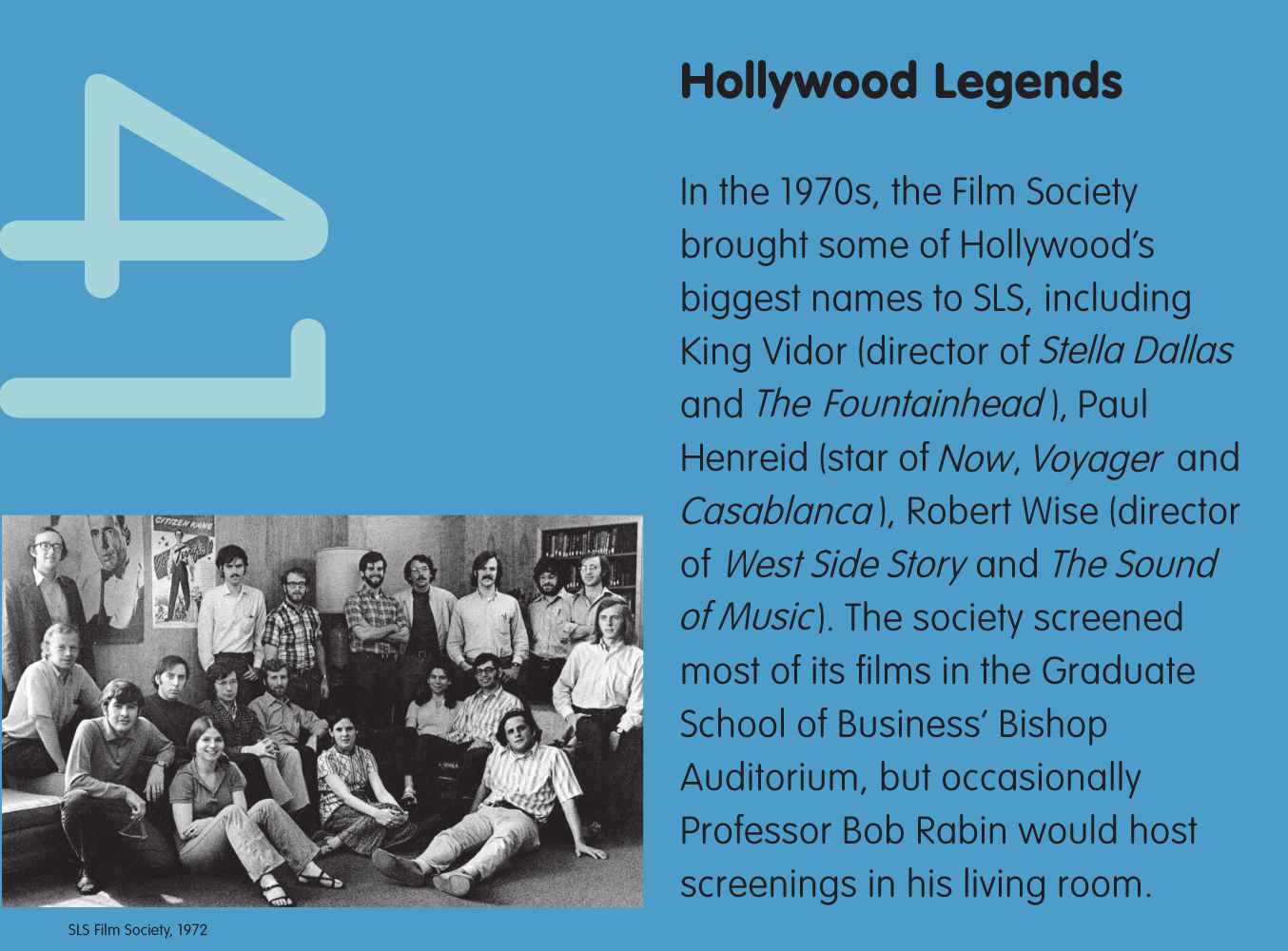
Hollywood Legends
In the 1970s, the Film Society brought some of Hollywood’s biggest names to SLS, including King Vidor (director of Stella Dallas and The Fountainhead), Paul Henreid (star of Now, Voyager and Casablanca), Robert Wise (director of West Side Story and The Sound of Music). The society screened most of its films in the Graduate School of Business’ Bishop Auditorium, but occasionally Professor Bob Rabin would host screenings in his living room.
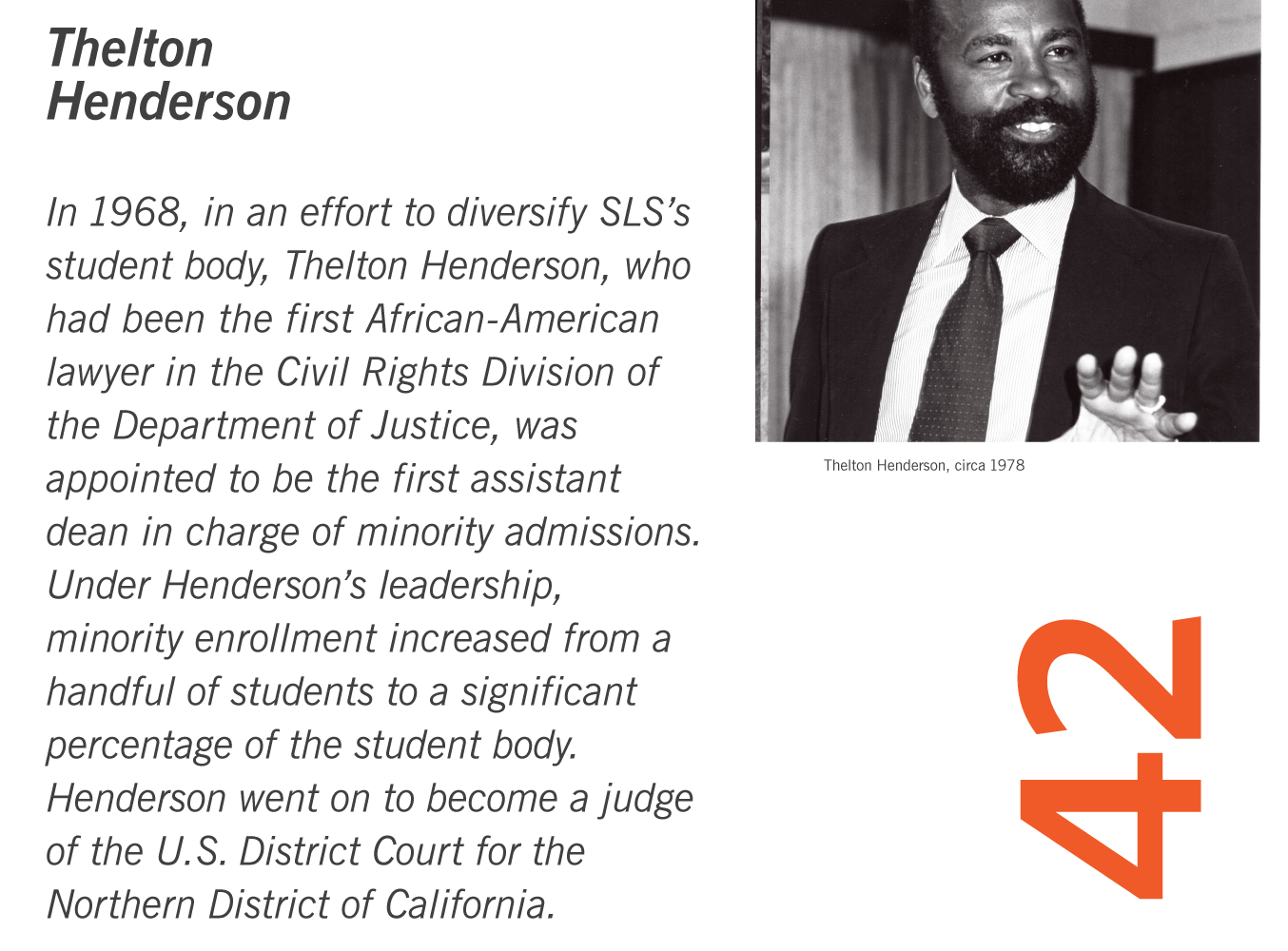
Thelton Henderson
In 1968, in an effort to diversify SLS’s student body, Thelton Henderson, who had been the first African- American lawyer in the Civil Rights Division of the Department of Justice, was appointed to be the first assistant dean in charge of minority admissions. Under Henderson’s leadership, minority enrollment increased from a handful of students to a significant percentage of the student body. Henderson went on to become a judge of the U.S. District Court for the Northern District of California.
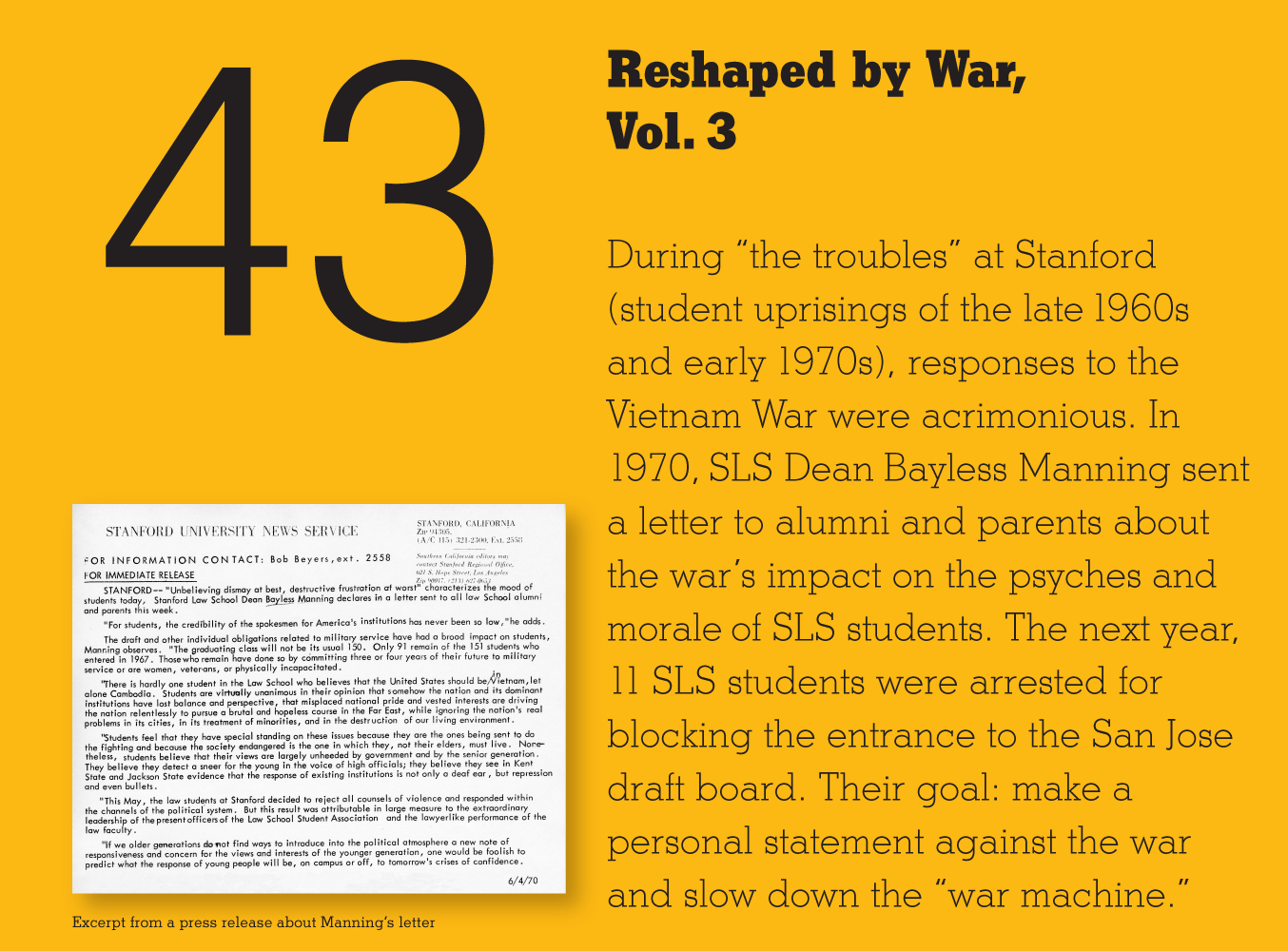
Reshaped by War, Vol. 3
During “the troubles” at Stanford (student uprisings of the late 1960s and early 1970s), responses to the Vietnam War were acrimonious. In 1970, Dean Bayless Manning sent a letter to alumni and parents about the war’s impact on the psyches and morale of law students. The next year, 11 law students were arrested for blocking the entrance to the San Jose draft board. Their goal: make a personal statement against the war and slow down the “war machine.”
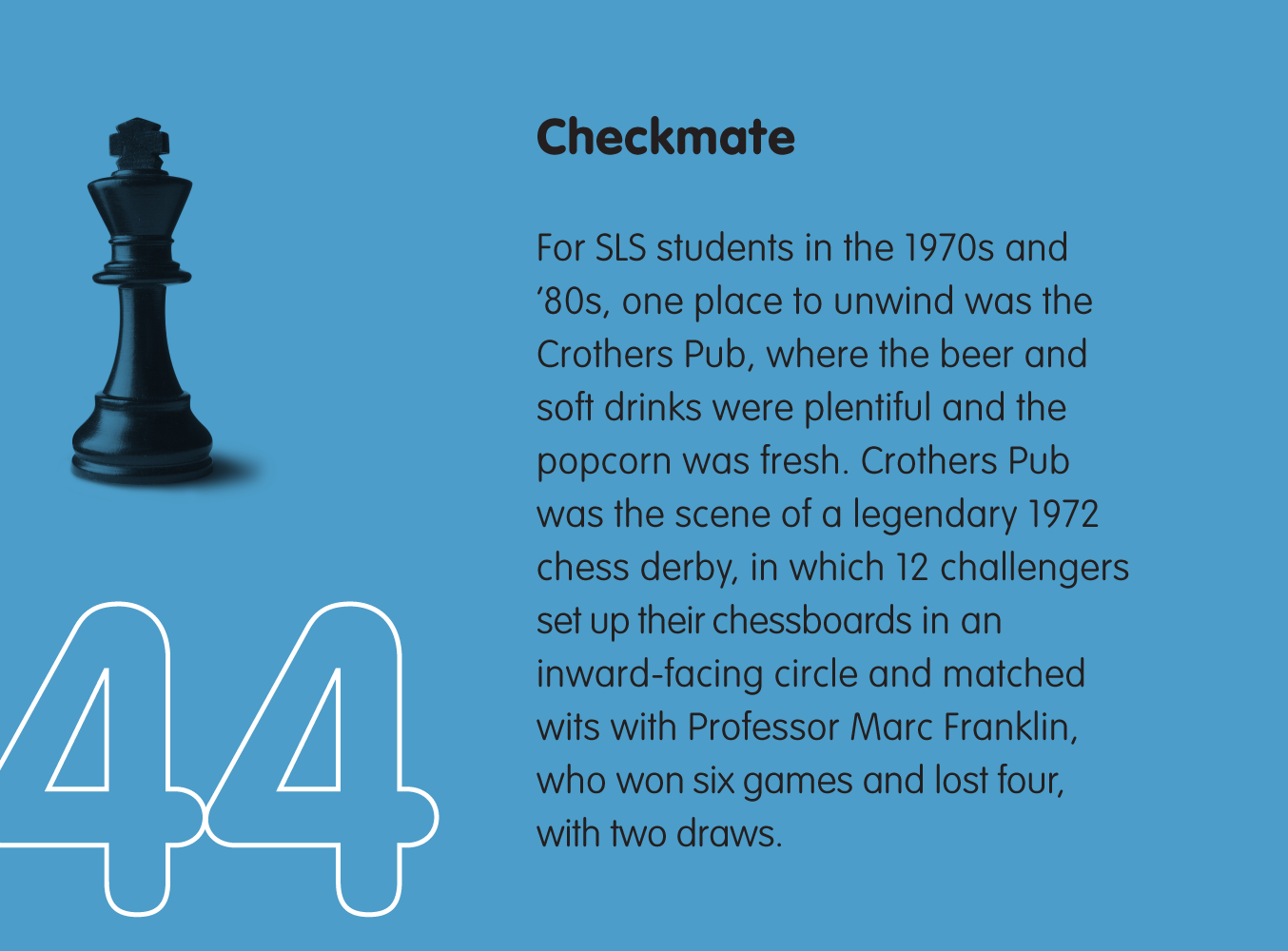
Checkmate
For SLS students in the 1970s and ‘80s, one place to unwind was the Crothers Pub, where the beer and soft drinks were plentiful and the popcorn was fresh. Crothers Pub was the scene of a legendary 1972 chess derby, in which 12 challengers set up their chessboards in an inward-facing circle and matched wits with Professor Marc Franklin, who won six games and lost four, with two draws.

Where No Law School Has Gone Before
In 2006, Dean Larry Kramer initiated a comprehensive curriculum reform effort. The goal: transform the traditional law degree into a multidimensional JD that integrates the study of non-law disciplines with team- oriented, problem-solving exercises and expanded clinical training that enables students to represent clients and litigate cases while in law school. The initiative brought the real world into the study of law as never before.
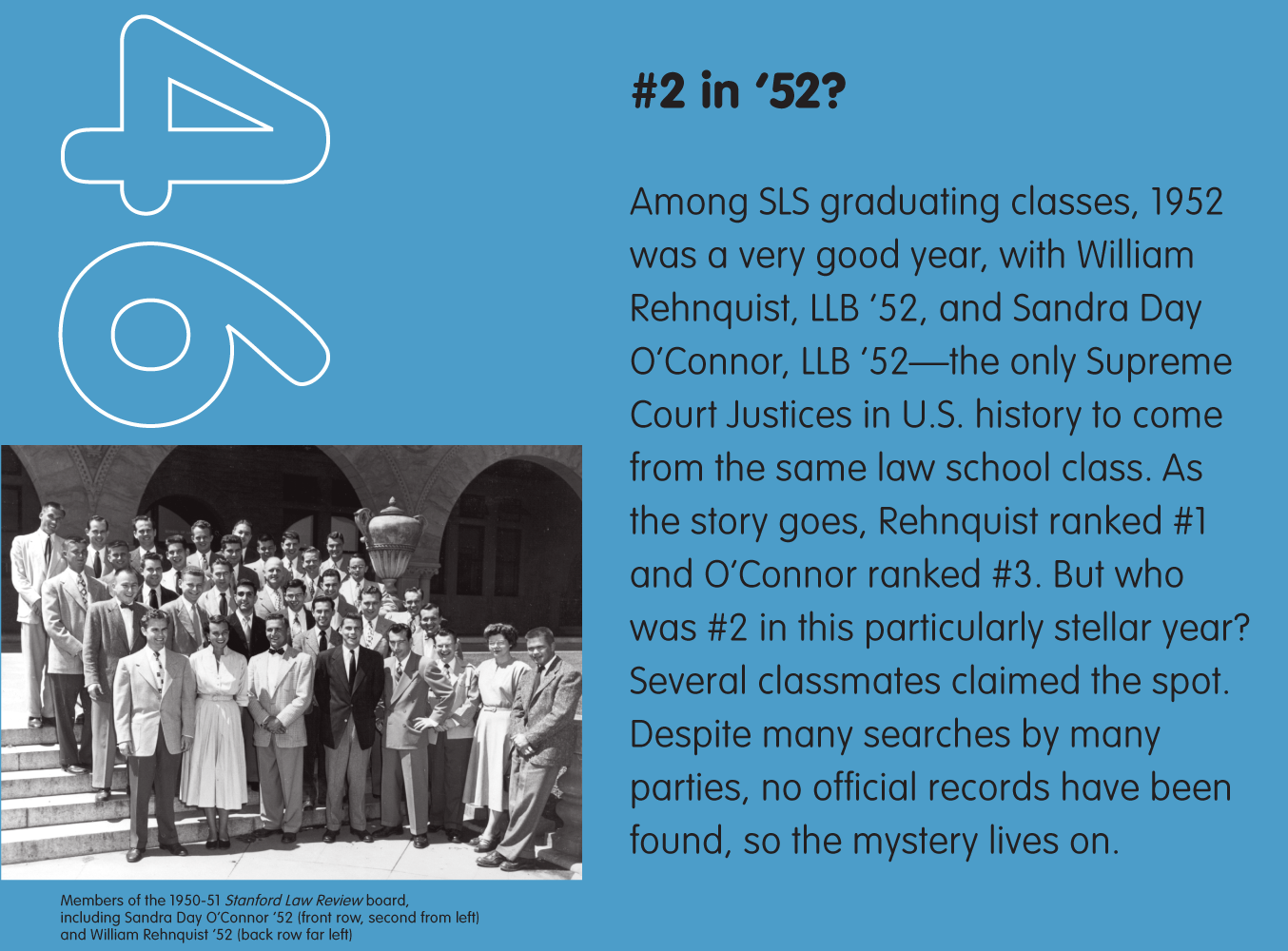
#2 in ‘52?
Among SLS graduating classes, 1952 was a very good year, with William Rehnquist, LLB ’52, and Sandra Day O'Connor, LLB ‘52—the only Supreme Court Justices in U.S. history to come from the same law school class. As the story goes, Rehnquist ranked #1 and O’Connor ranked #3. But who was #2 in this particularly stellar year? Several classmates claimed the spot. Despite many searches by many parties, no official records have been found, so the mystery lives on.
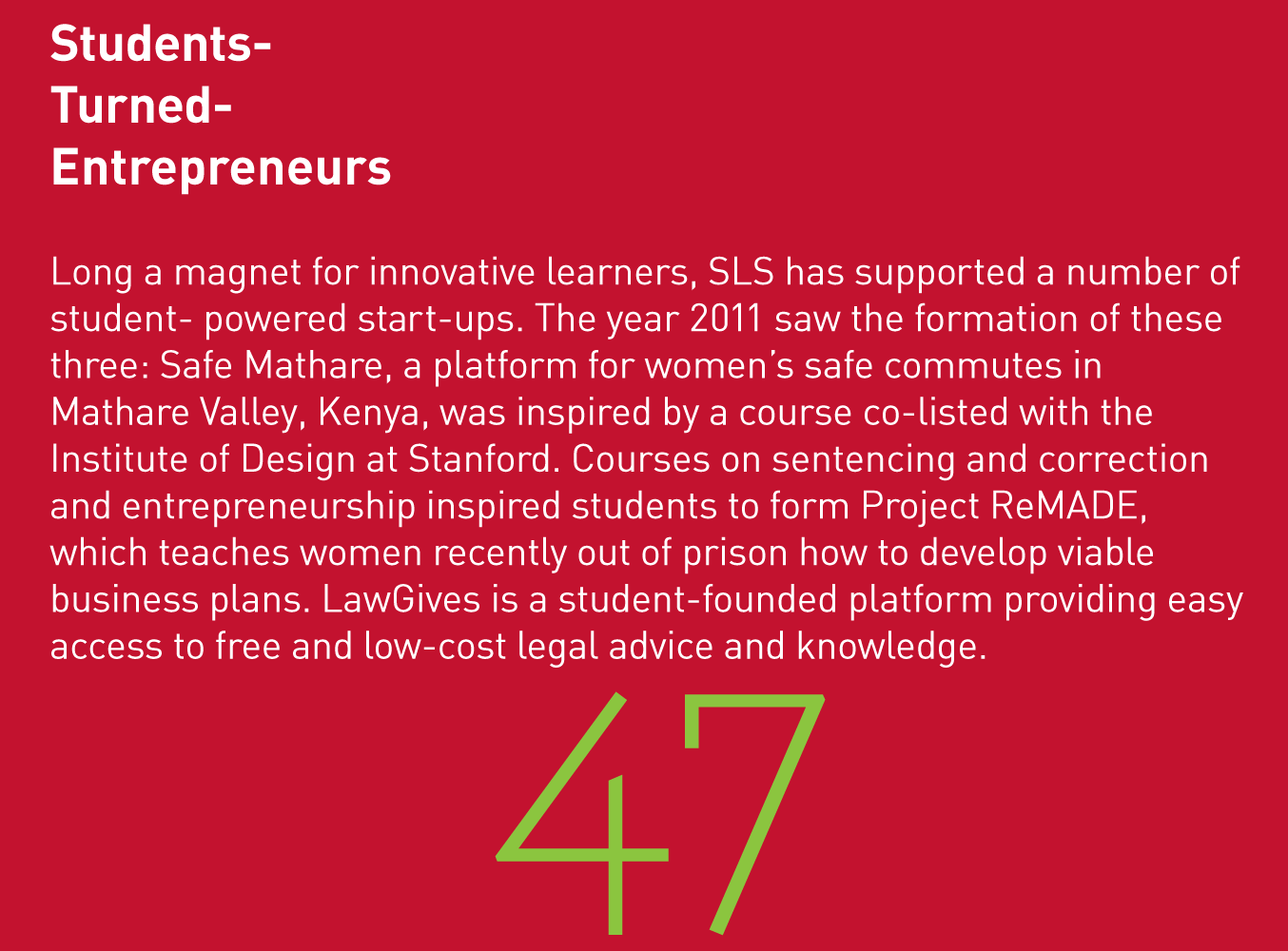
Students-Turned-Entrepreneurs
Long a magnet for innovative learners, SLS has supported a number of student-powered start-ups. The year 2011 saw the formation of these three: Safe Mathare, a platform for women’s safe commutes in Mathare Valley, Kenya, was inspired by a course co-listed with the Institute of Design at Stanford. Courses on sentencing and correction and entrepreneurship inspired students to form Project ReMADE, which teaches women recently out of prison how to develop viable business plans. LawGives is a student-founded platform providing easy access to free and low-cost legal advice and knowledge.
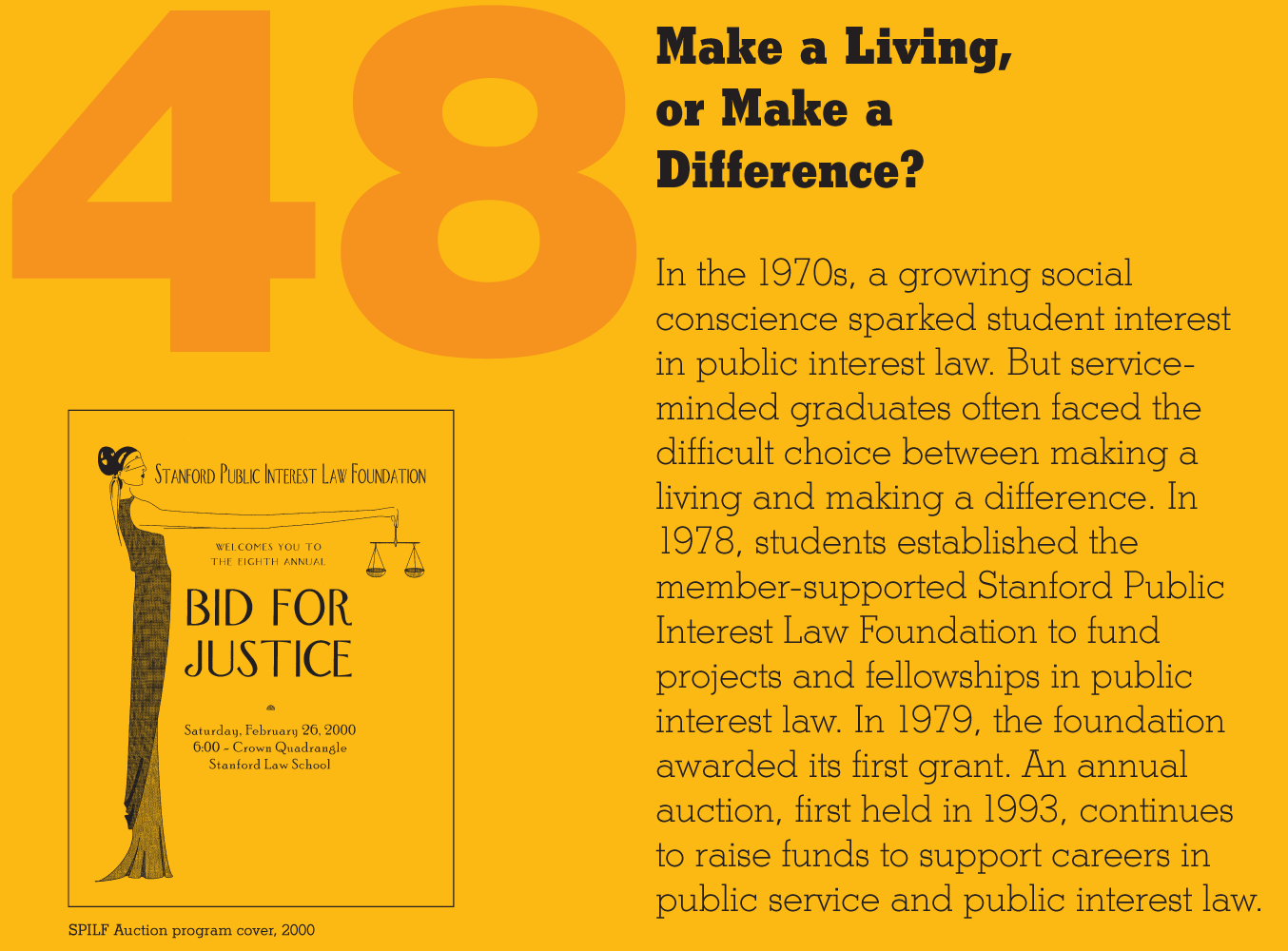
Make a Living, or Make a Difference?
In the 1970s, a growing social conscience sparked student interest in public interest law. But service-minded graduates often faced the difficult choice between making a living and making a difference. In 1978, students established the member-supported Stanford Public Interest Law Foundation to fund projects and fellowships in public interest law. In 1979, the foundation awarded its first grant. An annual auction, first held in 1993, continues to raise funds to support careers in public service and public interest law.
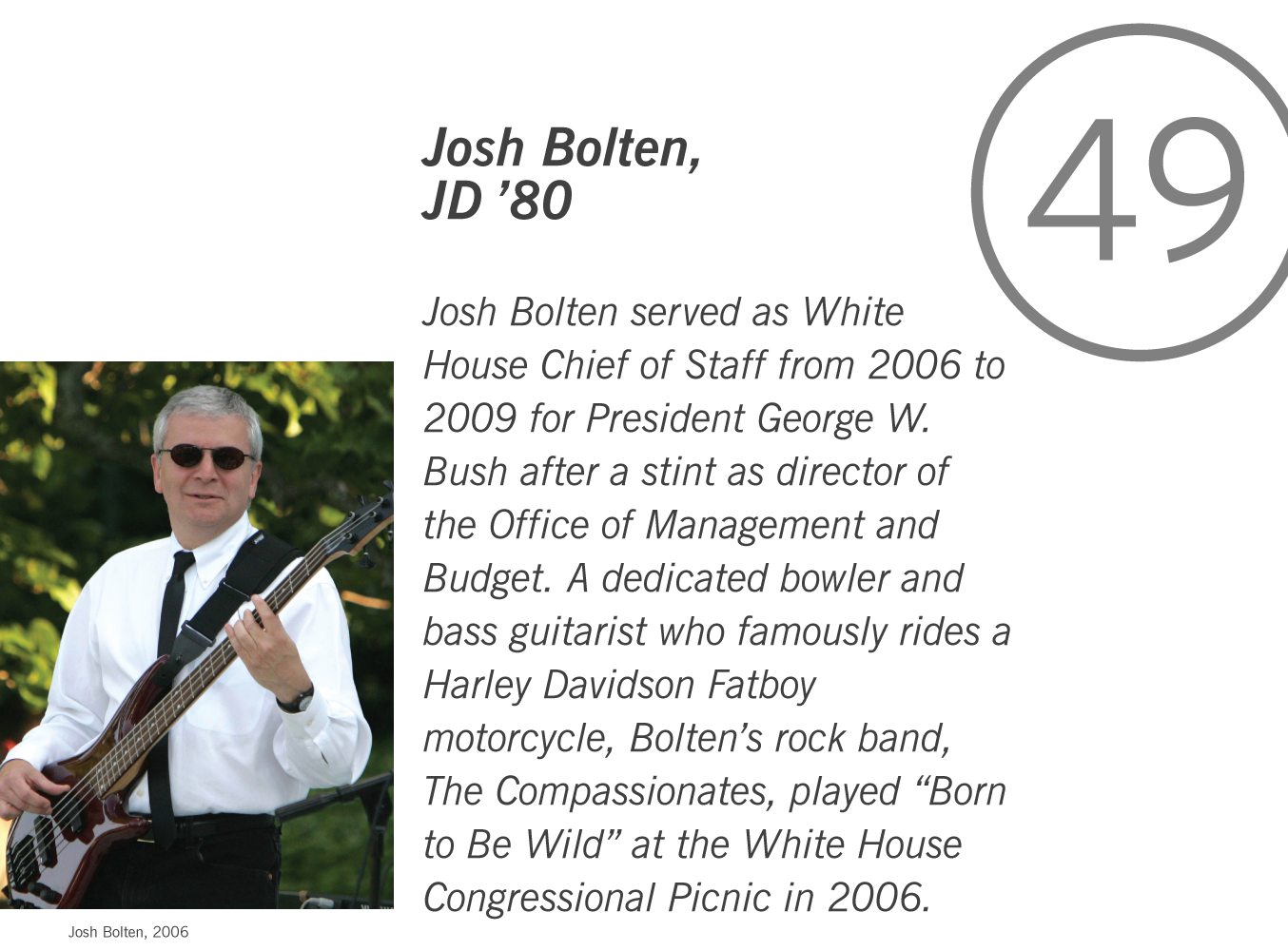
Josh Bolten, JD ‘80
Josh Bolten served as White House Chief of Staff from 2006 to 2009 for President George W. Bush after a stint as director of the Office of Management and Budget. A dedicated bowler and bass guitarist who famously rides a Harley Davidson Fatboy motorcycle, Bolten's rock band, The Compassionates, played “Born to Be Wild” at the White House Congressional Picnic in 2006.
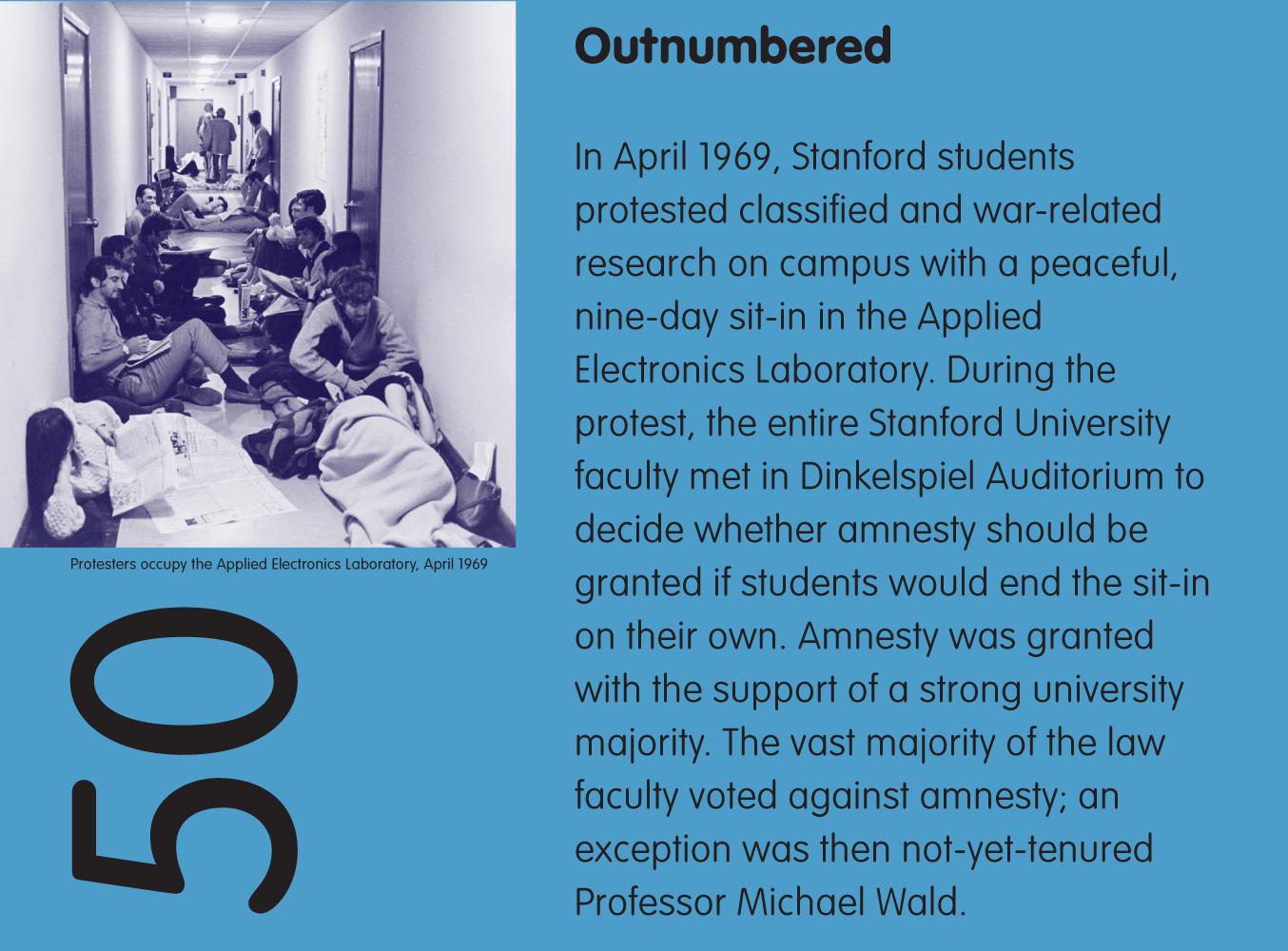
Outnumbered
In April 1969, Stanford students protested classified and war-related research on campus with a peaceful, nine-day sit-in in the Applied Electronics Laboratory. During the protest, the entire Stanford University faculty met in Dinkelspiel Auditorium to decide whether amnesty should be granted if students would end the sit-in on their own. Amnesty was granted with the support of a strong university majority. The vast majority of the law faculty voted against amnesty; an exception was then not-yet-tenured Professor Michael Wald.
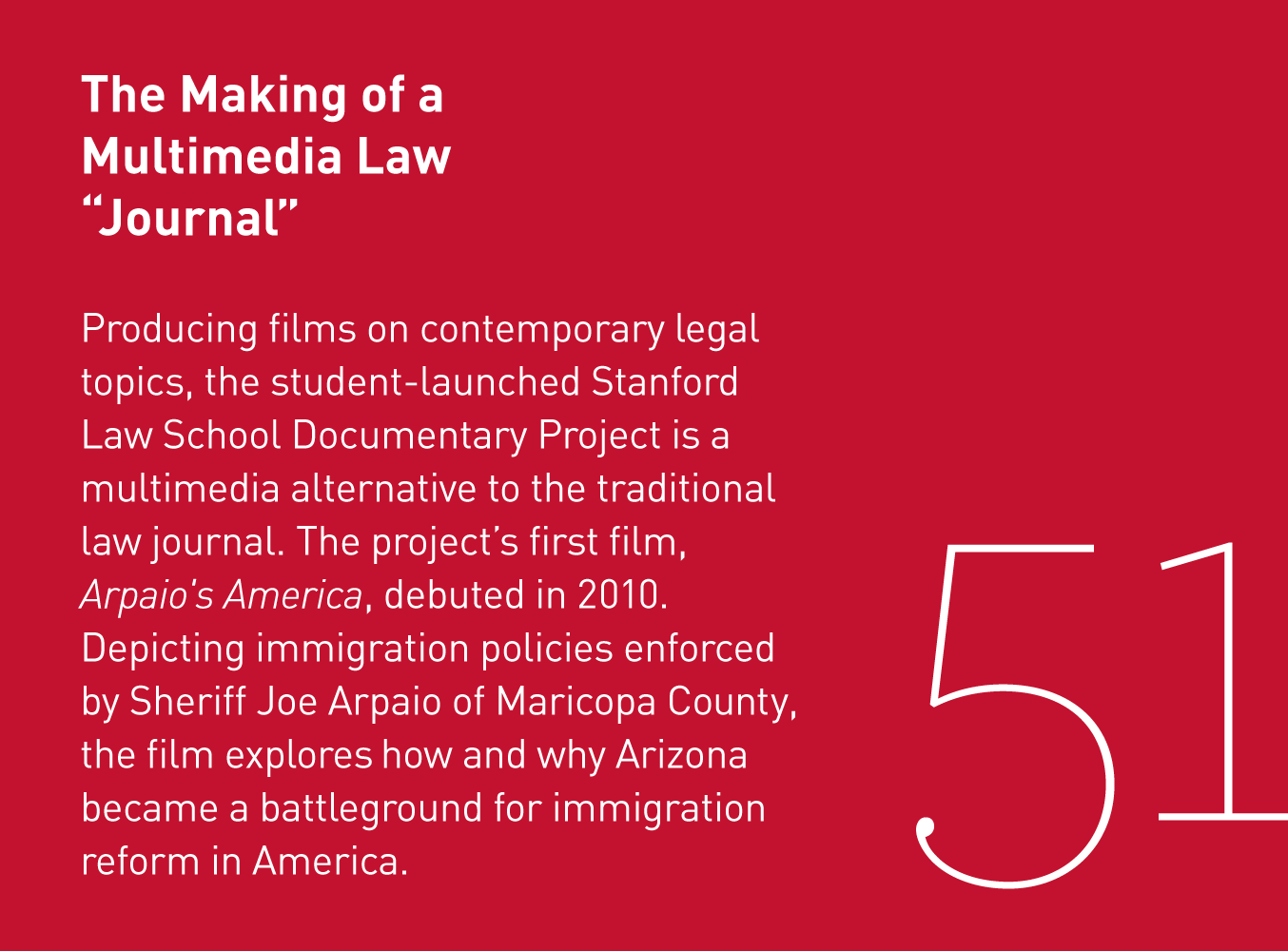
The Making of a Multimedia Law “Journal”
Producing films on contemporary legal topics, the student-launched Stanford Law School Documentary Project is a multimedia alternative to the traditional law journal. The project’s first film,Arpaio's America, debuted in 2010. Depicting immigration policies enforced by Sheriff Joe Arpaio of Maricopa County, the film explores how and why Arizona became a battleground for immigration reform in America.
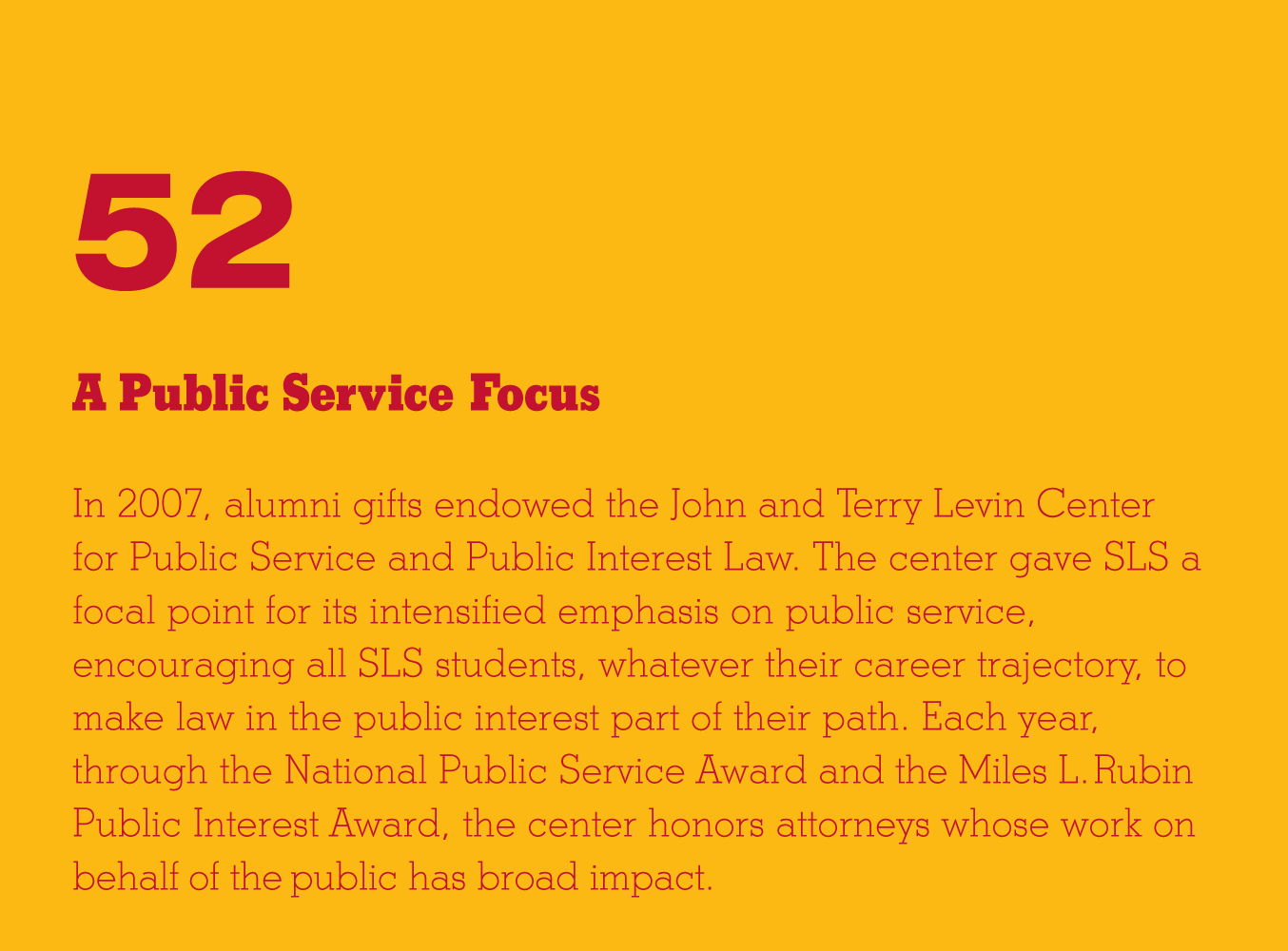
A Public Service Focus
In 2007, alumni gifts endowed the John and Terry Levin Center for Public Service and Public Interest Law. The center gave SLS a focal point for its intensified emphasis on public service, encouraging all SLS students, whatever their career trajectory, to make law in the public interest part of their path. Each year, through the National Public Service Award and the Miles L. Rubin Public Interest Award, the center honors attorneys whose work on behalf of the public has broad impact.
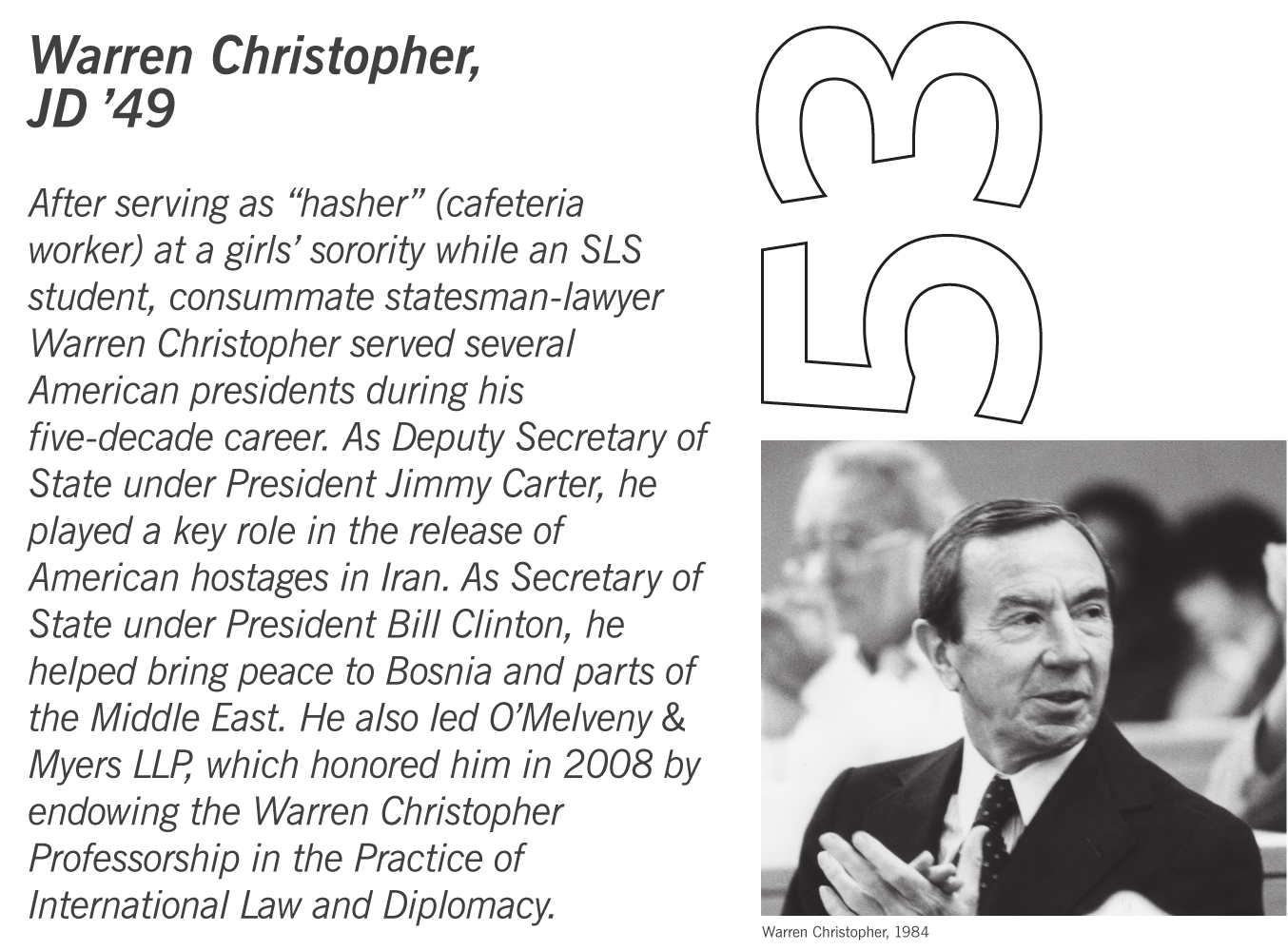
Warren Christopher, JD ‘49
After serving as “hasher” (cafeteria worker) at a girls’ sorority while an SLS student, consummate statesman- lawyer Warren Christopher served several American presidents during his five-decade career. As Deputy Secretary of State under President Jimmy Carter, he played a key role in the release of American hostages in Iran. As Secretary of State under President Bill Clinton, he helped bring peace to Bosnia and parts of the Middle East. He also led O’Melveny & Myers LLP, which honored him in 2008 by endowing the Warren Christopher Professorship in the Practice of International Law and Diploma祣℮
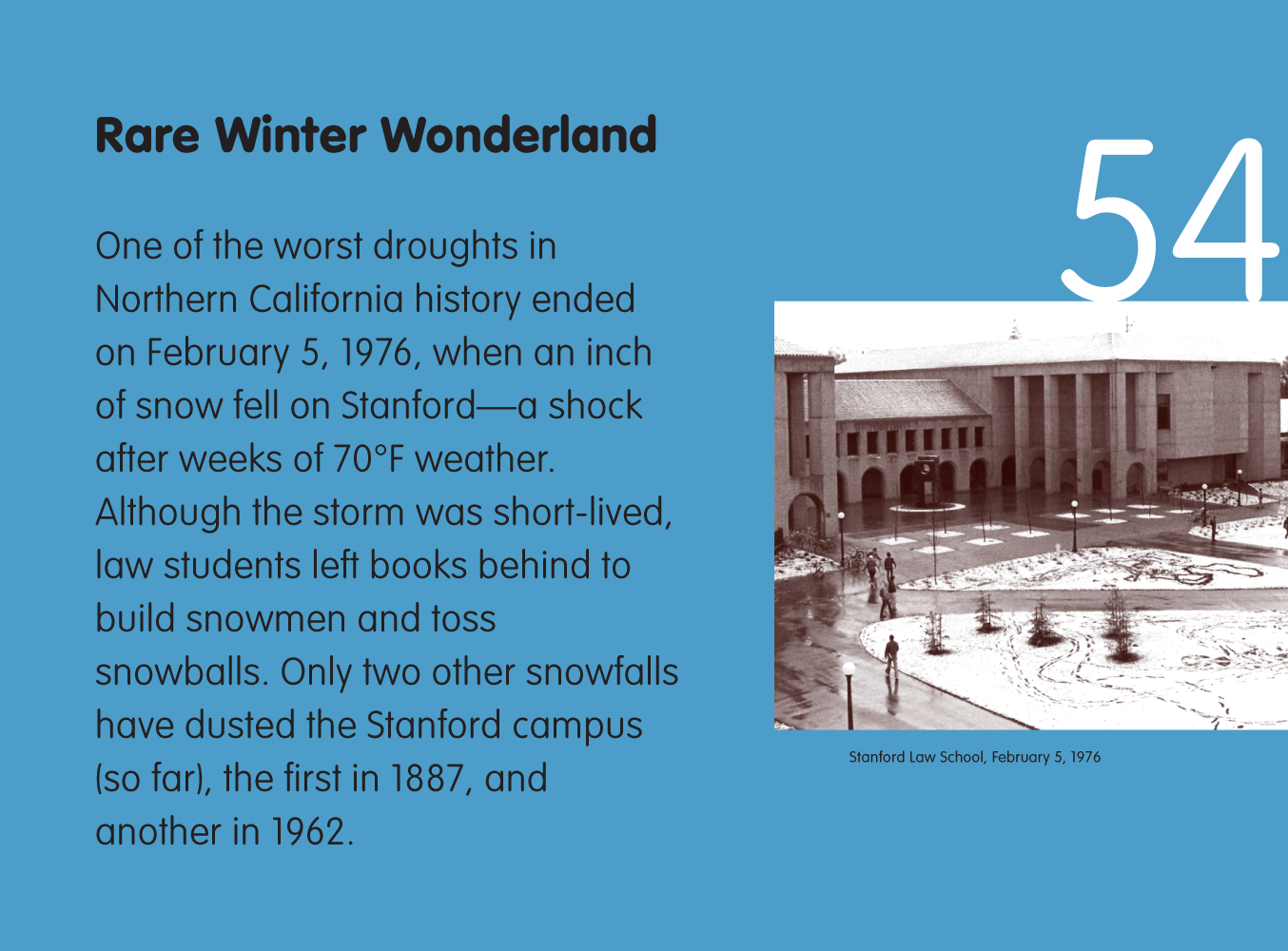
Rare Winter Wonderland
One of the worst droughts in Northern California history ended on February 5, 1976, when an inch of snow fell on Stanford—a shock after weeks of 70°F weather. Although the storm was short-lived, law students left books behind to build snowmen and toss snowballs. Only two other snowfalls have dusted the Stanford campus (so far), the first in 1887 and another in 1962.
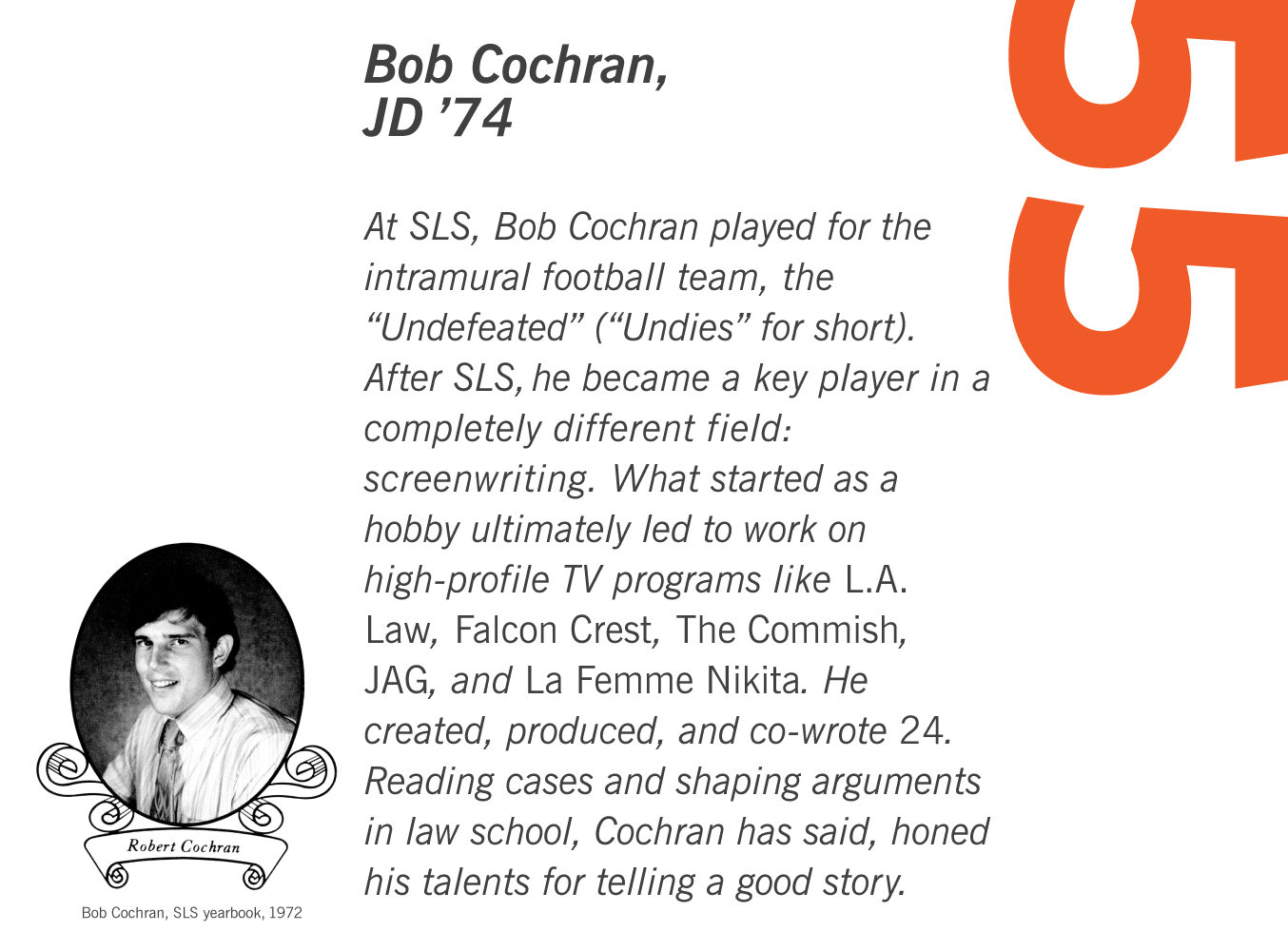
Bob Cochran, JD ‘74
At SLS, Bob Cochran played for the intramural football team, the “Undefeated” (“Undies” for short). After SLS, he became a key player in a completely different field: screenwriting. What started as a hobby ultimately led to work on high-profile TV programs like L.A. Law, Falcon Crest, The Commish, JAG,and La Femme Nikita. He created, produced, and co-wrote 24. Reading cases and shaping arguments in law school, Cochran has said, honed his talents for telling a good story.

Teaching the Teachers
In the 1990s, professors Peggy Radin, Tom Grey, and later Barbara Fried led initiatives to attract and groom more students interested in teaching law. Their efforts included a unique set of JD/PhD programs, a Legal Studies Workshop and Works-in-Progress Seminar, and conferences and programs to support junior faculty. These initiatives coincided with a nationwide shift in law school hiring priorities, in which scholarship and writing began to outweigh traditional measures of teaching potential, such as high grades and clerking experience. Stanford now equals or exceeds other top-tier law schools in the percentage of graduates who become professors of law.
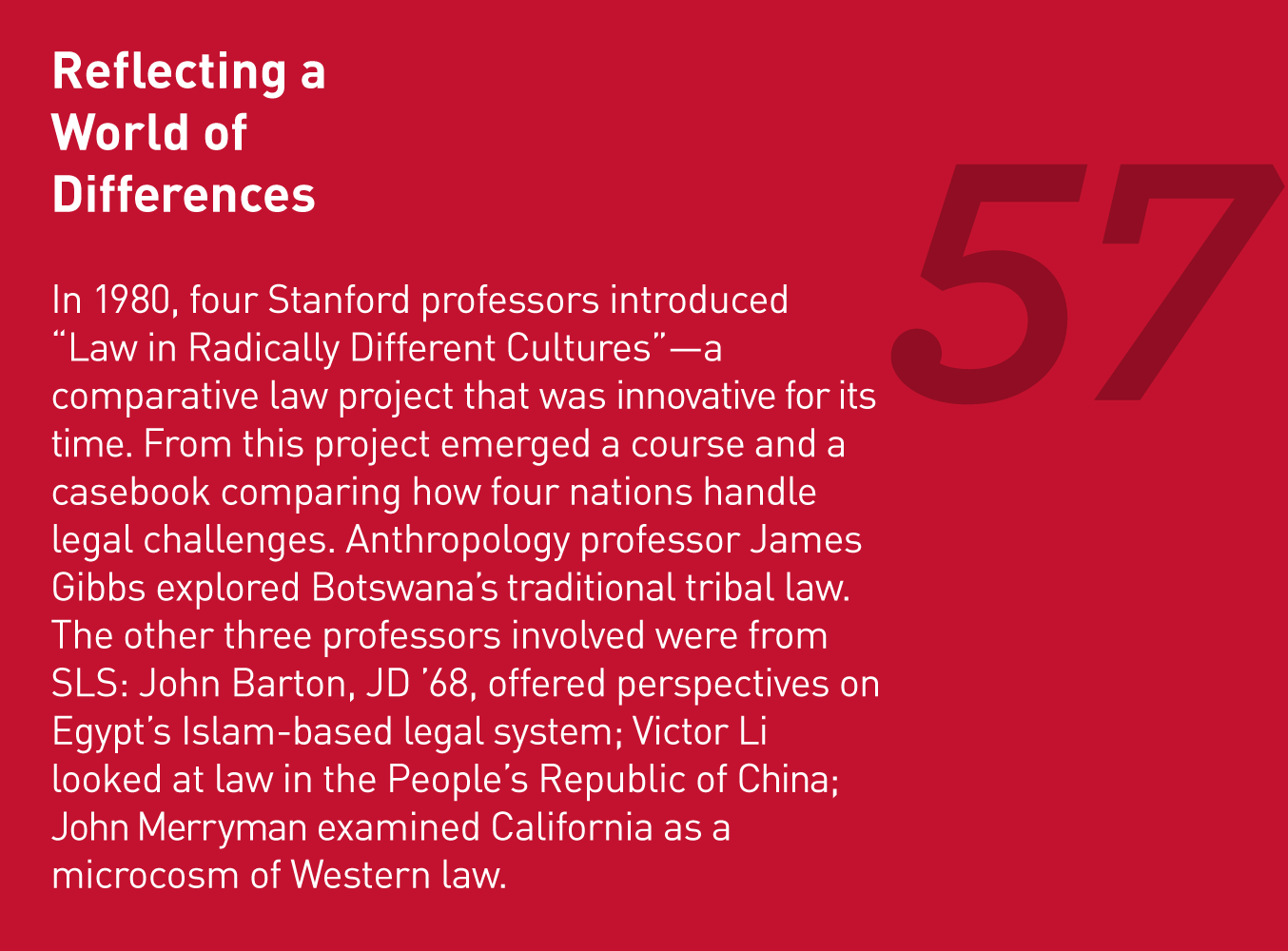
Reflecting a World of Differences
In 1980, four Stanford professors introduced Law in Radically Different Cultures—a comparative law project that was innovative for its time. From this project emerged a course and a casebook comparing how four nations handle legal challenges. Anthropology professor James Gibbs explored Botswana’s traditional tribal law. The other three professors involved were from SLS: John Barton, JD ’68, offered perspectives on Egypt’s Islam-based legal system; Victor Li looked at law in the People’s Republic of China; John Merryman examined California as a microcosm of Western law.
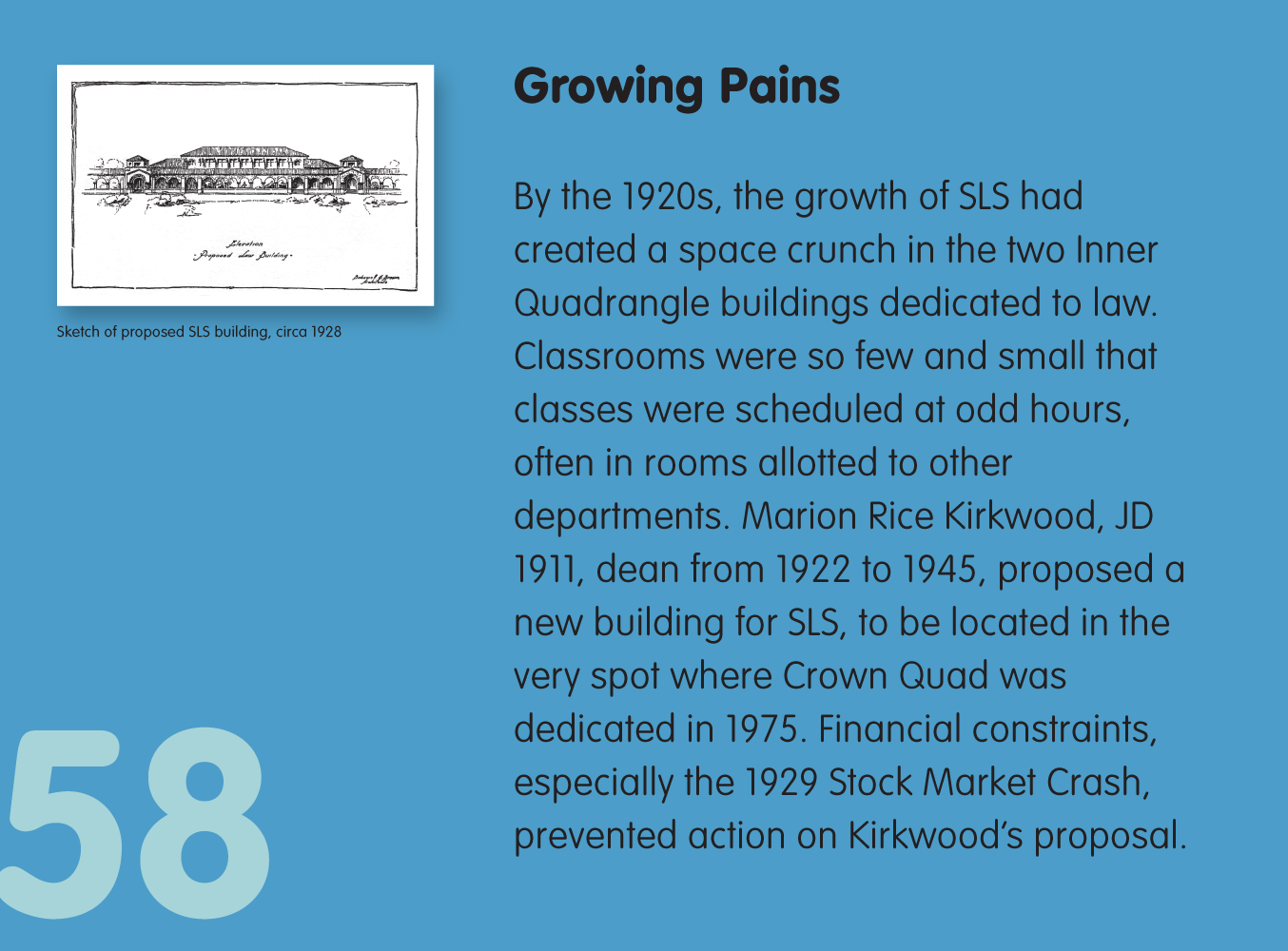
Growing Pains
By the 1920s, the growth of SLS had created a space crunch in the two Inner Quadrangle buildings dedicated to law. Classrooms were so few and small that classes were scheduled at odd hours, often in rooms allotted to other departments. Marion Rice Kirkwood, JD 1911, dean from 1922 to 1945, proposed a new building for SLS, to be located in the very spot where Crown Quad was dedicated in 1975. Financial constraints, especially the 1929 Stock Market Crash, prevented action on Kirkwood’s proposal.
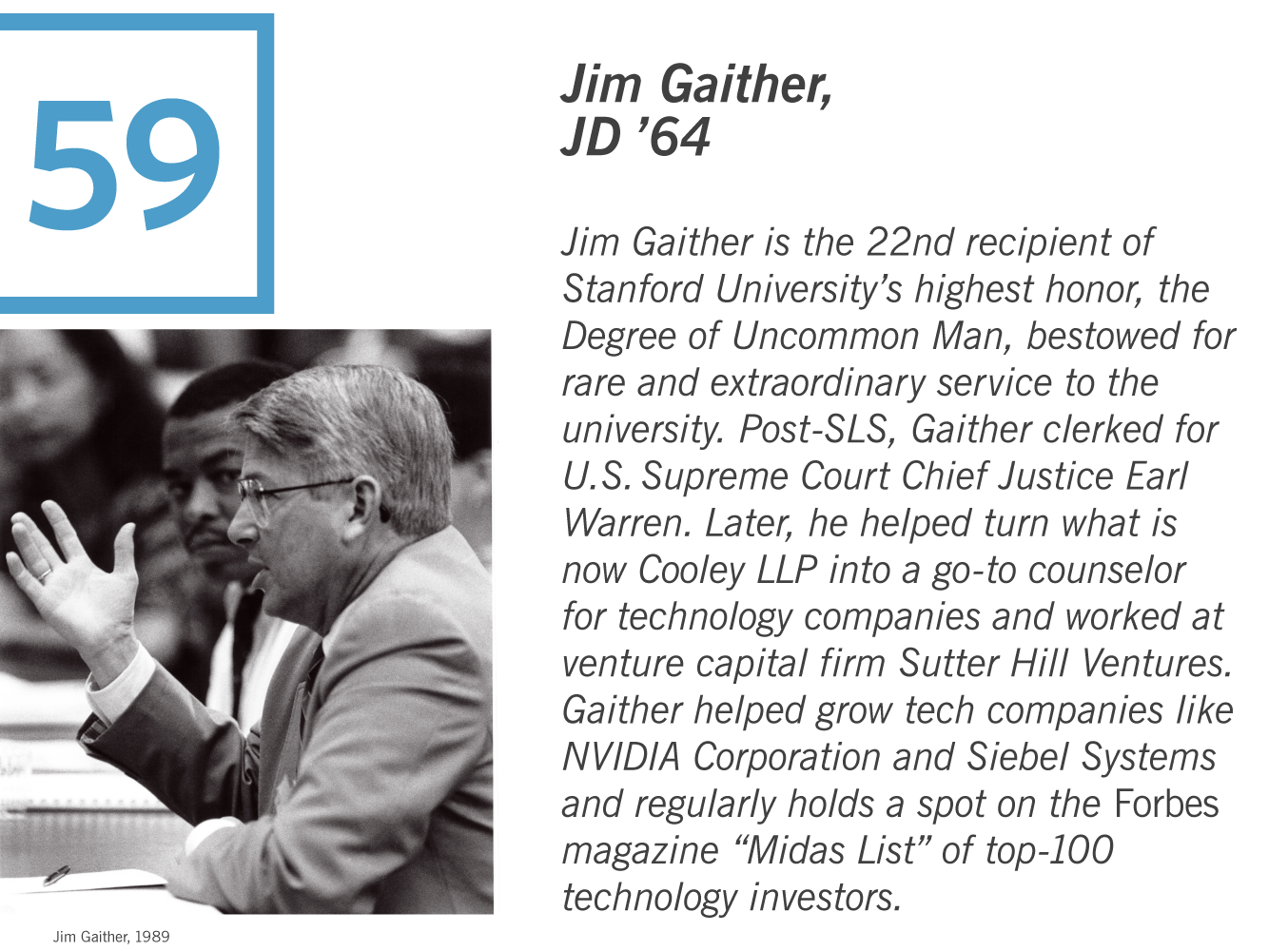
Jim Gaither, JD ’64
Jim Gaither is the 22nd recipient of Stanford University’s highest honor, the Degree of Uncommon Man, bestowed for rare and extraordinary service to the university. Post-SLS, Gaither clerked for U.S. Supreme Court Chief Justice Earl Warren. Later, he helped turn what is now Cooley LLP into a go-to counselor for technology companies, and worked at venture capital firm Sutter Hill Ventures. Gaither helped grow tech companies like NVIDIA Corporation and Siebel Systems, and regularly holds a spot on the Forbes magazine “Midas List” of top-100 technology investors.

Incubator for Lawmakers
SLS alumni who have shaped the laws of the nation include Xavier Becerra, JD ’84, U.S. Representative for California and former chair of the Hispanic Congressional Caucus. Max Baucus, LLB ’67, senior U.S. Senator from Montana, chaired the Senate Committee on Finance in 2012 and played a key role in the debate on health care reform. Jeff Bingaman, LLB ’68, senior U.S. Senator for New Mexico through 2012, served as New Mexico’s attorney general. And let’s not forget Arnold Vinick, senator from California and Republican presidential candidate on TV's The West Wing, played by Alan Alda.
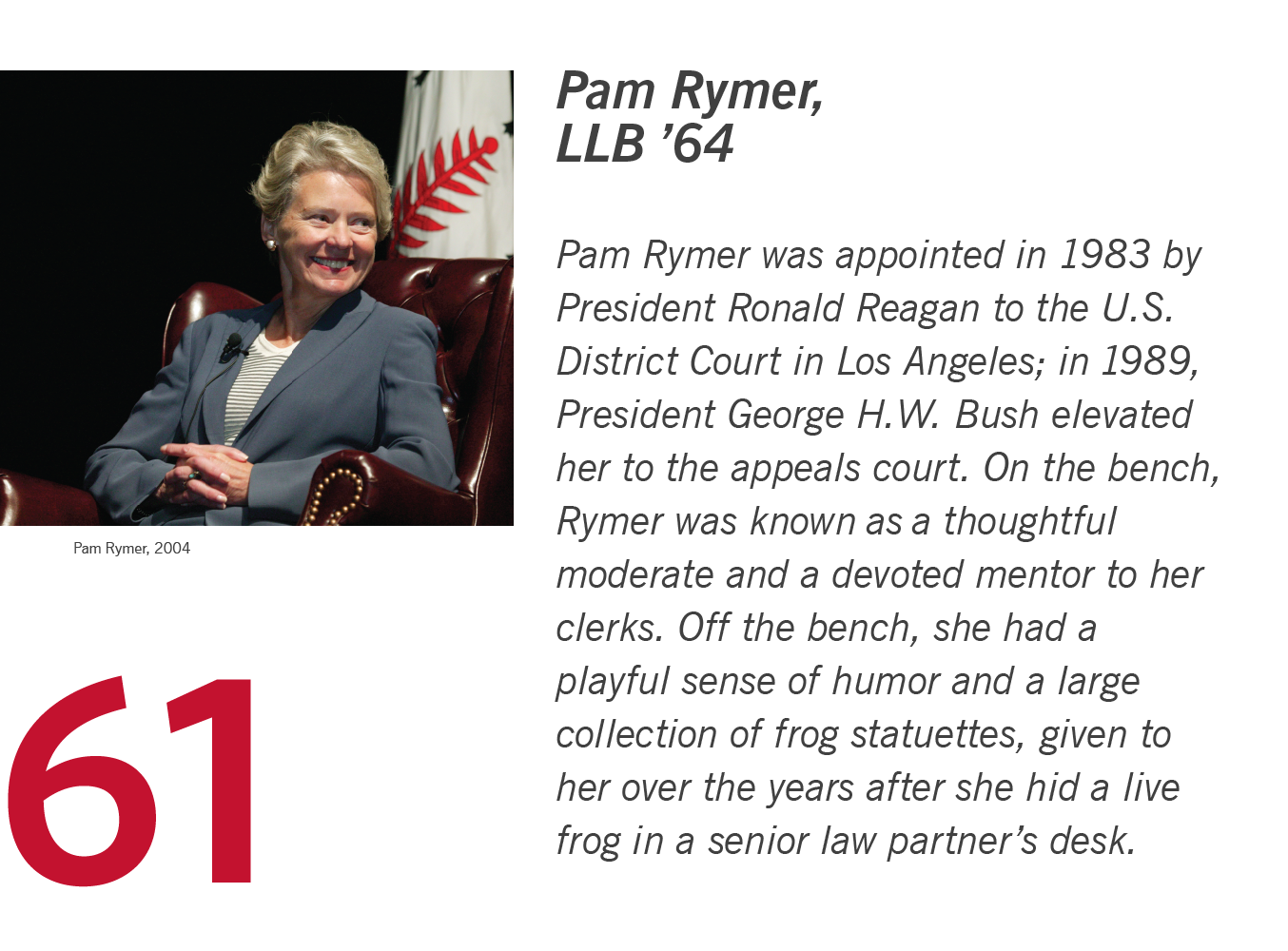
Pam Rymer, LLB ‘64
Pam Rymer was appointed in 1983 by President Ronald Reagan to the U.S. District Court in Los Angeles; in 1989, President George H.W. Bush elevated her to the appeals court. On the bench, Rymer was known as a thoughtful moderate and a devoted mentor to her clerks. Off the bench, she had a playful sense of humor and a large collection of frog statuettes, given to her over the years aft e r s h e h i d a l i v e f r o g i n a
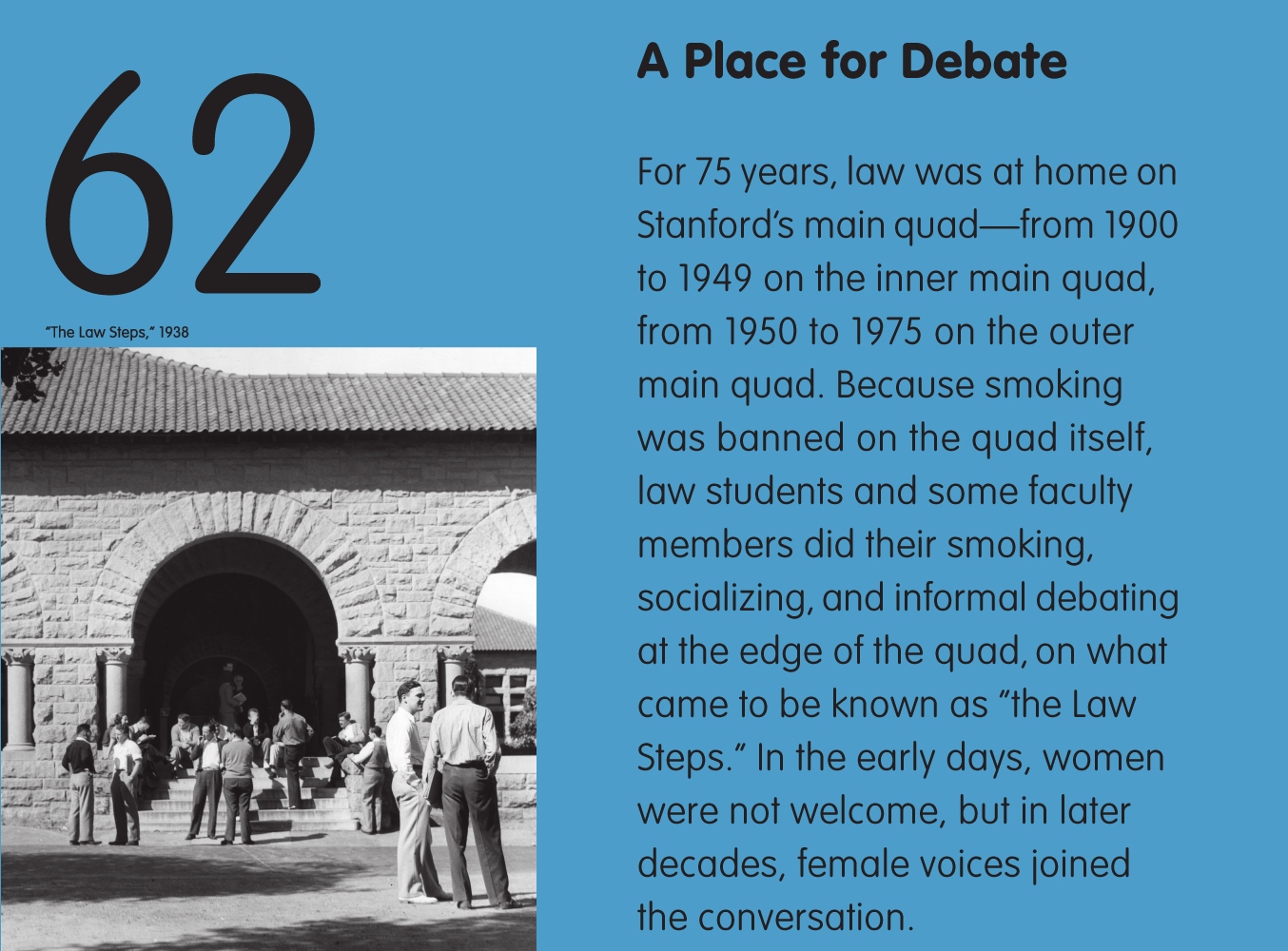
A Place for Debate
For 75 years, law was at home on Stanford’s main quad—from 1900 to 1949 on the inner main quad, from 1950 to 1975 on the outer main quad. Because smoking was banned on the quad itself, law students and some faculty members did their smoking, socializing, and informal debating at the edge of the quad, on what came to be known as “the Law Steps.” In the early days, women were not welcome, but in later decades, female voices joined the conversation.

Welcoming the World
With the goal of offering international law students a program in law studies that was both empirical and interdisciplinary, the Stanford Program in International Legal Studies welcomed its first fellows in 1995. The program is open to specially qualified academics, lawyers, judges, public officials, and other professionals trained in law outside the United States. Each fellow completes an intensive, empirical research project on a topic of concern to a particular region or to the international community as a whole.
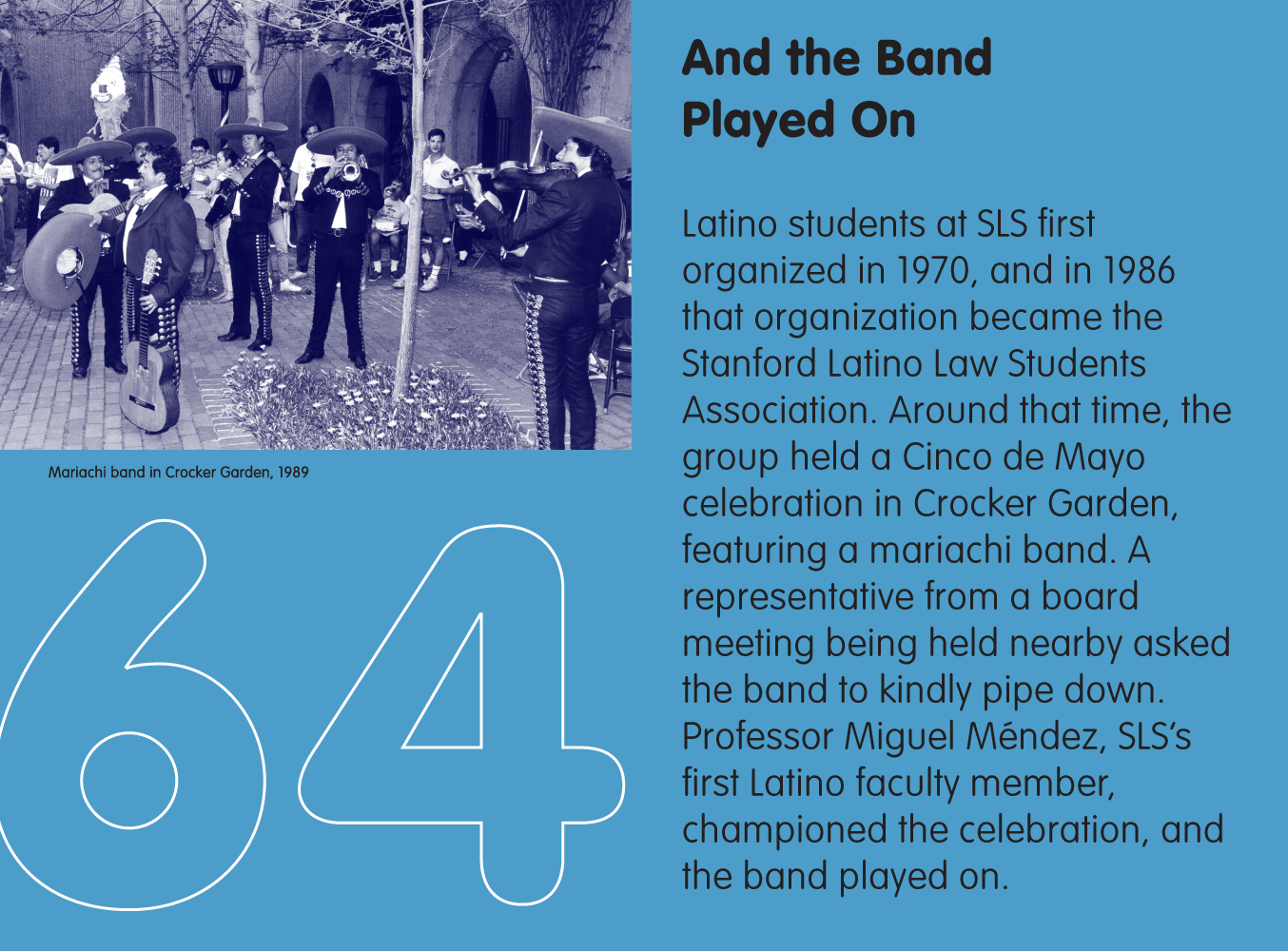
And the Band Played On
Latino students at SLS first organized in 1970, and in 1986 that organization became the Stanford Latino Law Students Association. Around that time, the group held a Cinco de Mayo celebration in Crocker Garden, featuring a mariachi band. A representative from a board meeting being held nearby asked the band to kindly pipe down. Professor Miguel Méndez, SLS’s first Latino faculty member, championed the celebration, and the band played on.
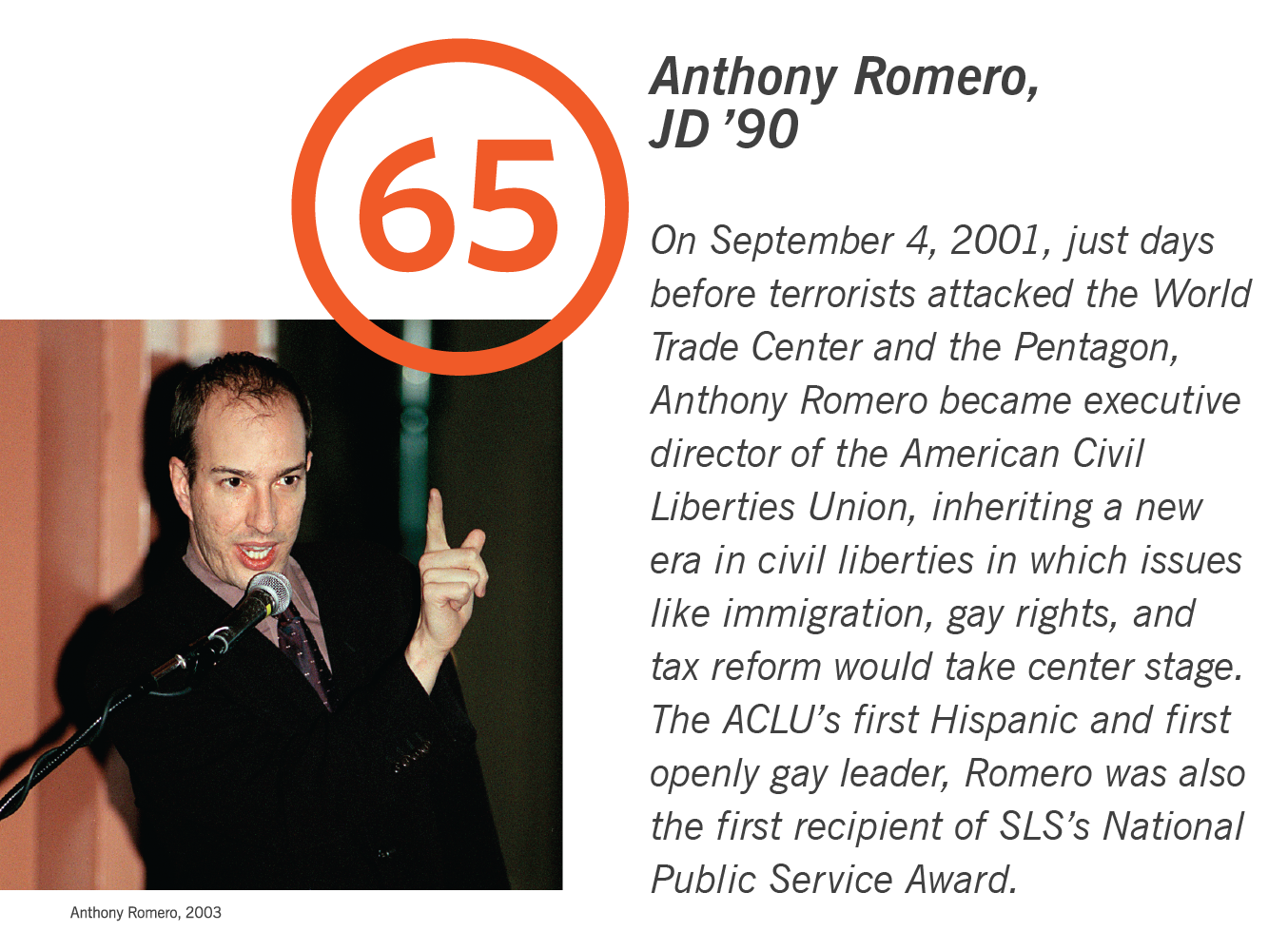
Anthony Romero, JD ’90
On September 4, 2001, just days before terrorists attacked the World Trade Center and the Pentagon, Anthony Romero became executive director of the American Civil Liberties Union, inheriting a new era in civil liberties in which issues like immigration, gay rights, and tax reform would take center stage. The ACLU’s first Hispanic and first openly gay leader, Romero was also the first recipient of SLS’s National Public Service Award.
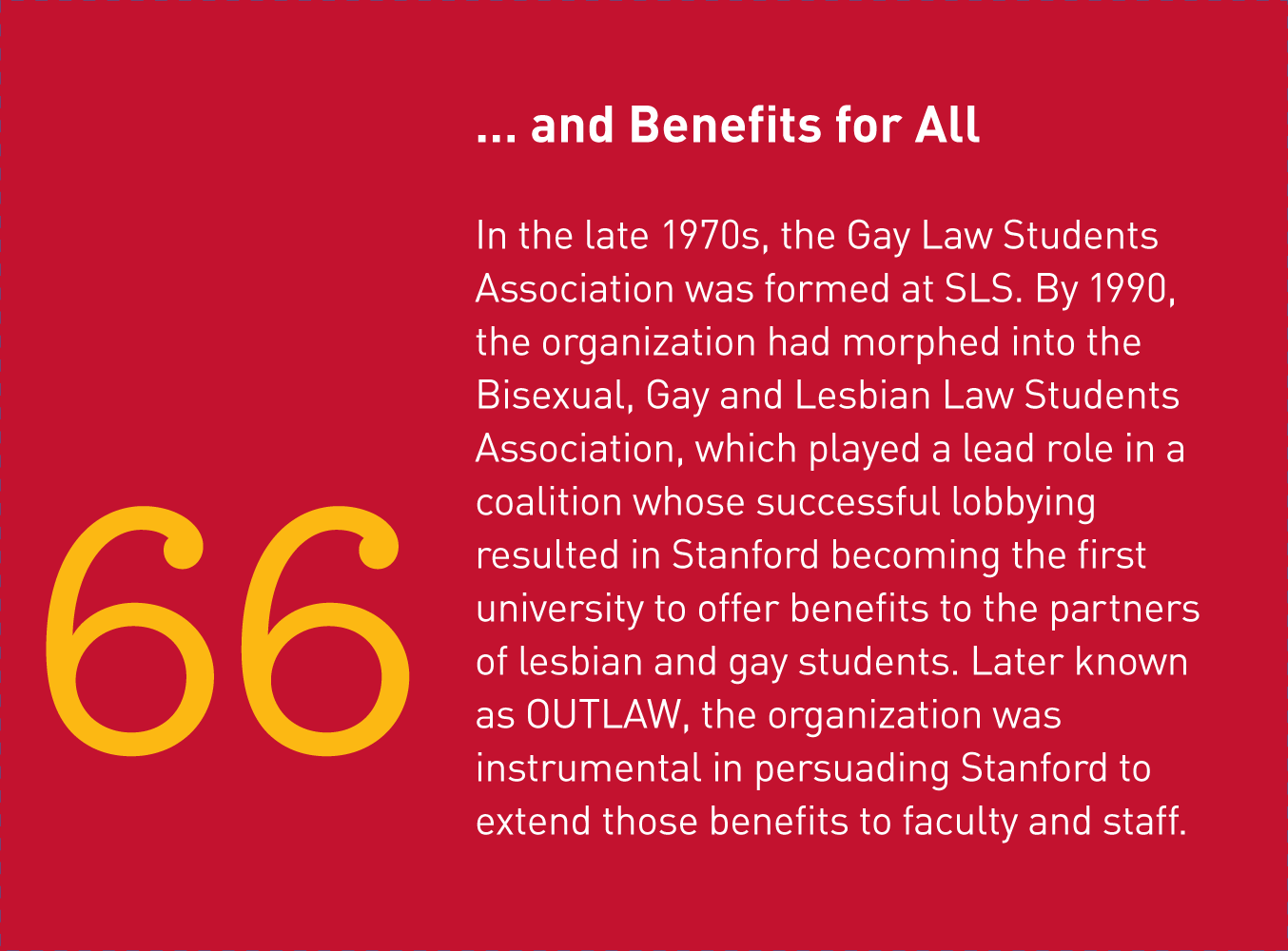
… and Benefits for All
In the late 1970s, the Gay Law Students Association was formed at SLS. By 1990, the organization had morphed into the Bisexual, Gay and Lesbian Law Students Association, which played a lead role in a coalition whose successful lobbying resulted in Stanford becoming the first university to offer benefits to the partners of lesbian and gay students. Later known as OUTLAW, the organization was instrumental in persuading Stanford to extend those benefits to faculty and staff.
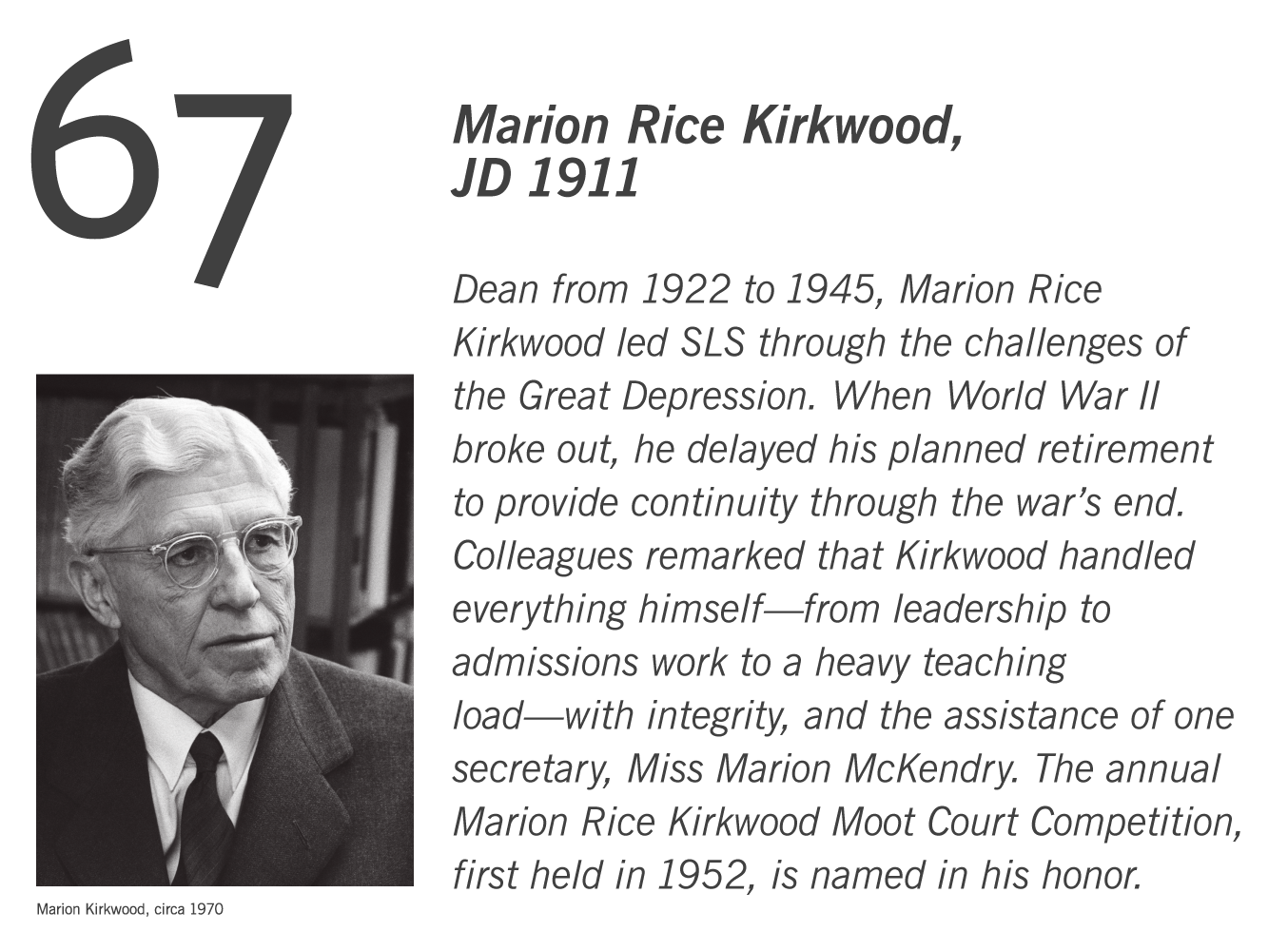
Marion Rice Kirkwood, JD 1911
Dean from 1922 to 1945, Marion Rice Kirkwood led SLS through the challenges of the Great Depression. When World War II broke out, he delayed his planned retirement to provide continuity through the war’s end. Colleagues remarked that Kirkwood handled everything himself—from leadership to admissions work to a heavy teaching load—with integrity, and the assistance of one secretary, Miss Marion McKendry. The annual Marion Rice Kirkwood Moot Court Competition, first held in 1952, is named in his honor.
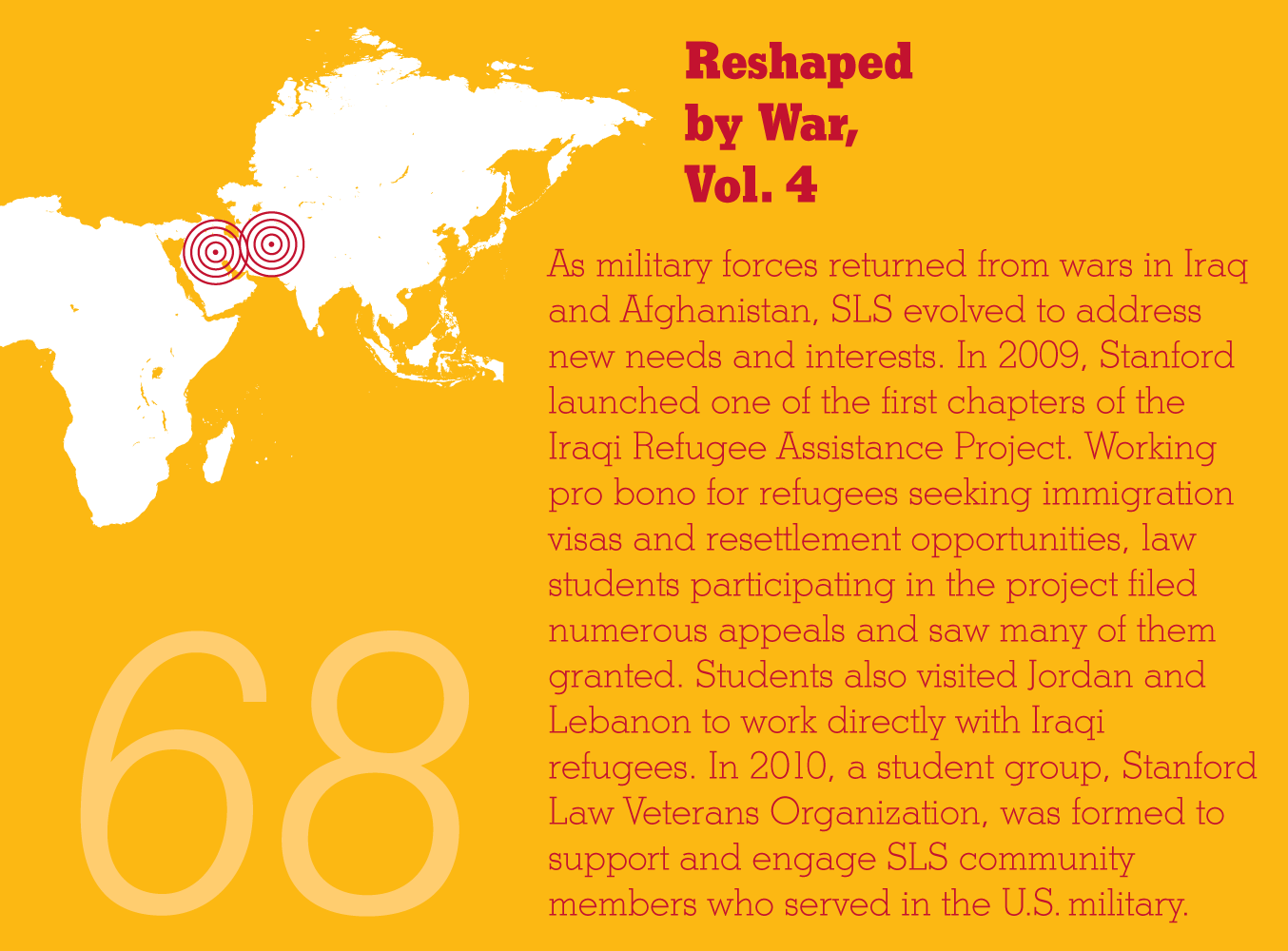
Reshaped by War, Vol. 4
As military forces returned from wars in Iraq and Afghanistan, SLS evolved to address new needs and interests. In 2009, Stanford launched one of the first chapters of the Iraqi Refugee Assistance Project. Working pro bono for refugees seeking immigration visas and resettlement opportunities, law students participating in the project filed numerous appeals and saw many of them granted. Students also visited Jordan and Lebanon to work directly with Iraqi refugees. In 2010, a student group, Stanford Law Veterans Organization, was formed to support and engage SLS community members who served in the U.S. military.

